Information Technology Problems and Solutions for Small Businesses
VerifiedAdded on 2023/06/13
|49
|11580
|338
AI Summary
This paper discusses about the concept of information technology in the small business. The benefits of adoption of information technology in the small businesses have been discussed in the study. The aim of the research s to identify the problems of information technology in the small businesses and recommending its strategies.
Contribute Materials
Your contribution can guide someone’s learning journey. Share your
documents today.
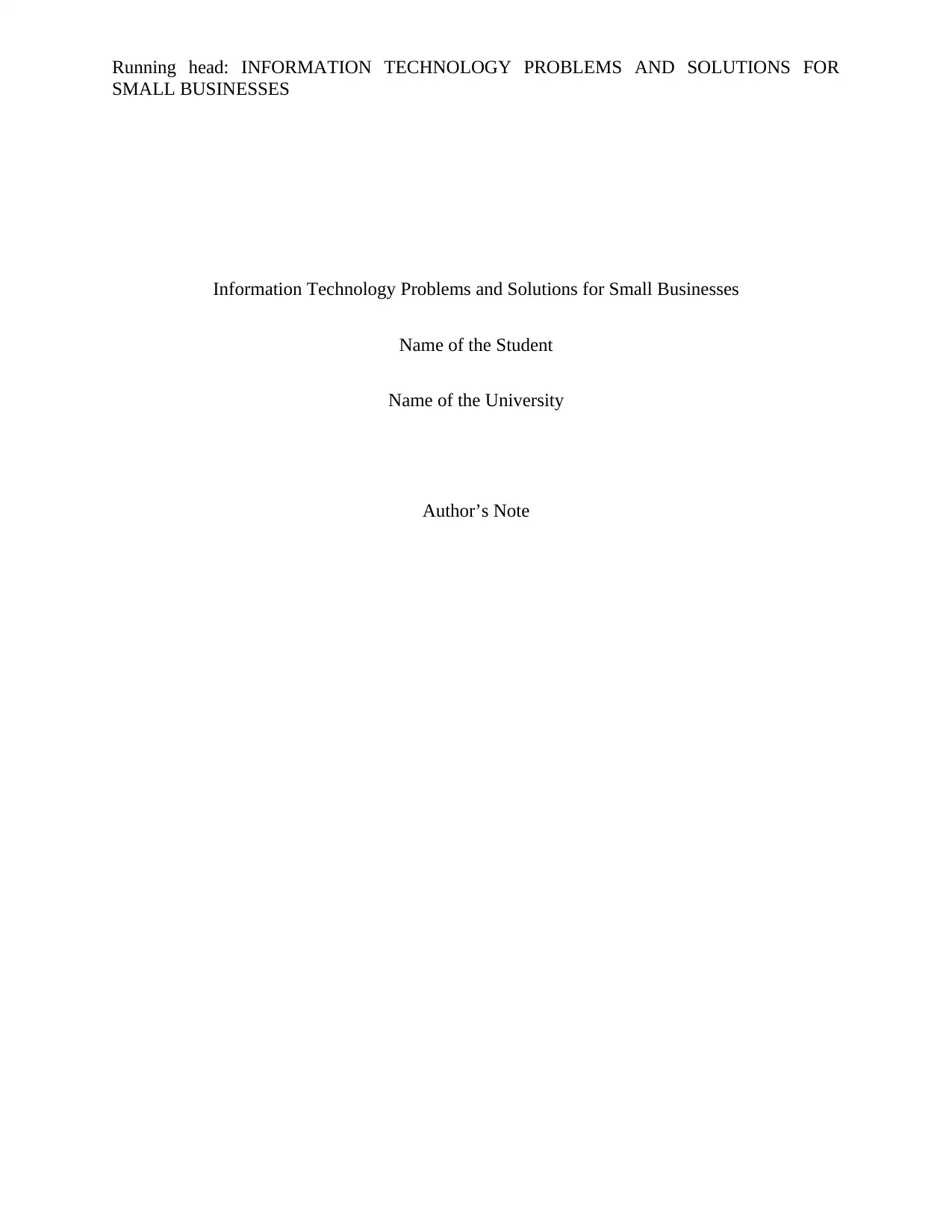
Running head: INFORMATION TECHNOLOGY PROBLEMS AND SOLUTIONS FOR
SMALL BUSINESSES
Information Technology Problems and Solutions for Small Businesses
Name of the Student
Name of the University
Author’s Note
SMALL BUSINESSES
Information Technology Problems and Solutions for Small Businesses
Name of the Student
Name of the University
Author’s Note
Secure Best Marks with AI Grader
Need help grading? Try our AI Grader for instant feedback on your assignments.
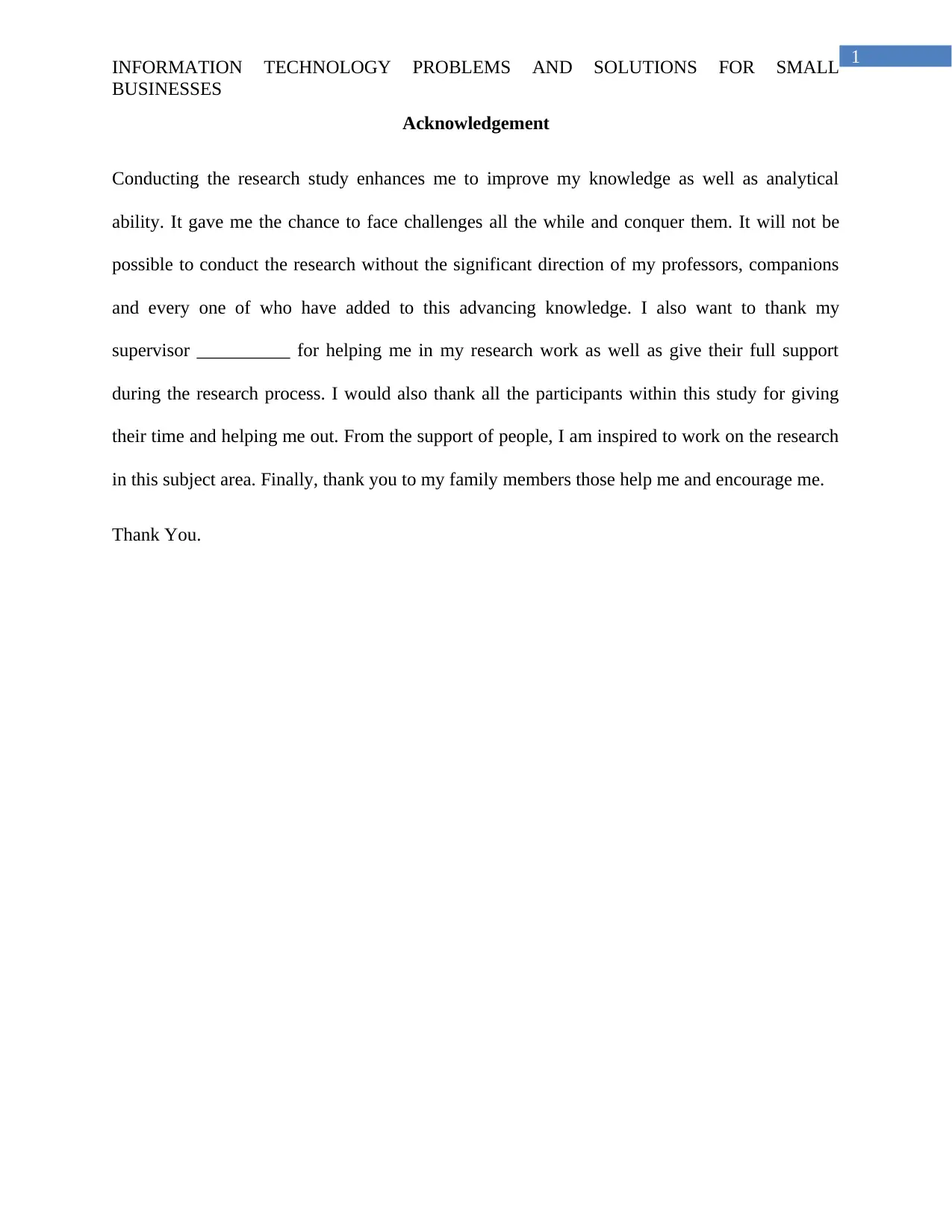
1
INFORMATION TECHNOLOGY PROBLEMS AND SOLUTIONS FOR SMALL
BUSINESSES
Acknowledgement
Conducting the research study enhances me to improve my knowledge as well as analytical
ability. It gave me the chance to face challenges all the while and conquer them. It will not be
possible to conduct the research without the significant direction of my professors, companions
and every one of who have added to this advancing knowledge. I also want to thank my
supervisor __________ for helping me in my research work as well as give their full support
during the research process. I would also thank all the participants within this study for giving
their time and helping me out. From the support of people, I am inspired to work on the research
in this subject area. Finally, thank you to my family members those help me and encourage me.
Thank You.
INFORMATION TECHNOLOGY PROBLEMS AND SOLUTIONS FOR SMALL
BUSINESSES
Acknowledgement
Conducting the research study enhances me to improve my knowledge as well as analytical
ability. It gave me the chance to face challenges all the while and conquer them. It will not be
possible to conduct the research without the significant direction of my professors, companions
and every one of who have added to this advancing knowledge. I also want to thank my
supervisor __________ for helping me in my research work as well as give their full support
during the research process. I would also thank all the participants within this study for giving
their time and helping me out. From the support of people, I am inspired to work on the research
in this subject area. Finally, thank you to my family members those help me and encourage me.
Thank You.
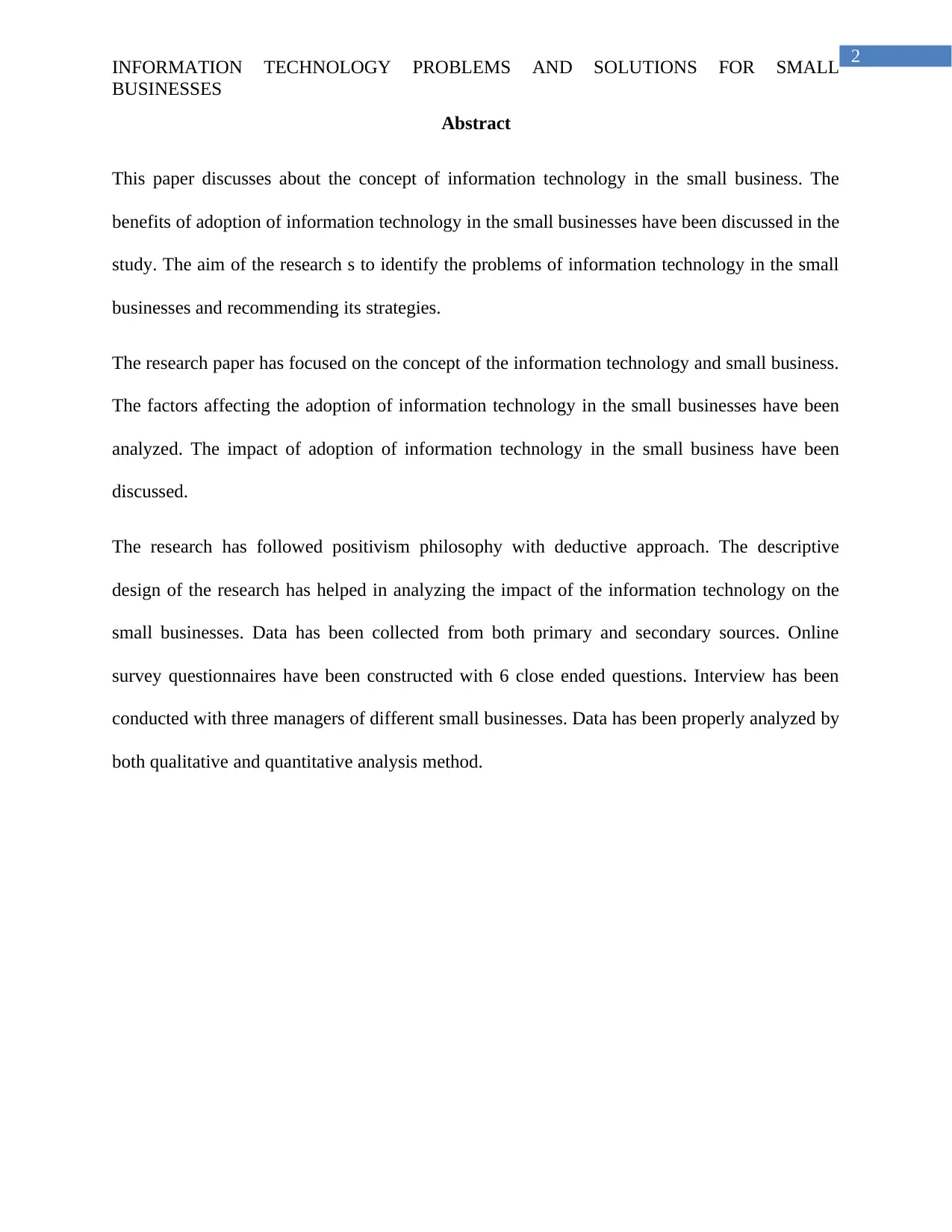
2
INFORMATION TECHNOLOGY PROBLEMS AND SOLUTIONS FOR SMALL
BUSINESSES
Abstract
This paper discusses about the concept of information technology in the small business. The
benefits of adoption of information technology in the small businesses have been discussed in the
study. The aim of the research s to identify the problems of information technology in the small
businesses and recommending its strategies.
The research paper has focused on the concept of the information technology and small business.
The factors affecting the adoption of information technology in the small businesses have been
analyzed. The impact of adoption of information technology in the small business have been
discussed.
The research has followed positivism philosophy with deductive approach. The descriptive
design of the research has helped in analyzing the impact of the information technology on the
small businesses. Data has been collected from both primary and secondary sources. Online
survey questionnaires have been constructed with 6 close ended questions. Interview has been
conducted with three managers of different small businesses. Data has been properly analyzed by
both qualitative and quantitative analysis method.
INFORMATION TECHNOLOGY PROBLEMS AND SOLUTIONS FOR SMALL
BUSINESSES
Abstract
This paper discusses about the concept of information technology in the small business. The
benefits of adoption of information technology in the small businesses have been discussed in the
study. The aim of the research s to identify the problems of information technology in the small
businesses and recommending its strategies.
The research paper has focused on the concept of the information technology and small business.
The factors affecting the adoption of information technology in the small businesses have been
analyzed. The impact of adoption of information technology in the small business have been
discussed.
The research has followed positivism philosophy with deductive approach. The descriptive
design of the research has helped in analyzing the impact of the information technology on the
small businesses. Data has been collected from both primary and secondary sources. Online
survey questionnaires have been constructed with 6 close ended questions. Interview has been
conducted with three managers of different small businesses. Data has been properly analyzed by
both qualitative and quantitative analysis method.
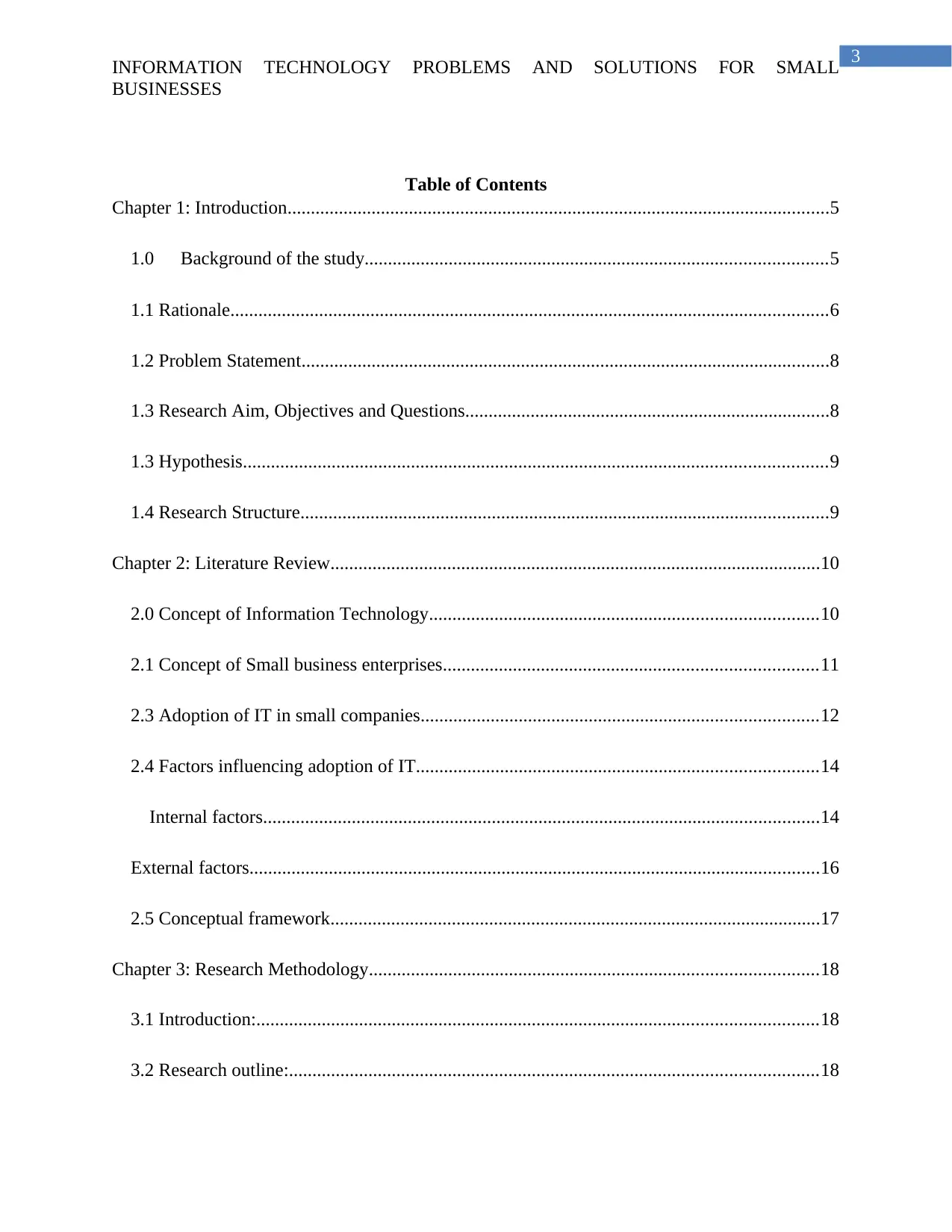
3
INFORMATION TECHNOLOGY PROBLEMS AND SOLUTIONS FOR SMALL
BUSINESSES
Table of Contents
Chapter 1: Introduction....................................................................................................................5
1.0 Background of the study...................................................................................................5
1.1 Rationale................................................................................................................................6
1.2 Problem Statement.................................................................................................................8
1.3 Research Aim, Objectives and Questions..............................................................................8
1.3 Hypothesis.............................................................................................................................9
1.4 Research Structure.................................................................................................................9
Chapter 2: Literature Review.........................................................................................................10
2.0 Concept of Information Technology...................................................................................10
2.1 Concept of Small business enterprises................................................................................11
2.3 Adoption of IT in small companies.....................................................................................12
2.4 Factors influencing adoption of IT......................................................................................14
Internal factors.......................................................................................................................14
External factors..........................................................................................................................16
2.5 Conceptual framework.........................................................................................................17
Chapter 3: Research Methodology................................................................................................18
3.1 Introduction:........................................................................................................................18
3.2 Research outline:.................................................................................................................18
INFORMATION TECHNOLOGY PROBLEMS AND SOLUTIONS FOR SMALL
BUSINESSES
Table of Contents
Chapter 1: Introduction....................................................................................................................5
1.0 Background of the study...................................................................................................5
1.1 Rationale................................................................................................................................6
1.2 Problem Statement.................................................................................................................8
1.3 Research Aim, Objectives and Questions..............................................................................8
1.3 Hypothesis.............................................................................................................................9
1.4 Research Structure.................................................................................................................9
Chapter 2: Literature Review.........................................................................................................10
2.0 Concept of Information Technology...................................................................................10
2.1 Concept of Small business enterprises................................................................................11
2.3 Adoption of IT in small companies.....................................................................................12
2.4 Factors influencing adoption of IT......................................................................................14
Internal factors.......................................................................................................................14
External factors..........................................................................................................................16
2.5 Conceptual framework.........................................................................................................17
Chapter 3: Research Methodology................................................................................................18
3.1 Introduction:........................................................................................................................18
3.2 Research outline:.................................................................................................................18
Secure Best Marks with AI Grader
Need help grading? Try our AI Grader for instant feedback on your assignments.
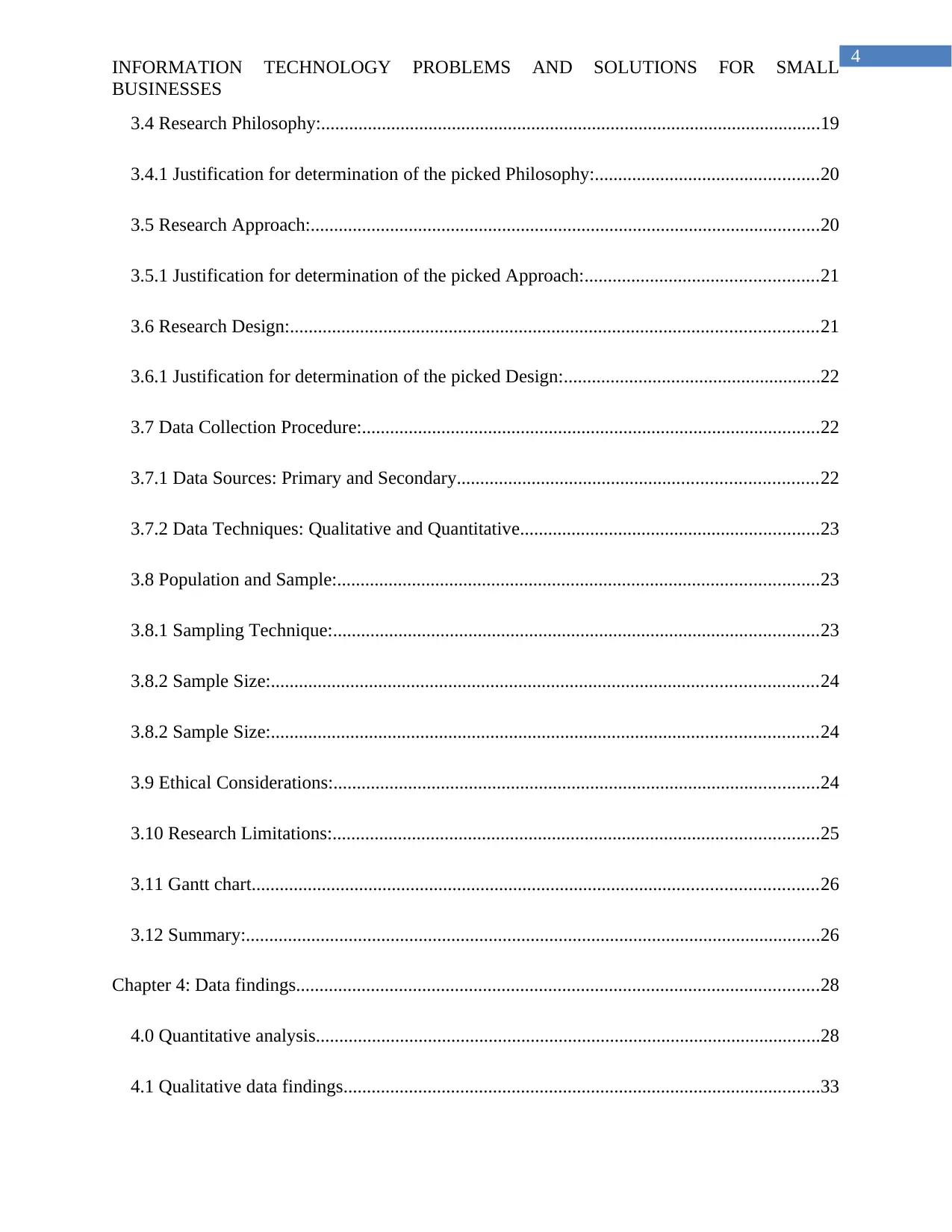
4
INFORMATION TECHNOLOGY PROBLEMS AND SOLUTIONS FOR SMALL
BUSINESSES
3.4 Research Philosophy:...........................................................................................................19
3.4.1 Justification for determination of the picked Philosophy:................................................20
3.5 Research Approach:.............................................................................................................20
3.5.1 Justification for determination of the picked Approach:..................................................21
3.6 Research Design:.................................................................................................................21
3.6.1 Justification for determination of the picked Design:.......................................................22
3.7 Data Collection Procedure:..................................................................................................22
3.7.1 Data Sources: Primary and Secondary.............................................................................22
3.7.2 Data Techniques: Qualitative and Quantitative................................................................23
3.8 Population and Sample:.......................................................................................................23
3.8.1 Sampling Technique:........................................................................................................23
3.8.2 Sample Size:.....................................................................................................................24
3.8.2 Sample Size:.....................................................................................................................24
3.9 Ethical Considerations:........................................................................................................24
3.10 Research Limitations:........................................................................................................25
3.11 Gantt chart.........................................................................................................................26
3.12 Summary:...........................................................................................................................26
Chapter 4: Data findings................................................................................................................28
4.0 Quantitative analysis............................................................................................................28
4.1 Qualitative data findings......................................................................................................33
INFORMATION TECHNOLOGY PROBLEMS AND SOLUTIONS FOR SMALL
BUSINESSES
3.4 Research Philosophy:...........................................................................................................19
3.4.1 Justification for determination of the picked Philosophy:................................................20
3.5 Research Approach:.............................................................................................................20
3.5.1 Justification for determination of the picked Approach:..................................................21
3.6 Research Design:.................................................................................................................21
3.6.1 Justification for determination of the picked Design:.......................................................22
3.7 Data Collection Procedure:..................................................................................................22
3.7.1 Data Sources: Primary and Secondary.............................................................................22
3.7.2 Data Techniques: Qualitative and Quantitative................................................................23
3.8 Population and Sample:.......................................................................................................23
3.8.1 Sampling Technique:........................................................................................................23
3.8.2 Sample Size:.....................................................................................................................24
3.8.2 Sample Size:.....................................................................................................................24
3.9 Ethical Considerations:........................................................................................................24
3.10 Research Limitations:........................................................................................................25
3.11 Gantt chart.........................................................................................................................26
3.12 Summary:...........................................................................................................................26
Chapter 4: Data findings................................................................................................................28
4.0 Quantitative analysis............................................................................................................28
4.1 Qualitative data findings......................................................................................................33
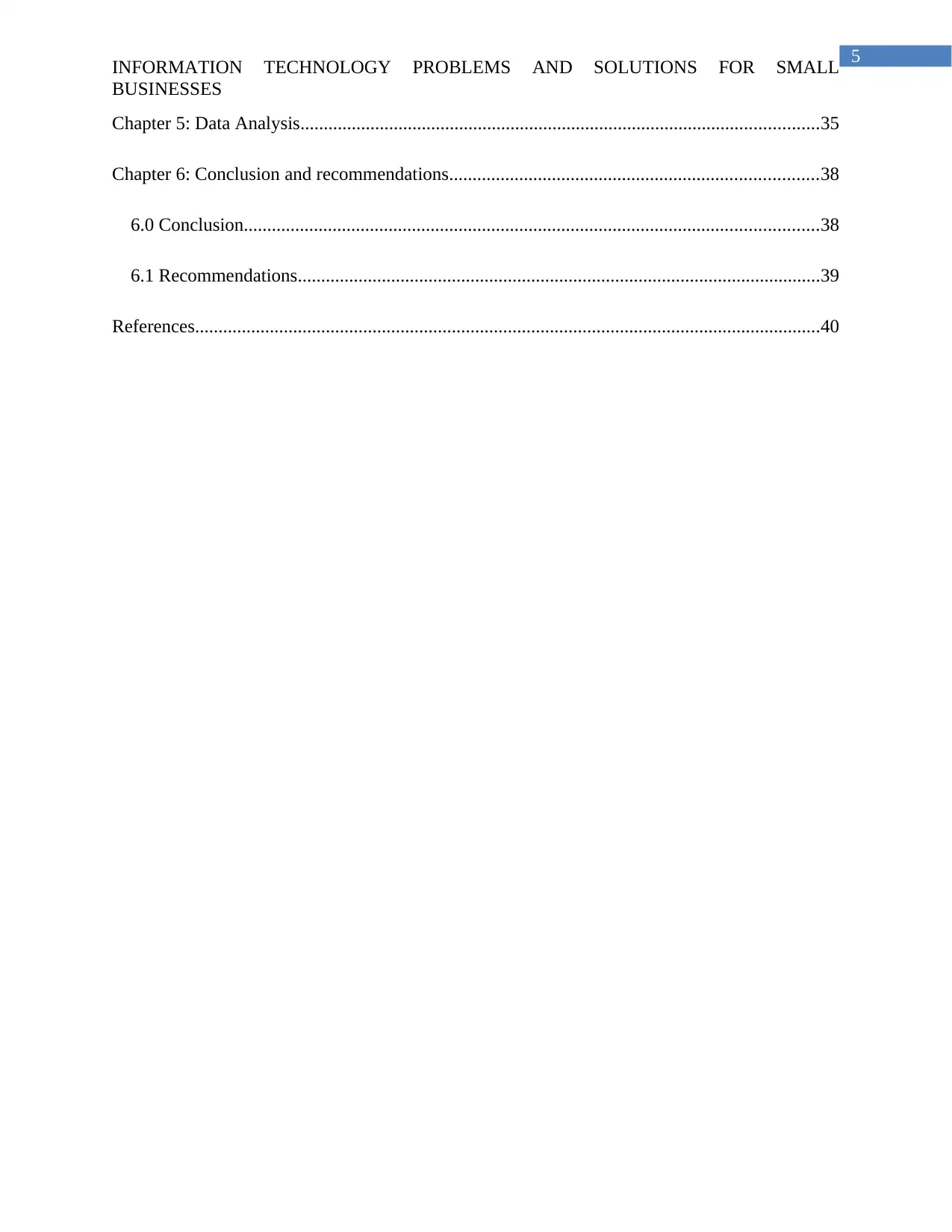
5
INFORMATION TECHNOLOGY PROBLEMS AND SOLUTIONS FOR SMALL
BUSINESSES
Chapter 5: Data Analysis...............................................................................................................35
Chapter 6: Conclusion and recommendations...............................................................................38
6.0 Conclusion...........................................................................................................................38
6.1 Recommendations................................................................................................................39
References......................................................................................................................................40
INFORMATION TECHNOLOGY PROBLEMS AND SOLUTIONS FOR SMALL
BUSINESSES
Chapter 5: Data Analysis...............................................................................................................35
Chapter 6: Conclusion and recommendations...............................................................................38
6.0 Conclusion...........................................................................................................................38
6.1 Recommendations................................................................................................................39
References......................................................................................................................................40
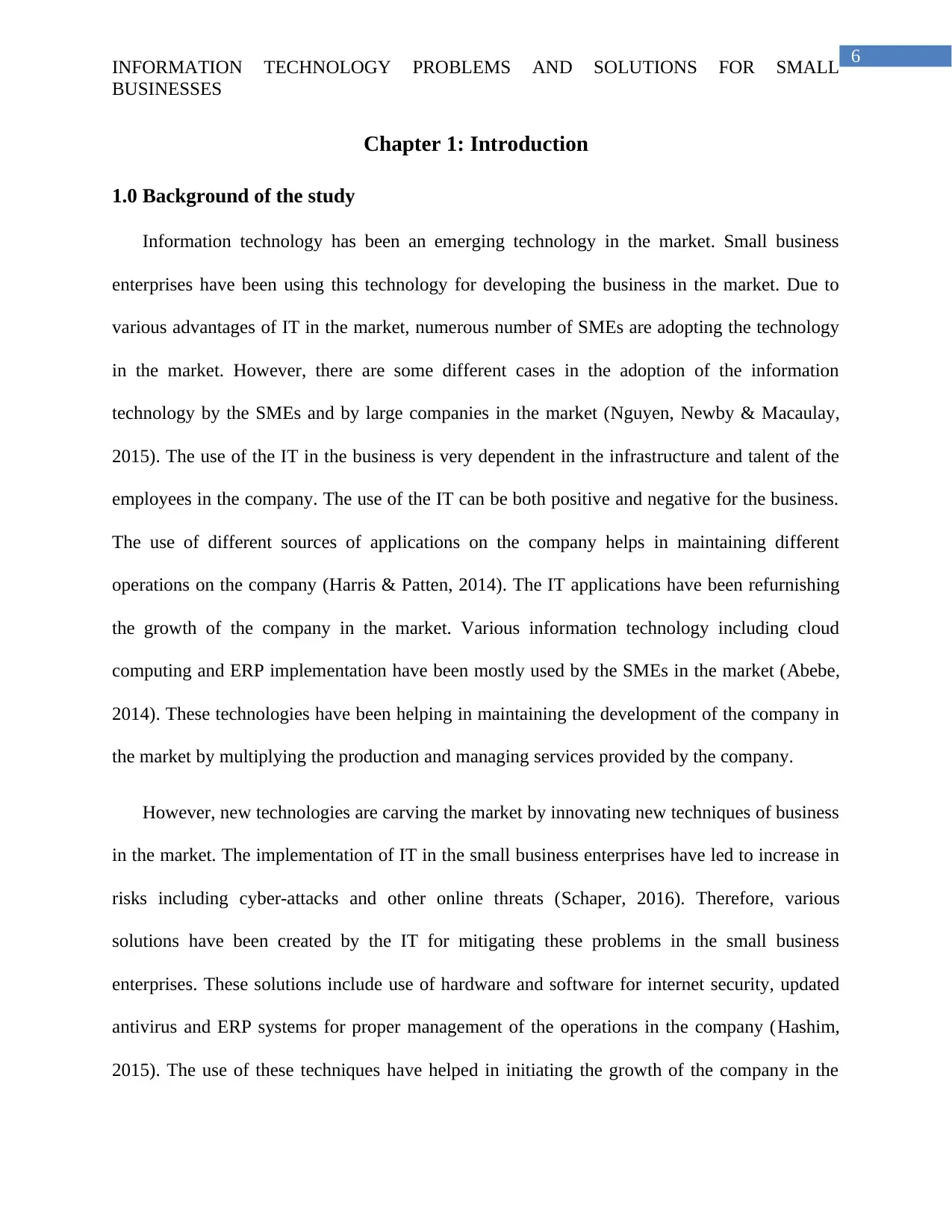
6
INFORMATION TECHNOLOGY PROBLEMS AND SOLUTIONS FOR SMALL
BUSINESSES
Chapter 1: Introduction
1.0 Background of the study
Information technology has been an emerging technology in the market. Small business
enterprises have been using this technology for developing the business in the market. Due to
various advantages of IT in the market, numerous number of SMEs are adopting the technology
in the market. However, there are some different cases in the adoption of the information
technology by the SMEs and by large companies in the market (Nguyen, Newby & Macaulay,
2015). The use of the IT in the business is very dependent in the infrastructure and talent of the
employees in the company. The use of the IT can be both positive and negative for the business.
The use of different sources of applications on the company helps in maintaining different
operations on the company (Harris & Patten, 2014). The IT applications have been refurnishing
the growth of the company in the market. Various information technology including cloud
computing and ERP implementation have been mostly used by the SMEs in the market (Abebe,
2014). These technologies have been helping in maintaining the development of the company in
the market by multiplying the production and managing services provided by the company.
However, new technologies are carving the market by innovating new techniques of business
in the market. The implementation of IT in the small business enterprises have led to increase in
risks including cyber-attacks and other online threats (Schaper, 2016). Therefore, various
solutions have been created by the IT for mitigating these problems in the small business
enterprises. These solutions include use of hardware and software for internet security, updated
antivirus and ERP systems for proper management of the operations in the company (Hashim,
2015). The use of these techniques have helped in initiating the growth of the company in the
INFORMATION TECHNOLOGY PROBLEMS AND SOLUTIONS FOR SMALL
BUSINESSES
Chapter 1: Introduction
1.0 Background of the study
Information technology has been an emerging technology in the market. Small business
enterprises have been using this technology for developing the business in the market. Due to
various advantages of IT in the market, numerous number of SMEs are adopting the technology
in the market. However, there are some different cases in the adoption of the information
technology by the SMEs and by large companies in the market (Nguyen, Newby & Macaulay,
2015). The use of the IT in the business is very dependent in the infrastructure and talent of the
employees in the company. The use of the IT can be both positive and negative for the business.
The use of different sources of applications on the company helps in maintaining different
operations on the company (Harris & Patten, 2014). The IT applications have been refurnishing
the growth of the company in the market. Various information technology including cloud
computing and ERP implementation have been mostly used by the SMEs in the market (Abebe,
2014). These technologies have been helping in maintaining the development of the company in
the market by multiplying the production and managing services provided by the company.
However, new technologies are carving the market by innovating new techniques of business
in the market. The implementation of IT in the small business enterprises have led to increase in
risks including cyber-attacks and other online threats (Schaper, 2016). Therefore, various
solutions have been created by the IT for mitigating these problems in the small business
enterprises. These solutions include use of hardware and software for internet security, updated
antivirus and ERP systems for proper management of the operations in the company (Hashim,
2015). The use of these techniques have helped in initiating the growth of the company in the
Paraphrase This Document
Need a fresh take? Get an instant paraphrase of this document with our AI Paraphraser
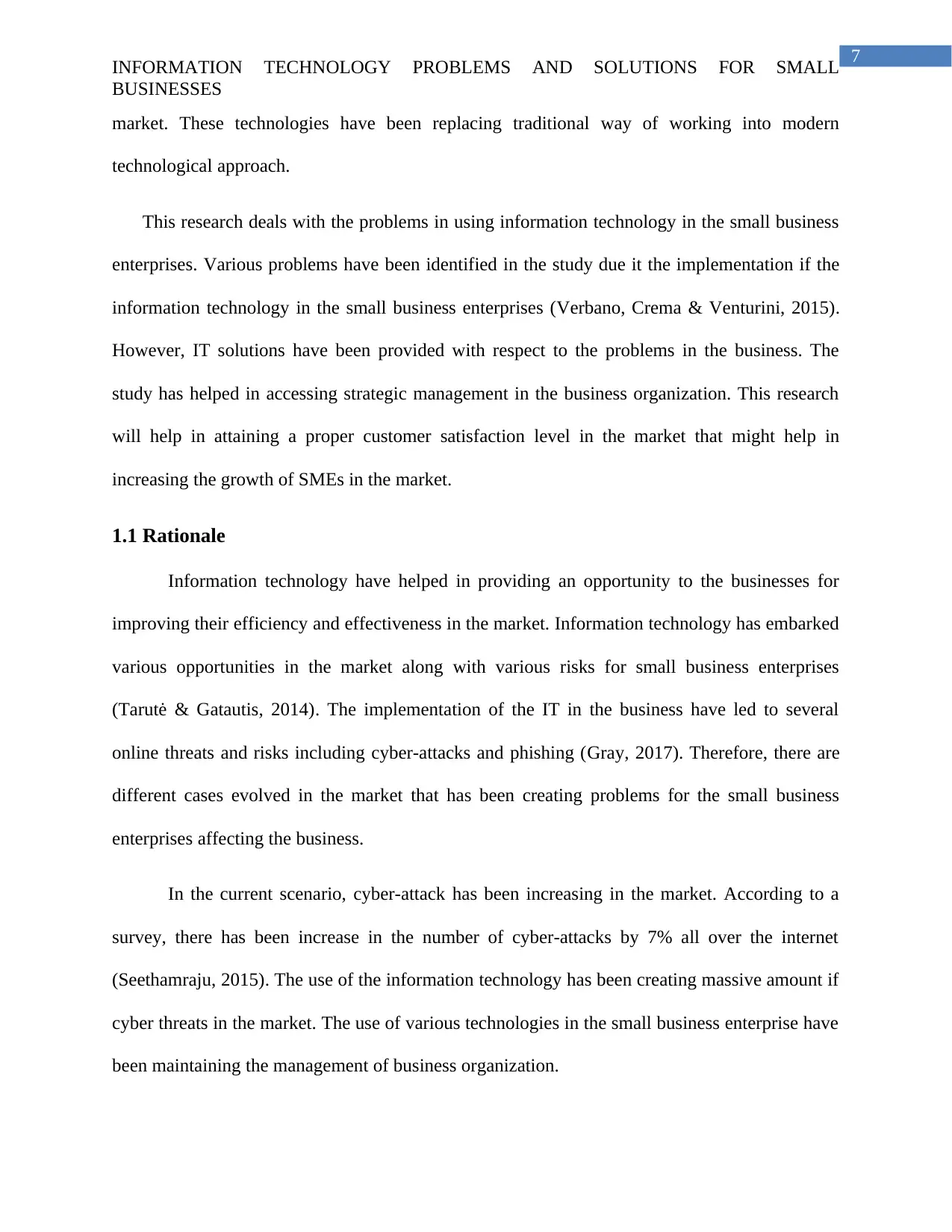
7
INFORMATION TECHNOLOGY PROBLEMS AND SOLUTIONS FOR SMALL
BUSINESSES
market. These technologies have been replacing traditional way of working into modern
technological approach.
This research deals with the problems in using information technology in the small business
enterprises. Various problems have been identified in the study due it the implementation if the
information technology in the small business enterprises (Verbano, Crema & Venturini, 2015).
However, IT solutions have been provided with respect to the problems in the business. The
study has helped in accessing strategic management in the business organization. This research
will help in attaining a proper customer satisfaction level in the market that might help in
increasing the growth of SMEs in the market.
1.1 Rationale
Information technology have helped in providing an opportunity to the businesses for
improving their efficiency and effectiveness in the market. Information technology has embarked
various opportunities in the market along with various risks for small business enterprises
(Tarutė & Gatautis, 2014). The implementation of the IT in the business have led to several
online threats and risks including cyber-attacks and phishing (Gray, 2017). Therefore, there are
different cases evolved in the market that has been creating problems for the small business
enterprises affecting the business.
In the current scenario, cyber-attack has been increasing in the market. According to a
survey, there has been increase in the number of cyber-attacks by 7% all over the internet
(Seethamraju, 2015). The use of the information technology has been creating massive amount if
cyber threats in the market. The use of various technologies in the small business enterprise have
been maintaining the management of business organization.
INFORMATION TECHNOLOGY PROBLEMS AND SOLUTIONS FOR SMALL
BUSINESSES
market. These technologies have been replacing traditional way of working into modern
technological approach.
This research deals with the problems in using information technology in the small business
enterprises. Various problems have been identified in the study due it the implementation if the
information technology in the small business enterprises (Verbano, Crema & Venturini, 2015).
However, IT solutions have been provided with respect to the problems in the business. The
study has helped in accessing strategic management in the business organization. This research
will help in attaining a proper customer satisfaction level in the market that might help in
increasing the growth of SMEs in the market.
1.1 Rationale
Information technology have helped in providing an opportunity to the businesses for
improving their efficiency and effectiveness in the market. Information technology has embarked
various opportunities in the market along with various risks for small business enterprises
(Tarutė & Gatautis, 2014). The implementation of the IT in the business have led to several
online threats and risks including cyber-attacks and phishing (Gray, 2017). Therefore, there are
different cases evolved in the market that has been creating problems for the small business
enterprises affecting the business.
In the current scenario, cyber-attack has been increasing in the market. According to a
survey, there has been increase in the number of cyber-attacks by 7% all over the internet
(Seethamraju, 2015). The use of the information technology has been creating massive amount if
cyber threats in the market. The use of various technologies in the small business enterprise have
been maintaining the management of business organization.
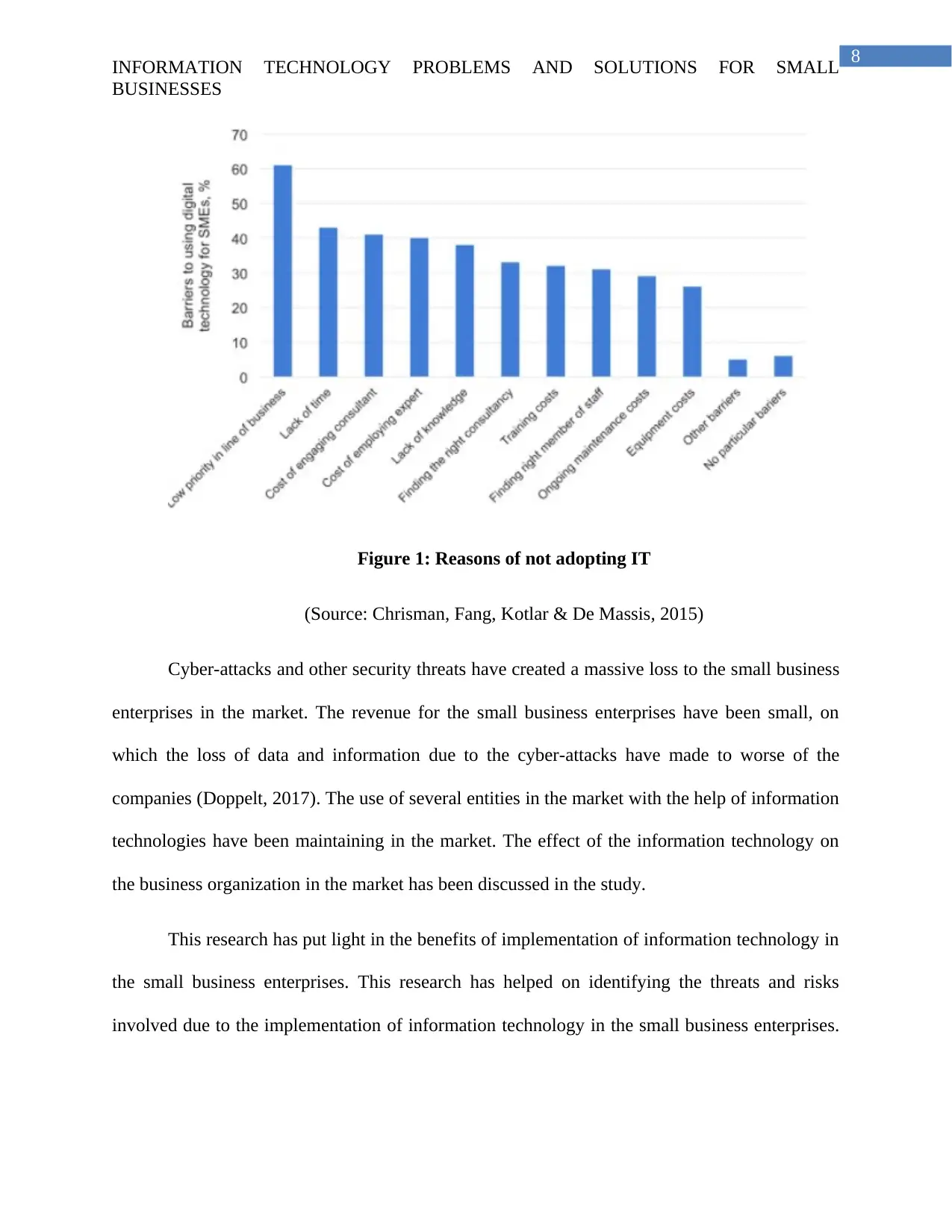
8
INFORMATION TECHNOLOGY PROBLEMS AND SOLUTIONS FOR SMALL
BUSINESSES
Figure 1: Reasons of not adopting IT
(Source: Chrisman, Fang, Kotlar & De Massis, 2015)
Cyber-attacks and other security threats have created a massive loss to the small business
enterprises in the market. The revenue for the small business enterprises have been small, on
which the loss of data and information due to the cyber-attacks have made to worse of the
companies (Doppelt, 2017). The use of several entities in the market with the help of information
technologies have been maintaining in the market. The effect of the information technology on
the business organization in the market has been discussed in the study.
This research has put light in the benefits of implementation of information technology in
the small business enterprises. This research has helped on identifying the threats and risks
involved due to the implementation of information technology in the small business enterprises.
INFORMATION TECHNOLOGY PROBLEMS AND SOLUTIONS FOR SMALL
BUSINESSES
Figure 1: Reasons of not adopting IT
(Source: Chrisman, Fang, Kotlar & De Massis, 2015)
Cyber-attacks and other security threats have created a massive loss to the small business
enterprises in the market. The revenue for the small business enterprises have been small, on
which the loss of data and information due to the cyber-attacks have made to worse of the
companies (Doppelt, 2017). The use of several entities in the market with the help of information
technologies have been maintaining in the market. The effect of the information technology on
the business organization in the market has been discussed in the study.
This research has put light in the benefits of implementation of information technology in
the small business enterprises. This research has helped on identifying the threats and risks
involved due to the implementation of information technology in the small business enterprises.
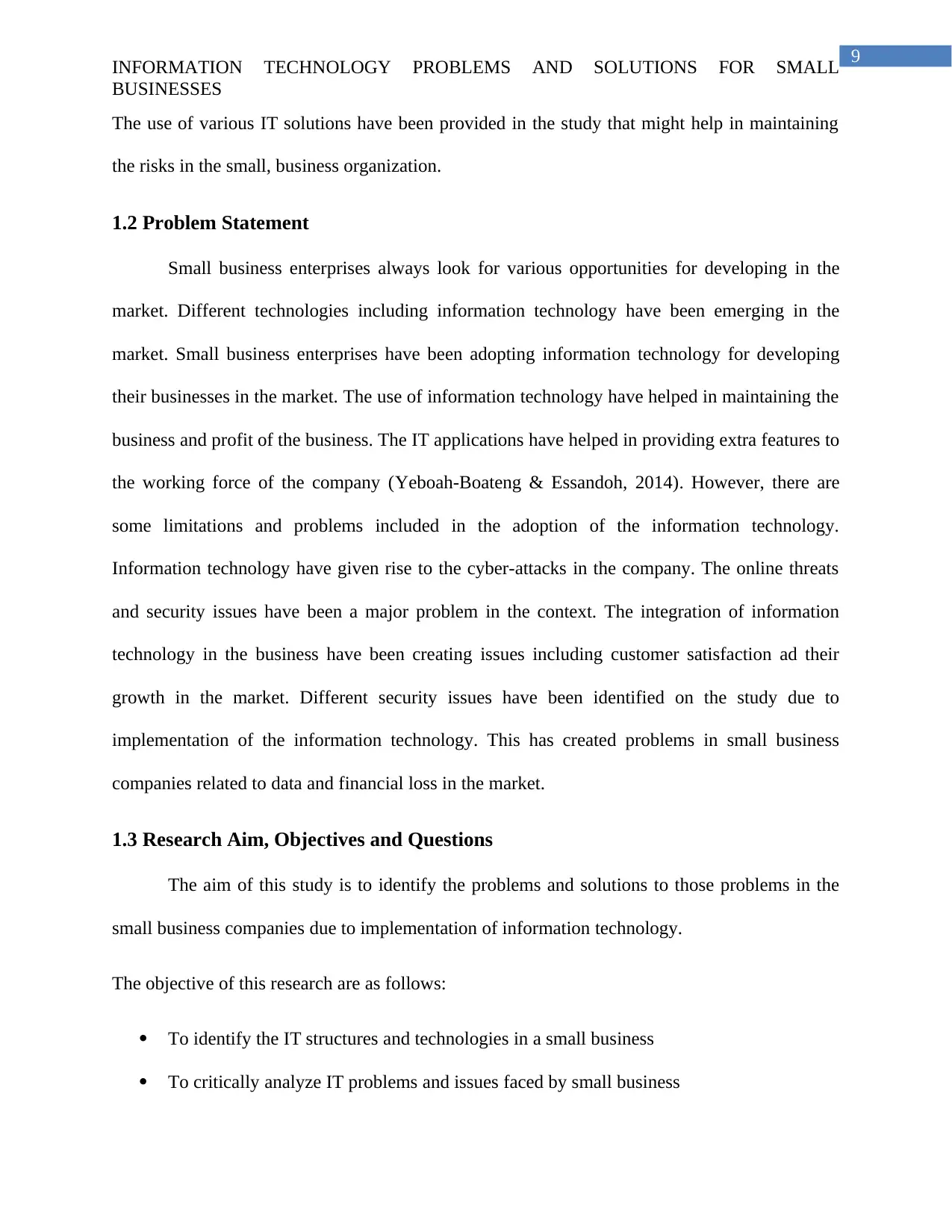
9
INFORMATION TECHNOLOGY PROBLEMS AND SOLUTIONS FOR SMALL
BUSINESSES
The use of various IT solutions have been provided in the study that might help in maintaining
the risks in the small, business organization.
1.2 Problem Statement
Small business enterprises always look for various opportunities for developing in the
market. Different technologies including information technology have been emerging in the
market. Small business enterprises have been adopting information technology for developing
their businesses in the market. The use of information technology have helped in maintaining the
business and profit of the business. The IT applications have helped in providing extra features to
the working force of the company (Yeboah-Boateng & Essandoh, 2014). However, there are
some limitations and problems included in the adoption of the information technology.
Information technology have given rise to the cyber-attacks in the company. The online threats
and security issues have been a major problem in the context. The integration of information
technology in the business have been creating issues including customer satisfaction ad their
growth in the market. Different security issues have been identified on the study due to
implementation of the information technology. This has created problems in small business
companies related to data and financial loss in the market.
1.3 Research Aim, Objectives and Questions
The aim of this study is to identify the problems and solutions to those problems in the
small business companies due to implementation of information technology.
The objective of this research are as follows:
To identify the IT structures and technologies in a small business
To critically analyze IT problems and issues faced by small business
INFORMATION TECHNOLOGY PROBLEMS AND SOLUTIONS FOR SMALL
BUSINESSES
The use of various IT solutions have been provided in the study that might help in maintaining
the risks in the small, business organization.
1.2 Problem Statement
Small business enterprises always look for various opportunities for developing in the
market. Different technologies including information technology have been emerging in the
market. Small business enterprises have been adopting information technology for developing
their businesses in the market. The use of information technology have helped in maintaining the
business and profit of the business. The IT applications have helped in providing extra features to
the working force of the company (Yeboah-Boateng & Essandoh, 2014). However, there are
some limitations and problems included in the adoption of the information technology.
Information technology have given rise to the cyber-attacks in the company. The online threats
and security issues have been a major problem in the context. The integration of information
technology in the business have been creating issues including customer satisfaction ad their
growth in the market. Different security issues have been identified on the study due to
implementation of the information technology. This has created problems in small business
companies related to data and financial loss in the market.
1.3 Research Aim, Objectives and Questions
The aim of this study is to identify the problems and solutions to those problems in the
small business companies due to implementation of information technology.
The objective of this research are as follows:
To identify the IT structures and technologies in a small business
To critically analyze IT problems and issues faced by small business
Secure Best Marks with AI Grader
Need help grading? Try our AI Grader for instant feedback on your assignments.
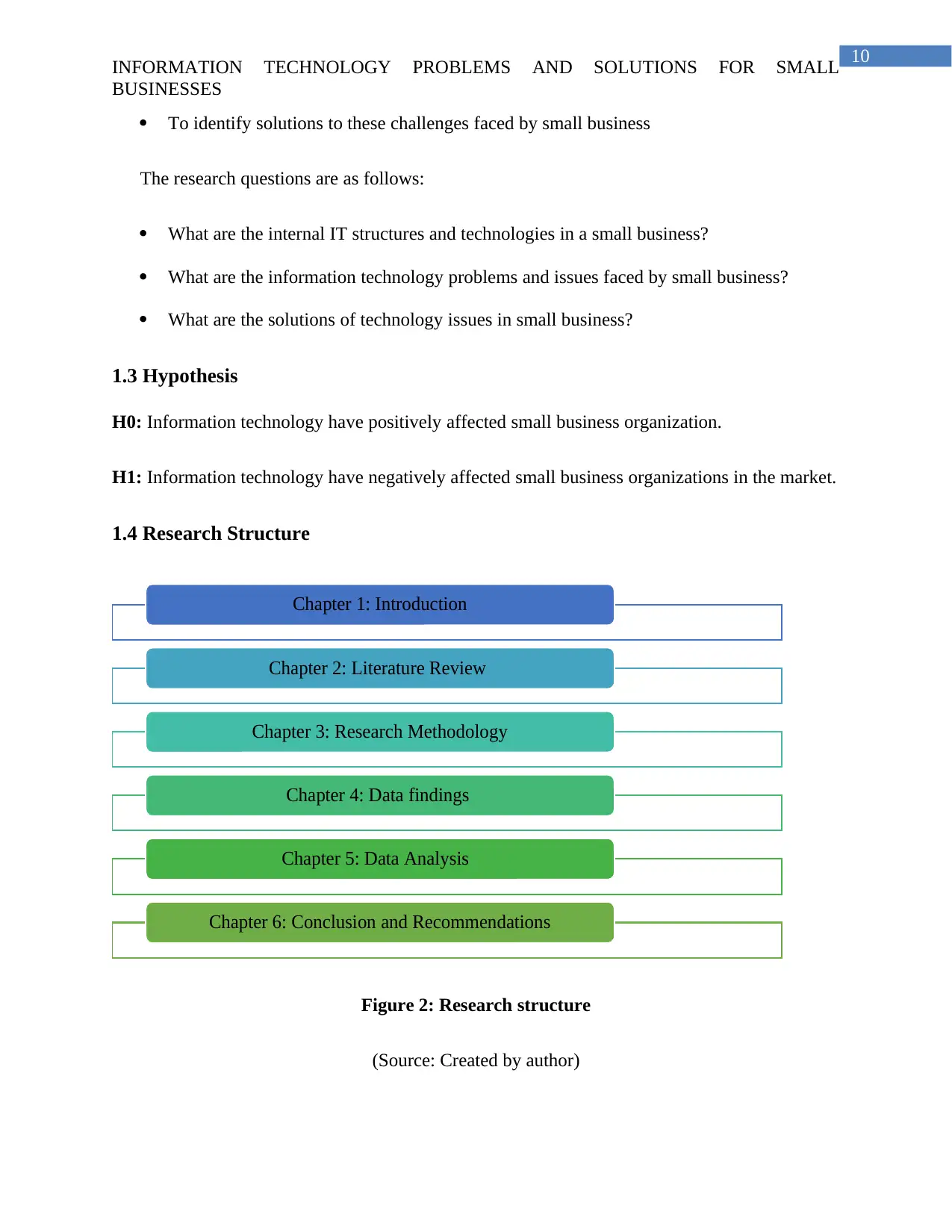
10
INFORMATION TECHNOLOGY PROBLEMS AND SOLUTIONS FOR SMALL
BUSINESSES
To identify solutions to these challenges faced by small business
The research questions are as follows:
What are the internal IT structures and technologies in a small business?
What are the information technology problems and issues faced by small business?
What are the solutions of technology issues in small business?
1.3 Hypothesis
H0: Information technology have positively affected small business organization.
H1: Information technology have negatively affected small business organizations in the market.
1.4 Research Structure
Figure 2: Research structure
(Source: Created by author)
Chapter 1: Introduction
Chapter 2: Literature Review
Chapter 3: Research Methodology
Chapter 4: Data findings
Chapter 5: Data Analysis
Chapter 6: Conclusion and Recommendations
INFORMATION TECHNOLOGY PROBLEMS AND SOLUTIONS FOR SMALL
BUSINESSES
To identify solutions to these challenges faced by small business
The research questions are as follows:
What are the internal IT structures and technologies in a small business?
What are the information technology problems and issues faced by small business?
What are the solutions of technology issues in small business?
1.3 Hypothesis
H0: Information technology have positively affected small business organization.
H1: Information technology have negatively affected small business organizations in the market.
1.4 Research Structure
Figure 2: Research structure
(Source: Created by author)
Chapter 1: Introduction
Chapter 2: Literature Review
Chapter 3: Research Methodology
Chapter 4: Data findings
Chapter 5: Data Analysis
Chapter 6: Conclusion and Recommendations
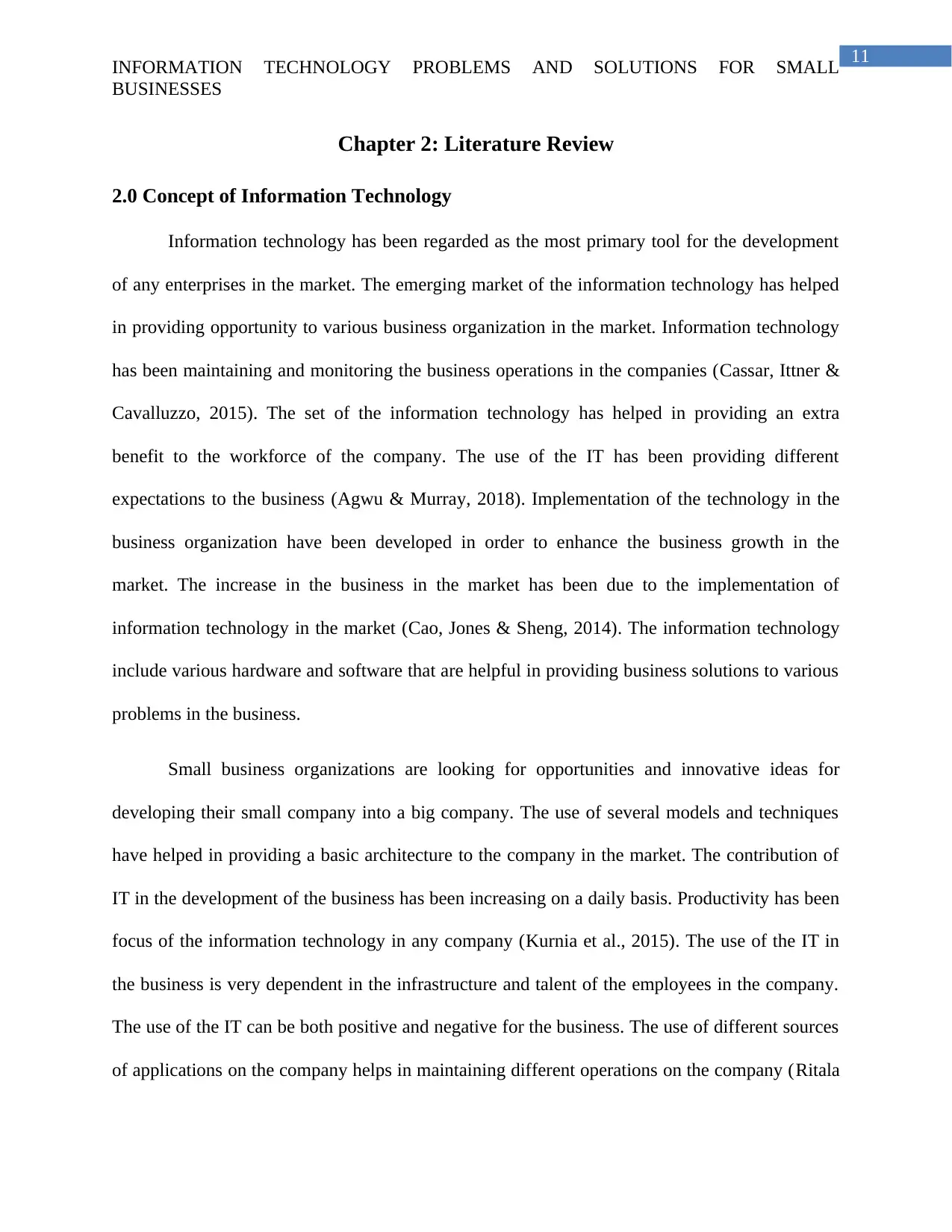
11
INFORMATION TECHNOLOGY PROBLEMS AND SOLUTIONS FOR SMALL
BUSINESSES
Chapter 2: Literature Review
2.0 Concept of Information Technology
Information technology has been regarded as the most primary tool for the development
of any enterprises in the market. The emerging market of the information technology has helped
in providing opportunity to various business organization in the market. Information technology
has been maintaining and monitoring the business operations in the companies (Cassar, Ittner &
Cavalluzzo, 2015). The set of the information technology has helped in providing an extra
benefit to the workforce of the company. The use of the IT has been providing different
expectations to the business (Agwu & Murray, 2018). Implementation of the technology in the
business organization have been developed in order to enhance the business growth in the
market. The increase in the business in the market has been due to the implementation of
information technology in the market (Cao, Jones & Sheng, 2014). The information technology
include various hardware and software that are helpful in providing business solutions to various
problems in the business.
Small business organizations are looking for opportunities and innovative ideas for
developing their small company into a big company. The use of several models and techniques
have helped in providing a basic architecture to the company in the market. The contribution of
IT in the development of the business has been increasing on a daily basis. Productivity has been
focus of the information technology in any company (Kurnia et al., 2015). The use of the IT in
the business is very dependent in the infrastructure and talent of the employees in the company.
The use of the IT can be both positive and negative for the business. The use of different sources
of applications on the company helps in maintaining different operations on the company (Ritala
INFORMATION TECHNOLOGY PROBLEMS AND SOLUTIONS FOR SMALL
BUSINESSES
Chapter 2: Literature Review
2.0 Concept of Information Technology
Information technology has been regarded as the most primary tool for the development
of any enterprises in the market. The emerging market of the information technology has helped
in providing opportunity to various business organization in the market. Information technology
has been maintaining and monitoring the business operations in the companies (Cassar, Ittner &
Cavalluzzo, 2015). The set of the information technology has helped in providing an extra
benefit to the workforce of the company. The use of the IT has been providing different
expectations to the business (Agwu & Murray, 2018). Implementation of the technology in the
business organization have been developed in order to enhance the business growth in the
market. The increase in the business in the market has been due to the implementation of
information technology in the market (Cao, Jones & Sheng, 2014). The information technology
include various hardware and software that are helpful in providing business solutions to various
problems in the business.
Small business organizations are looking for opportunities and innovative ideas for
developing their small company into a big company. The use of several models and techniques
have helped in providing a basic architecture to the company in the market. The contribution of
IT in the development of the business has been increasing on a daily basis. Productivity has been
focus of the information technology in any company (Kurnia et al., 2015). The use of the IT in
the business is very dependent in the infrastructure and talent of the employees in the company.
The use of the IT can be both positive and negative for the business. The use of different sources
of applications on the company helps in maintaining different operations on the company (Ritala
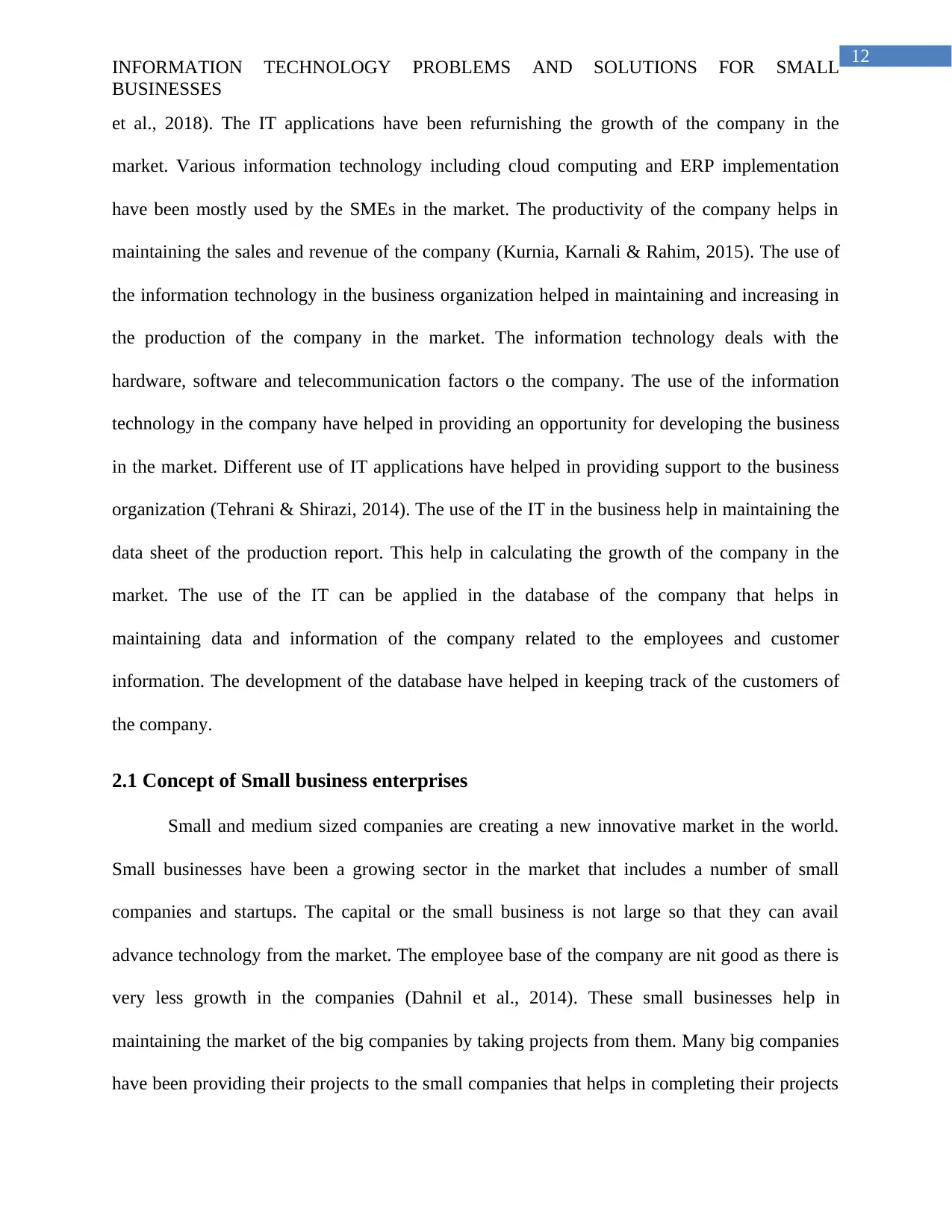
12
INFORMATION TECHNOLOGY PROBLEMS AND SOLUTIONS FOR SMALL
BUSINESSES
et al., 2018). The IT applications have been refurnishing the growth of the company in the
market. Various information technology including cloud computing and ERP implementation
have been mostly used by the SMEs in the market. The productivity of the company helps in
maintaining the sales and revenue of the company (Kurnia, Karnali & Rahim, 2015). The use of
the information technology in the business organization helped in maintaining and increasing in
the production of the company in the market. The information technology deals with the
hardware, software and telecommunication factors o the company. The use of the information
technology in the company have helped in providing an opportunity for developing the business
in the market. Different use of IT applications have helped in providing support to the business
organization (Tehrani & Shirazi, 2014). The use of the IT in the business help in maintaining the
data sheet of the production report. This help in calculating the growth of the company in the
market. The use of the IT can be applied in the database of the company that helps in
maintaining data and information of the company related to the employees and customer
information. The development of the database have helped in keeping track of the customers of
the company.
2.1 Concept of Small business enterprises
Small and medium sized companies are creating a new innovative market in the world.
Small businesses have been a growing sector in the market that includes a number of small
companies and startups. The capital or the small business is not large so that they can avail
advance technology from the market. The employee base of the company are nit good as there is
very less growth in the companies (Dahnil et al., 2014). These small businesses help in
maintaining the market of the big companies by taking projects from them. Many big companies
have been providing their projects to the small companies that helps in completing their projects
INFORMATION TECHNOLOGY PROBLEMS AND SOLUTIONS FOR SMALL
BUSINESSES
et al., 2018). The IT applications have been refurnishing the growth of the company in the
market. Various information technology including cloud computing and ERP implementation
have been mostly used by the SMEs in the market. The productivity of the company helps in
maintaining the sales and revenue of the company (Kurnia, Karnali & Rahim, 2015). The use of
the information technology in the business organization helped in maintaining and increasing in
the production of the company in the market. The information technology deals with the
hardware, software and telecommunication factors o the company. The use of the information
technology in the company have helped in providing an opportunity for developing the business
in the market. Different use of IT applications have helped in providing support to the business
organization (Tehrani & Shirazi, 2014). The use of the IT in the business help in maintaining the
data sheet of the production report. This help in calculating the growth of the company in the
market. The use of the IT can be applied in the database of the company that helps in
maintaining data and information of the company related to the employees and customer
information. The development of the database have helped in keeping track of the customers of
the company.
2.1 Concept of Small business enterprises
Small and medium sized companies are creating a new innovative market in the world.
Small businesses have been a growing sector in the market that includes a number of small
companies and startups. The capital or the small business is not large so that they can avail
advance technology from the market. The employee base of the company are nit good as there is
very less growth in the companies (Dahnil et al., 2014). These small businesses help in
maintaining the market of the big companies by taking projects from them. Many big companies
have been providing their projects to the small companies that helps in completing their projects
Paraphrase This Document
Need a fresh take? Get an instant paraphrase of this document with our AI Paraphraser
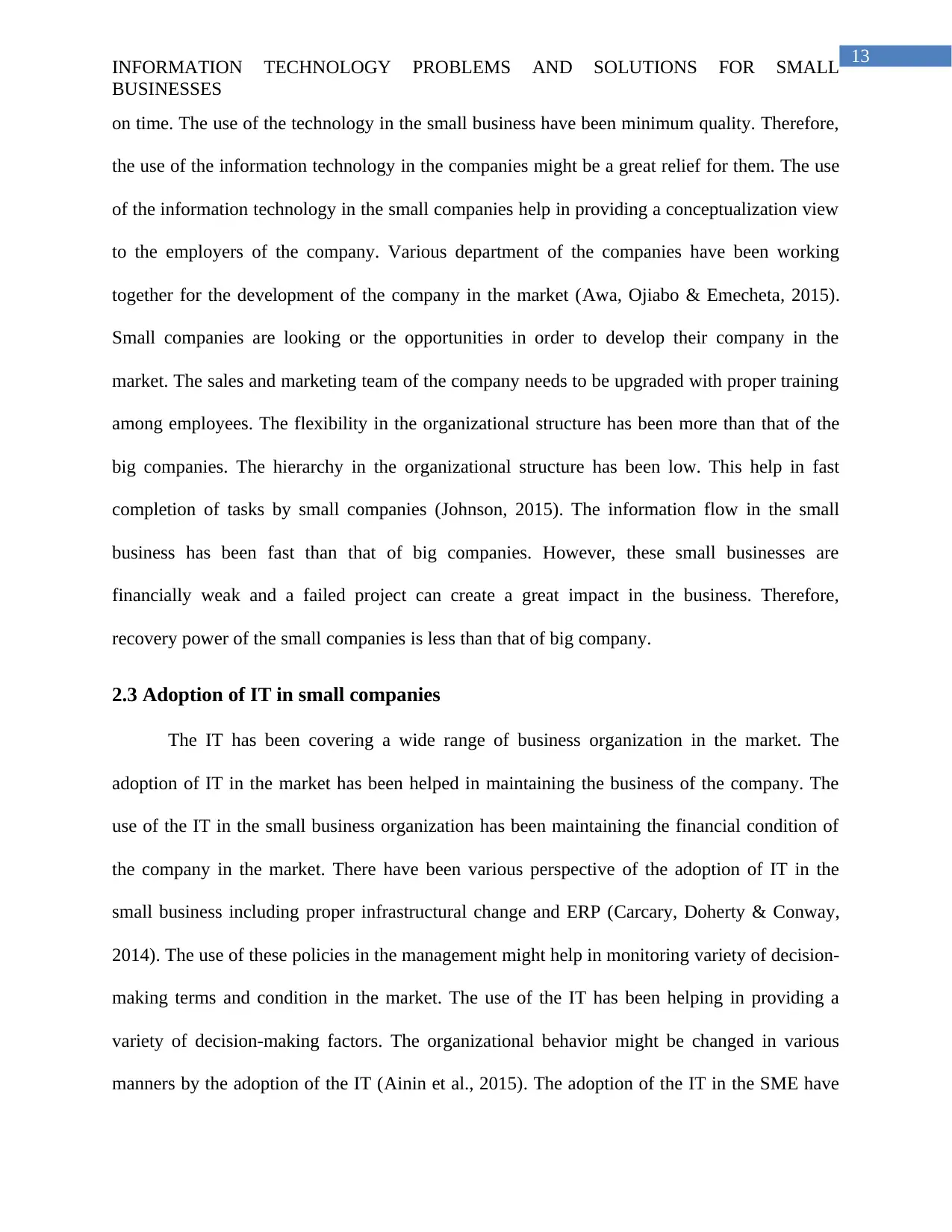
13
INFORMATION TECHNOLOGY PROBLEMS AND SOLUTIONS FOR SMALL
BUSINESSES
on time. The use of the technology in the small business have been minimum quality. Therefore,
the use of the information technology in the companies might be a great relief for them. The use
of the information technology in the small companies help in providing a conceptualization view
to the employers of the company. Various department of the companies have been working
together for the development of the company in the market (Awa, Ojiabo & Emecheta, 2015).
Small companies are looking or the opportunities in order to develop their company in the
market. The sales and marketing team of the company needs to be upgraded with proper training
among employees. The flexibility in the organizational structure has been more than that of the
big companies. The hierarchy in the organizational structure has been low. This help in fast
completion of tasks by small companies (Johnson, 2015). The information flow in the small
business has been fast than that of big companies. However, these small businesses are
financially weak and a failed project can create a great impact in the business. Therefore,
recovery power of the small companies is less than that of big company.
2.3 Adoption of IT in small companies
The IT has been covering a wide range of business organization in the market. The
adoption of IT in the market has been helped in maintaining the business of the company. The
use of the IT in the small business organization has been maintaining the financial condition of
the company in the market. There have been various perspective of the adoption of IT in the
small business including proper infrastructural change and ERP (Carcary, Doherty & Conway,
2014). The use of these policies in the management might help in monitoring variety of decision-
making terms and condition in the market. The use of the IT has been helping in providing a
variety of decision-making factors. The organizational behavior might be changed in various
manners by the adoption of the IT (Ainin et al., 2015). The adoption of the IT in the SME have
INFORMATION TECHNOLOGY PROBLEMS AND SOLUTIONS FOR SMALL
BUSINESSES
on time. The use of the technology in the small business have been minimum quality. Therefore,
the use of the information technology in the companies might be a great relief for them. The use
of the information technology in the small companies help in providing a conceptualization view
to the employers of the company. Various department of the companies have been working
together for the development of the company in the market (Awa, Ojiabo & Emecheta, 2015).
Small companies are looking or the opportunities in order to develop their company in the
market. The sales and marketing team of the company needs to be upgraded with proper training
among employees. The flexibility in the organizational structure has been more than that of the
big companies. The hierarchy in the organizational structure has been low. This help in fast
completion of tasks by small companies (Johnson, 2015). The information flow in the small
business has been fast than that of big companies. However, these small businesses are
financially weak and a failed project can create a great impact in the business. Therefore,
recovery power of the small companies is less than that of big company.
2.3 Adoption of IT in small companies
The IT has been covering a wide range of business organization in the market. The
adoption of IT in the market has been helped in maintaining the business of the company. The
use of the IT in the small business organization has been maintaining the financial condition of
the company in the market. There have been various perspective of the adoption of IT in the
small business including proper infrastructural change and ERP (Carcary, Doherty & Conway,
2014). The use of these policies in the management might help in monitoring variety of decision-
making terms and condition in the market. The use of the IT has been helping in providing a
variety of decision-making factors. The organizational behavior might be changed in various
manners by the adoption of the IT (Ainin et al., 2015). The adoption of the IT in the SME have
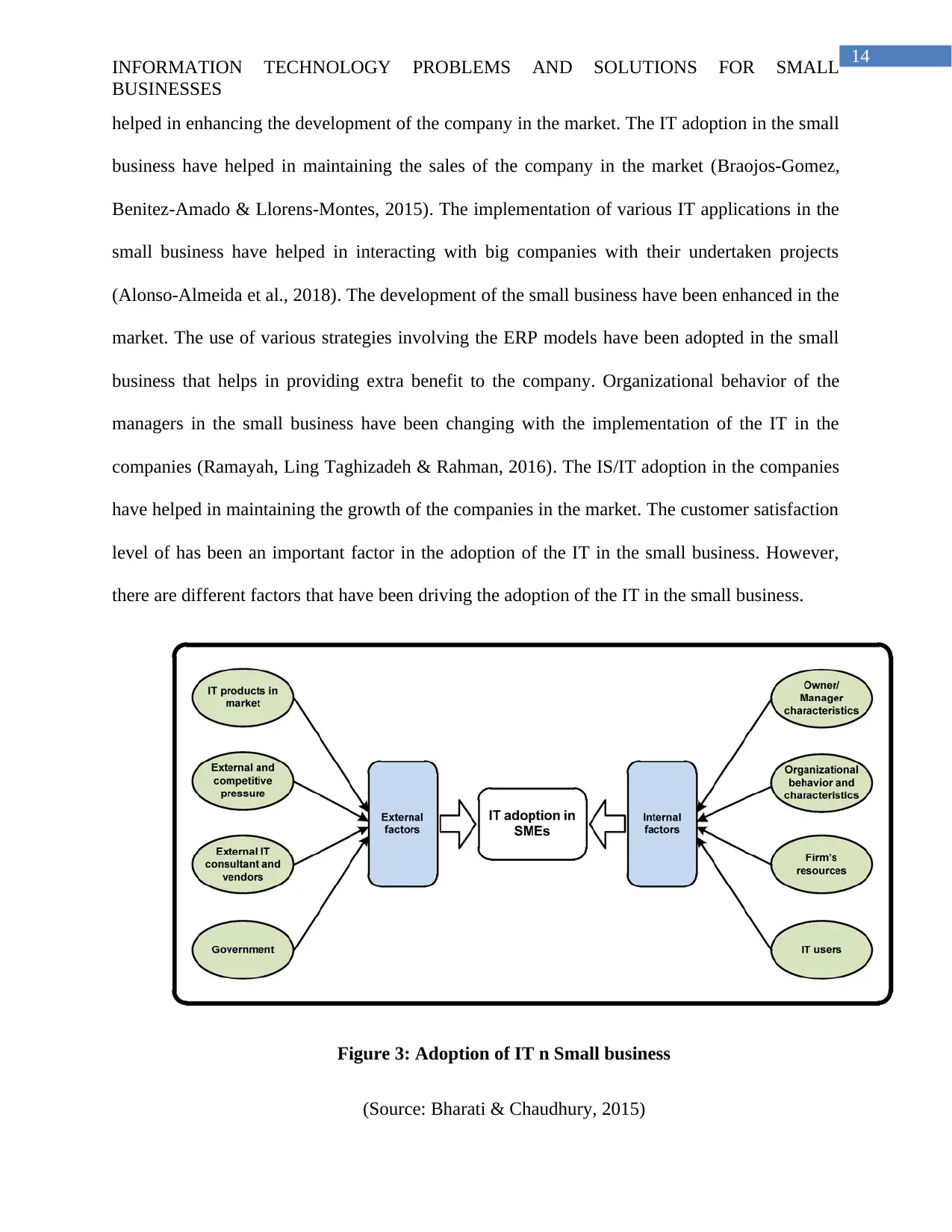
14
INFORMATION TECHNOLOGY PROBLEMS AND SOLUTIONS FOR SMALL
BUSINESSES
helped in enhancing the development of the company in the market. The IT adoption in the small
business have helped in maintaining the sales of the company in the market (Braojos-Gomez,
Benitez-Amado & Llorens-Montes, 2015). The implementation of various IT applications in the
small business have helped in interacting with big companies with their undertaken projects
(Alonso-Almeida et al., 2018). The development of the small business have been enhanced in the
market. The use of various strategies involving the ERP models have been adopted in the small
business that helps in providing extra benefit to the company. Organizational behavior of the
managers in the small business have been changing with the implementation of the IT in the
companies (Ramayah, Ling Taghizadeh & Rahman, 2016). The IS/IT adoption in the companies
have helped in maintaining the growth of the companies in the market. The customer satisfaction
level of has been an important factor in the adoption of the IT in the small business. However,
there are different factors that have been driving the adoption of the IT in the small business.
Figure 3: Adoption of IT n Small business
(Source: Bharati & Chaudhury, 2015)
INFORMATION TECHNOLOGY PROBLEMS AND SOLUTIONS FOR SMALL
BUSINESSES
helped in enhancing the development of the company in the market. The IT adoption in the small
business have helped in maintaining the sales of the company in the market (Braojos-Gomez,
Benitez-Amado & Llorens-Montes, 2015). The implementation of various IT applications in the
small business have helped in interacting with big companies with their undertaken projects
(Alonso-Almeida et al., 2018). The development of the small business have been enhanced in the
market. The use of various strategies involving the ERP models have been adopted in the small
business that helps in providing extra benefit to the company. Organizational behavior of the
managers in the small business have been changing with the implementation of the IT in the
companies (Ramayah, Ling Taghizadeh & Rahman, 2016). The IS/IT adoption in the companies
have helped in maintaining the growth of the companies in the market. The customer satisfaction
level of has been an important factor in the adoption of the IT in the small business. However,
there are different factors that have been driving the adoption of the IT in the small business.
Figure 3: Adoption of IT n Small business
(Source: Bharati & Chaudhury, 2015)
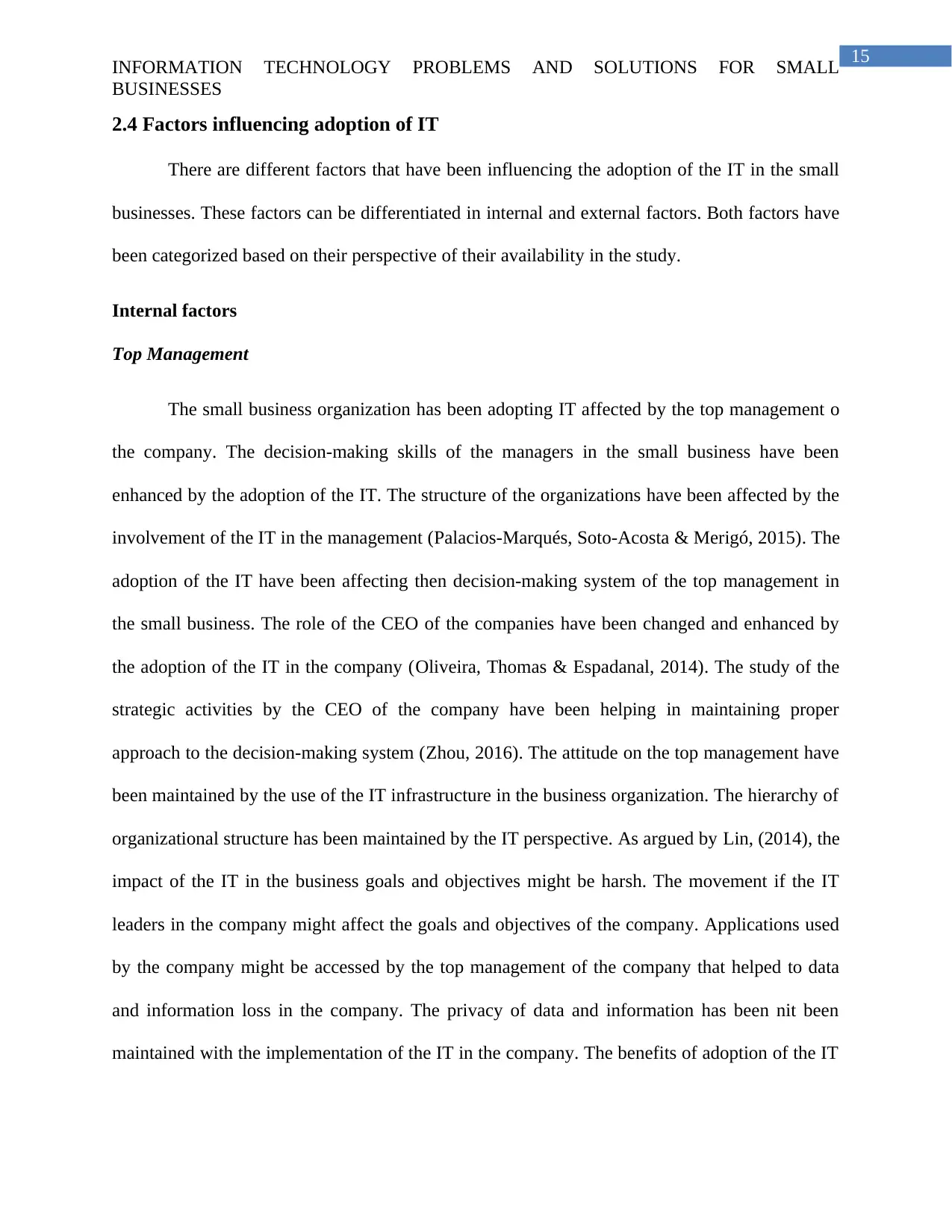
15
INFORMATION TECHNOLOGY PROBLEMS AND SOLUTIONS FOR SMALL
BUSINESSES
2.4 Factors influencing adoption of IT
There are different factors that have been influencing the adoption of the IT in the small
businesses. These factors can be differentiated in internal and external factors. Both factors have
been categorized based on their perspective of their availability in the study.
Internal factors
Top Management
The small business organization has been adopting IT affected by the top management o
the company. The decision-making skills of the managers in the small business have been
enhanced by the adoption of the IT. The structure of the organizations have been affected by the
involvement of the IT in the management (Palacios-Marqués, Soto-Acosta & Merigó, 2015). The
adoption of the IT have been affecting then decision-making system of the top management in
the small business. The role of the CEO of the companies have been changed and enhanced by
the adoption of the IT in the company (Oliveira, Thomas & Espadanal, 2014). The study of the
strategic activities by the CEO of the company have been helping in maintaining proper
approach to the decision-making system (Zhou, 2016). The attitude on the top management have
been maintained by the use of the IT infrastructure in the business organization. The hierarchy of
organizational structure has been maintained by the IT perspective. As argued by Lin, (2014), the
impact of the IT in the business goals and objectives might be harsh. The movement if the IT
leaders in the company might affect the goals and objectives of the company. Applications used
by the company might be accessed by the top management of the company that helped to data
and information loss in the company. The privacy of data and information has been nit been
maintained with the implementation of the IT in the company. The benefits of adoption of the IT
INFORMATION TECHNOLOGY PROBLEMS AND SOLUTIONS FOR SMALL
BUSINESSES
2.4 Factors influencing adoption of IT
There are different factors that have been influencing the adoption of the IT in the small
businesses. These factors can be differentiated in internal and external factors. Both factors have
been categorized based on their perspective of their availability in the study.
Internal factors
Top Management
The small business organization has been adopting IT affected by the top management o
the company. The decision-making skills of the managers in the small business have been
enhanced by the adoption of the IT. The structure of the organizations have been affected by the
involvement of the IT in the management (Palacios-Marqués, Soto-Acosta & Merigó, 2015). The
adoption of the IT have been affecting then decision-making system of the top management in
the small business. The role of the CEO of the companies have been changed and enhanced by
the adoption of the IT in the company (Oliveira, Thomas & Espadanal, 2014). The study of the
strategic activities by the CEO of the company have been helping in maintaining proper
approach to the decision-making system (Zhou, 2016). The attitude on the top management have
been maintained by the use of the IT infrastructure in the business organization. The hierarchy of
organizational structure has been maintained by the IT perspective. As argued by Lin, (2014), the
impact of the IT in the business goals and objectives might be harsh. The movement if the IT
leaders in the company might affect the goals and objectives of the company. Applications used
by the company might be accessed by the top management of the company that helped to data
and information loss in the company. The privacy of data and information has been nit been
maintained with the implementation of the IT in the company. The benefits of adoption of the IT
Secure Best Marks with AI Grader
Need help grading? Try our AI Grader for instant feedback on your assignments.
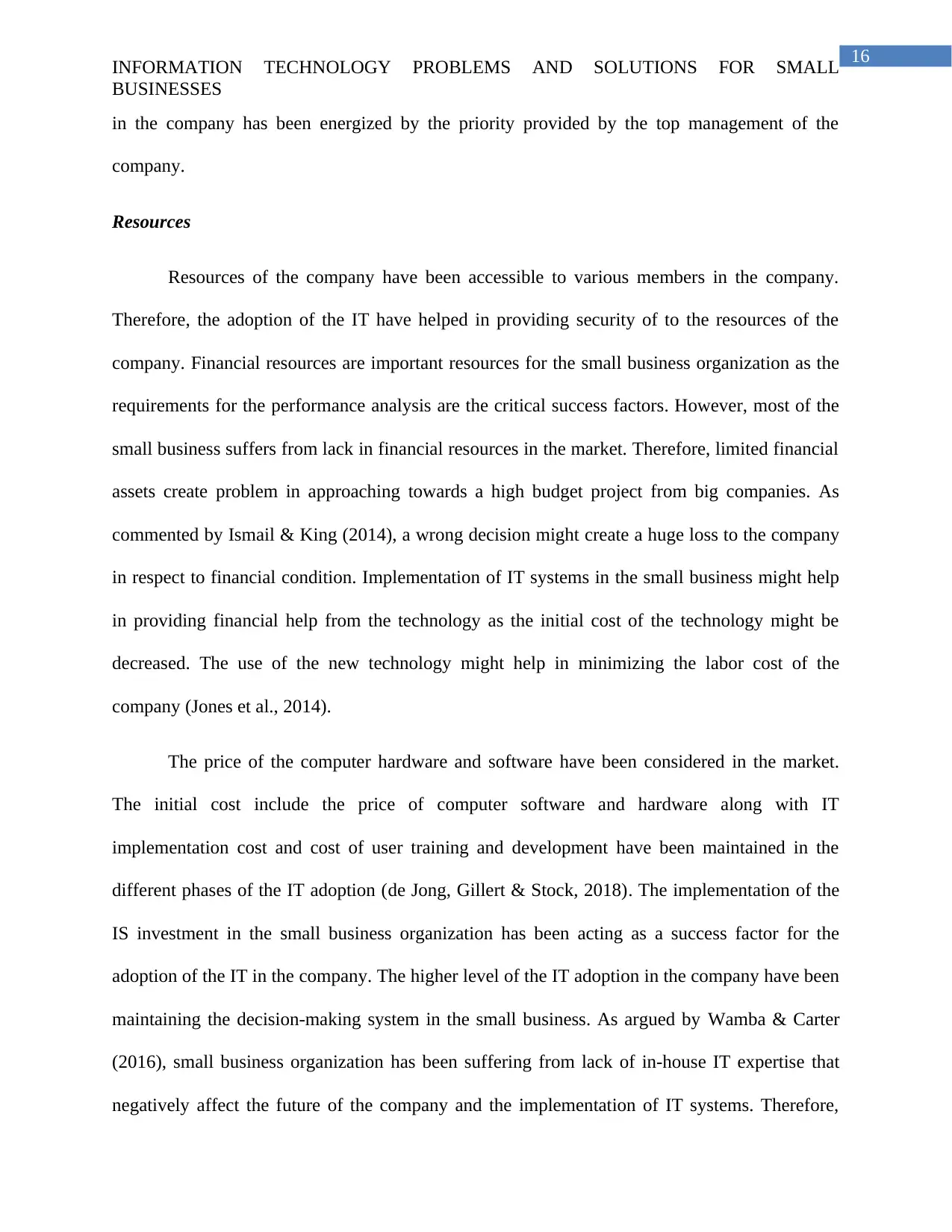
16
INFORMATION TECHNOLOGY PROBLEMS AND SOLUTIONS FOR SMALL
BUSINESSES
in the company has been energized by the priority provided by the top management of the
company.
Resources
Resources of the company have been accessible to various members in the company.
Therefore, the adoption of the IT have helped in providing security of to the resources of the
company. Financial resources are important resources for the small business organization as the
requirements for the performance analysis are the critical success factors. However, most of the
small business suffers from lack in financial resources in the market. Therefore, limited financial
assets create problem in approaching towards a high budget project from big companies. As
commented by Ismail & King (2014), a wrong decision might create a huge loss to the company
in respect to financial condition. Implementation of IT systems in the small business might help
in providing financial help from the technology as the initial cost of the technology might be
decreased. The use of the new technology might help in minimizing the labor cost of the
company (Jones et al., 2014).
The price of the computer hardware and software have been considered in the market.
The initial cost include the price of computer software and hardware along with IT
implementation cost and cost of user training and development have been maintained in the
different phases of the IT adoption (de Jong, Gillert & Stock, 2018). The implementation of the
IS investment in the small business organization has been acting as a success factor for the
adoption of the IT in the company. The higher level of the IT adoption in the company have been
maintaining the decision-making system in the small business. As argued by Wamba & Carter
(2016), small business organization has been suffering from lack of in-house IT expertise that
negatively affect the future of the company and the implementation of IT systems. Therefore,
INFORMATION TECHNOLOGY PROBLEMS AND SOLUTIONS FOR SMALL
BUSINESSES
in the company has been energized by the priority provided by the top management of the
company.
Resources
Resources of the company have been accessible to various members in the company.
Therefore, the adoption of the IT have helped in providing security of to the resources of the
company. Financial resources are important resources for the small business organization as the
requirements for the performance analysis are the critical success factors. However, most of the
small business suffers from lack in financial resources in the market. Therefore, limited financial
assets create problem in approaching towards a high budget project from big companies. As
commented by Ismail & King (2014), a wrong decision might create a huge loss to the company
in respect to financial condition. Implementation of IT systems in the small business might help
in providing financial help from the technology as the initial cost of the technology might be
decreased. The use of the new technology might help in minimizing the labor cost of the
company (Jones et al., 2014).
The price of the computer hardware and software have been considered in the market.
The initial cost include the price of computer software and hardware along with IT
implementation cost and cost of user training and development have been maintained in the
different phases of the IT adoption (de Jong, Gillert & Stock, 2018). The implementation of the
IS investment in the small business organization has been acting as a success factor for the
adoption of the IT in the company. The higher level of the IT adoption in the company have been
maintaining the decision-making system in the small business. As argued by Wamba & Carter
(2016), small business organization has been suffering from lack of in-house IT expertise that
negatively affect the future of the company and the implementation of IT systems. Therefore,
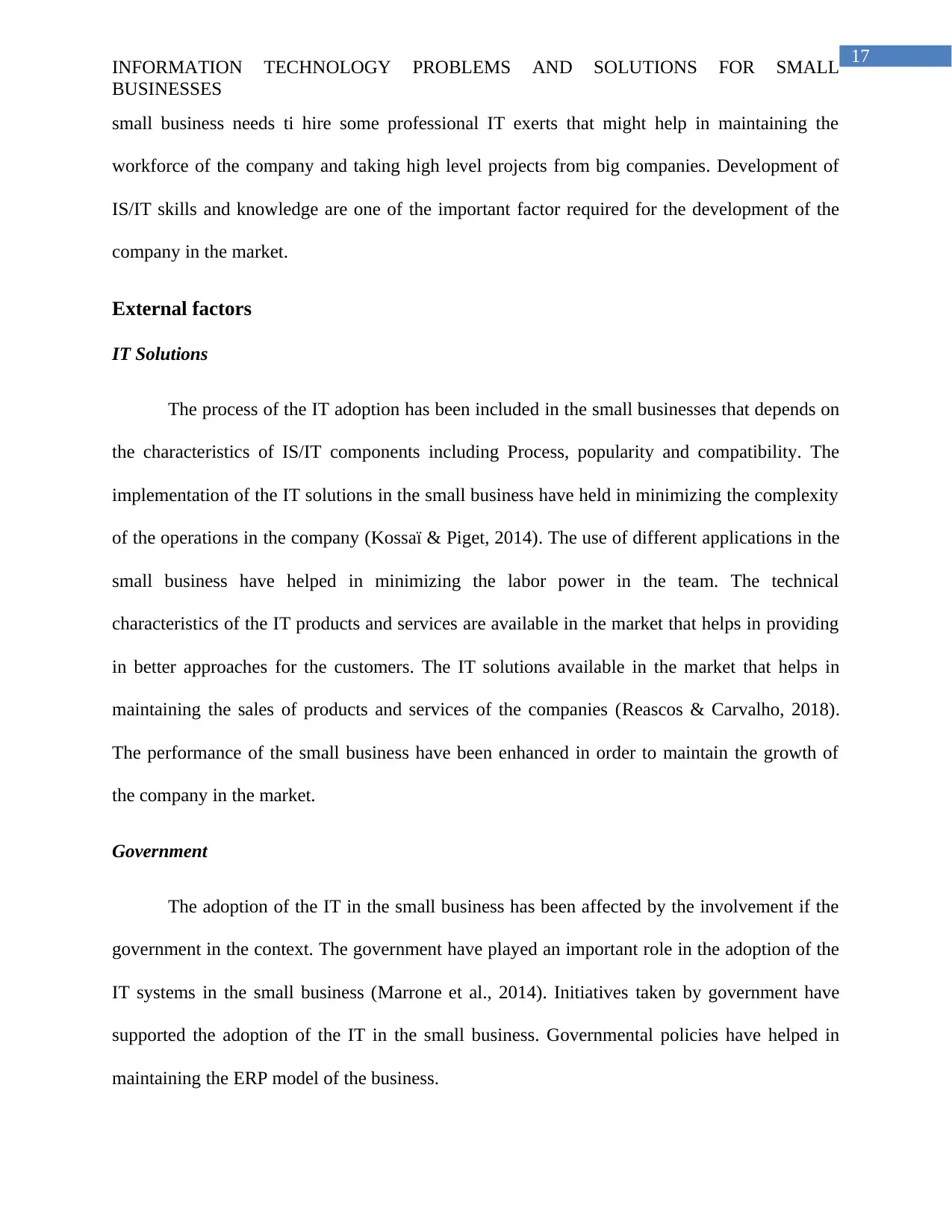
17
INFORMATION TECHNOLOGY PROBLEMS AND SOLUTIONS FOR SMALL
BUSINESSES
small business needs ti hire some professional IT exerts that might help in maintaining the
workforce of the company and taking high level projects from big companies. Development of
IS/IT skills and knowledge are one of the important factor required for the development of the
company in the market.
External factors
IT Solutions
The process of the IT adoption has been included in the small businesses that depends on
the characteristics of IS/IT components including Process, popularity and compatibility. The
implementation of the IT solutions in the small business have held in minimizing the complexity
of the operations in the company (Kossaï & Piget, 2014). The use of different applications in the
small business have helped in minimizing the labor power in the team. The technical
characteristics of the IT products and services are available in the market that helps in providing
in better approaches for the customers. The IT solutions available in the market that helps in
maintaining the sales of products and services of the companies (Reascos & Carvalho, 2018).
The performance of the small business have been enhanced in order to maintain the growth of
the company in the market.
Government
The adoption of the IT in the small business has been affected by the involvement if the
government in the context. The government have played an important role in the adoption of the
IT systems in the small business (Marrone et al., 2014). Initiatives taken by government have
supported the adoption of the IT in the small business. Governmental policies have helped in
maintaining the ERP model of the business.
INFORMATION TECHNOLOGY PROBLEMS AND SOLUTIONS FOR SMALL
BUSINESSES
small business needs ti hire some professional IT exerts that might help in maintaining the
workforce of the company and taking high level projects from big companies. Development of
IS/IT skills and knowledge are one of the important factor required for the development of the
company in the market.
External factors
IT Solutions
The process of the IT adoption has been included in the small businesses that depends on
the characteristics of IS/IT components including Process, popularity and compatibility. The
implementation of the IT solutions in the small business have held in minimizing the complexity
of the operations in the company (Kossaï & Piget, 2014). The use of different applications in the
small business have helped in minimizing the labor power in the team. The technical
characteristics of the IT products and services are available in the market that helps in providing
in better approaches for the customers. The IT solutions available in the market that helps in
maintaining the sales of products and services of the companies (Reascos & Carvalho, 2018).
The performance of the small business have been enhanced in order to maintain the growth of
the company in the market.
Government
The adoption of the IT in the small business has been affected by the involvement if the
government in the context. The government have played an important role in the adoption of the
IT systems in the small business (Marrone et al., 2014). Initiatives taken by government have
supported the adoption of the IT in the small business. Governmental policies have helped in
maintaining the ERP model of the business.
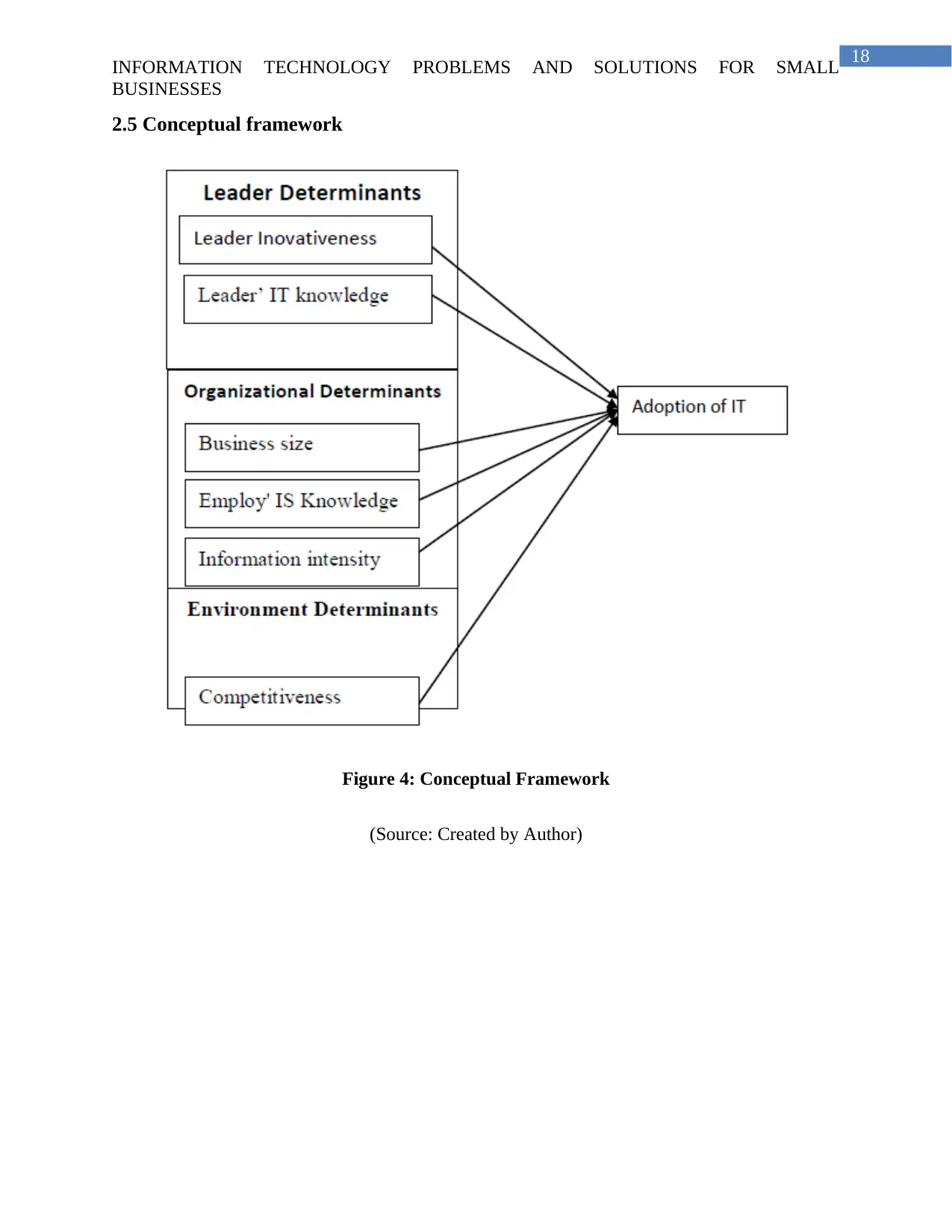
18
INFORMATION TECHNOLOGY PROBLEMS AND SOLUTIONS FOR SMALL
BUSINESSES
2.5 Conceptual framework
Figure 4: Conceptual Framework
(Source: Created by Author)
INFORMATION TECHNOLOGY PROBLEMS AND SOLUTIONS FOR SMALL
BUSINESSES
2.5 Conceptual framework
Figure 4: Conceptual Framework
(Source: Created by Author)
Paraphrase This Document
Need a fresh take? Get an instant paraphrase of this document with our AI Paraphraser
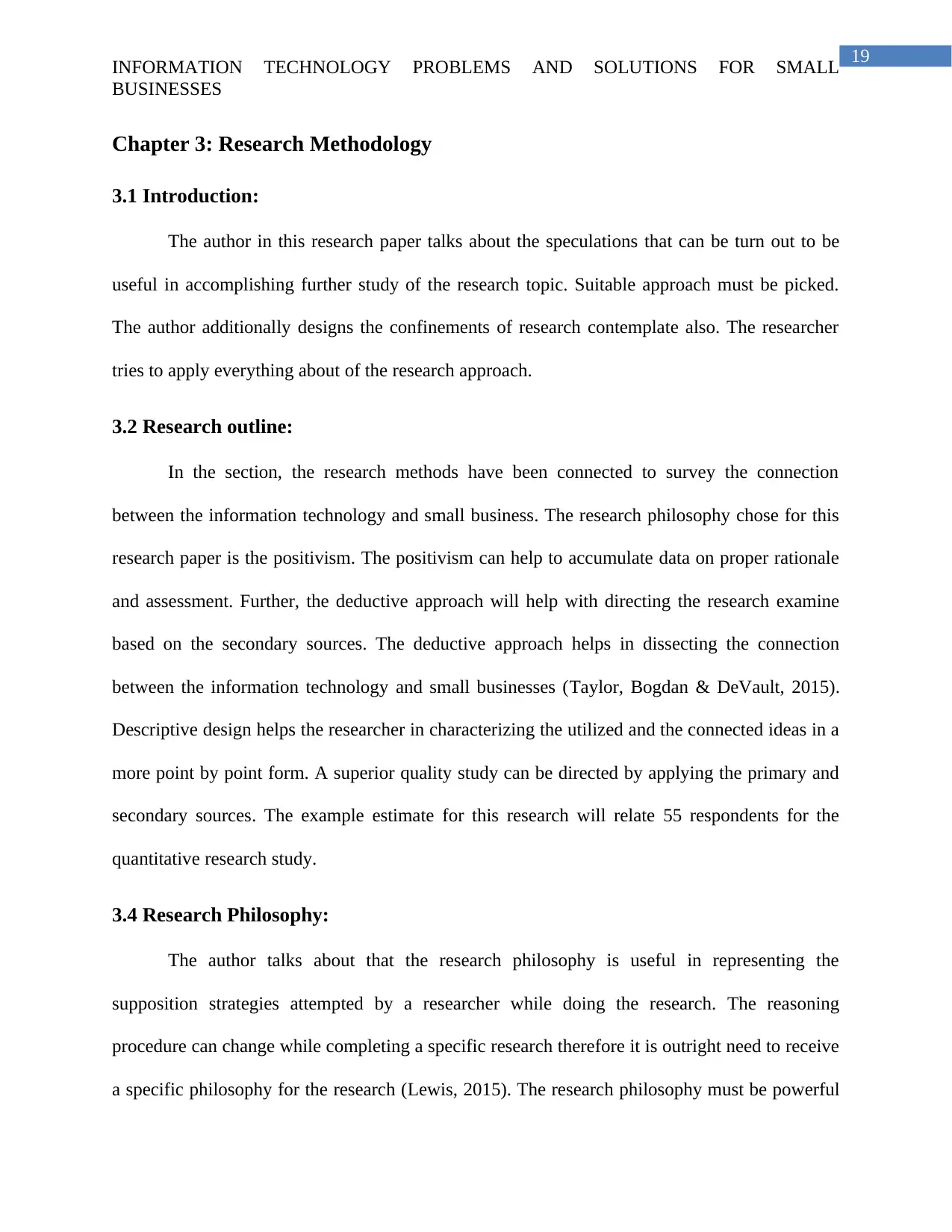
19
INFORMATION TECHNOLOGY PROBLEMS AND SOLUTIONS FOR SMALL
BUSINESSES
Chapter 3: Research Methodology
3.1 Introduction:
The author in this research paper talks about the speculations that can be turn out to be
useful in accomplishing further study of the research topic. Suitable approach must be picked.
The author additionally designs the confinements of research contemplate also. The researcher
tries to apply everything about of the research approach.
3.2 Research outline:
In the section, the research methods have been connected to survey the connection
between the information technology and small business. The research philosophy chose for this
research paper is the positivism. The positivism can help to accumulate data on proper rationale
and assessment. Further, the deductive approach will help with directing the research examine
based on the secondary sources. The deductive approach helps in dissecting the connection
between the information technology and small businesses (Taylor, Bogdan & DeVault, 2015).
Descriptive design helps the researcher in characterizing the utilized and the connected ideas in a
more point by point form. A superior quality study can be directed by applying the primary and
secondary sources. The example estimate for this research will relate 55 respondents for the
quantitative research study.
3.4 Research Philosophy:
The author talks about that the research philosophy is useful in representing the
supposition strategies attempted by a researcher while doing the research. The reasoning
procedure can change while completing a specific research therefore it is outright need to receive
a specific philosophy for the research (Lewis, 2015). The research philosophy must be powerful
INFORMATION TECHNOLOGY PROBLEMS AND SOLUTIONS FOR SMALL
BUSINESSES
Chapter 3: Research Methodology
3.1 Introduction:
The author in this research paper talks about the speculations that can be turn out to be
useful in accomplishing further study of the research topic. Suitable approach must be picked.
The author additionally designs the confinements of research contemplate also. The researcher
tries to apply everything about of the research approach.
3.2 Research outline:
In the section, the research methods have been connected to survey the connection
between the information technology and small business. The research philosophy chose for this
research paper is the positivism. The positivism can help to accumulate data on proper rationale
and assessment. Further, the deductive approach will help with directing the research examine
based on the secondary sources. The deductive approach helps in dissecting the connection
between the information technology and small businesses (Taylor, Bogdan & DeVault, 2015).
Descriptive design helps the researcher in characterizing the utilized and the connected ideas in a
more point by point form. A superior quality study can be directed by applying the primary and
secondary sources. The example estimate for this research will relate 55 respondents for the
quantitative research study.
3.4 Research Philosophy:
The author talks about that the research philosophy is useful in representing the
supposition strategies attempted by a researcher while doing the research. The reasoning
procedure can change while completing a specific research therefore it is outright need to receive
a specific philosophy for the research (Lewis, 2015). The research philosophy must be powerful
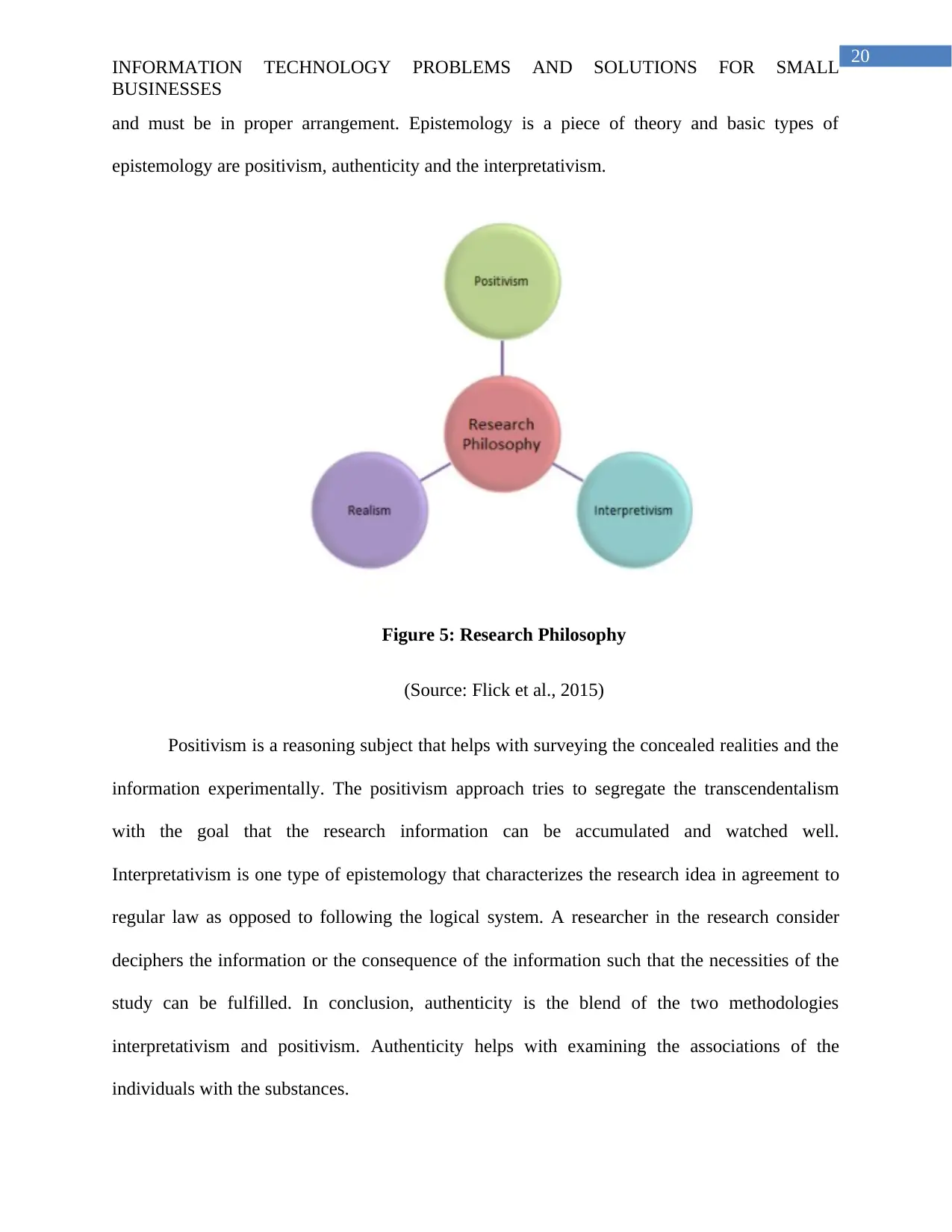
20
INFORMATION TECHNOLOGY PROBLEMS AND SOLUTIONS FOR SMALL
BUSINESSES
and must be in proper arrangement. Epistemology is a piece of theory and basic types of
epistemology are positivism, authenticity and the interpretativism.
Figure 5: Research Philosophy
(Source: Flick et al., 2015)
Positivism is a reasoning subject that helps with surveying the concealed realities and the
information experimentally. The positivism approach tries to segregate the transcendentalism
with the goal that the research information can be accumulated and watched well.
Interpretativism is one type of epistemology that characterizes the research idea in agreement to
regular law as opposed to following the logical system. A researcher in the research consider
deciphers the information or the consequence of the information such that the necessities of the
study can be fulfilled. In conclusion, authenticity is the blend of the two methodologies
interpretativism and positivism. Authenticity helps with examining the associations of the
individuals with the substances.
INFORMATION TECHNOLOGY PROBLEMS AND SOLUTIONS FOR SMALL
BUSINESSES
and must be in proper arrangement. Epistemology is a piece of theory and basic types of
epistemology are positivism, authenticity and the interpretativism.
Figure 5: Research Philosophy
(Source: Flick et al., 2015)
Positivism is a reasoning subject that helps with surveying the concealed realities and the
information experimentally. The positivism approach tries to segregate the transcendentalism
with the goal that the research information can be accumulated and watched well.
Interpretativism is one type of epistemology that characterizes the research idea in agreement to
regular law as opposed to following the logical system. A researcher in the research consider
deciphers the information or the consequence of the information such that the necessities of the
study can be fulfilled. In conclusion, authenticity is the blend of the two methodologies
interpretativism and positivism. Authenticity helps with examining the associations of the
individuals with the substances.
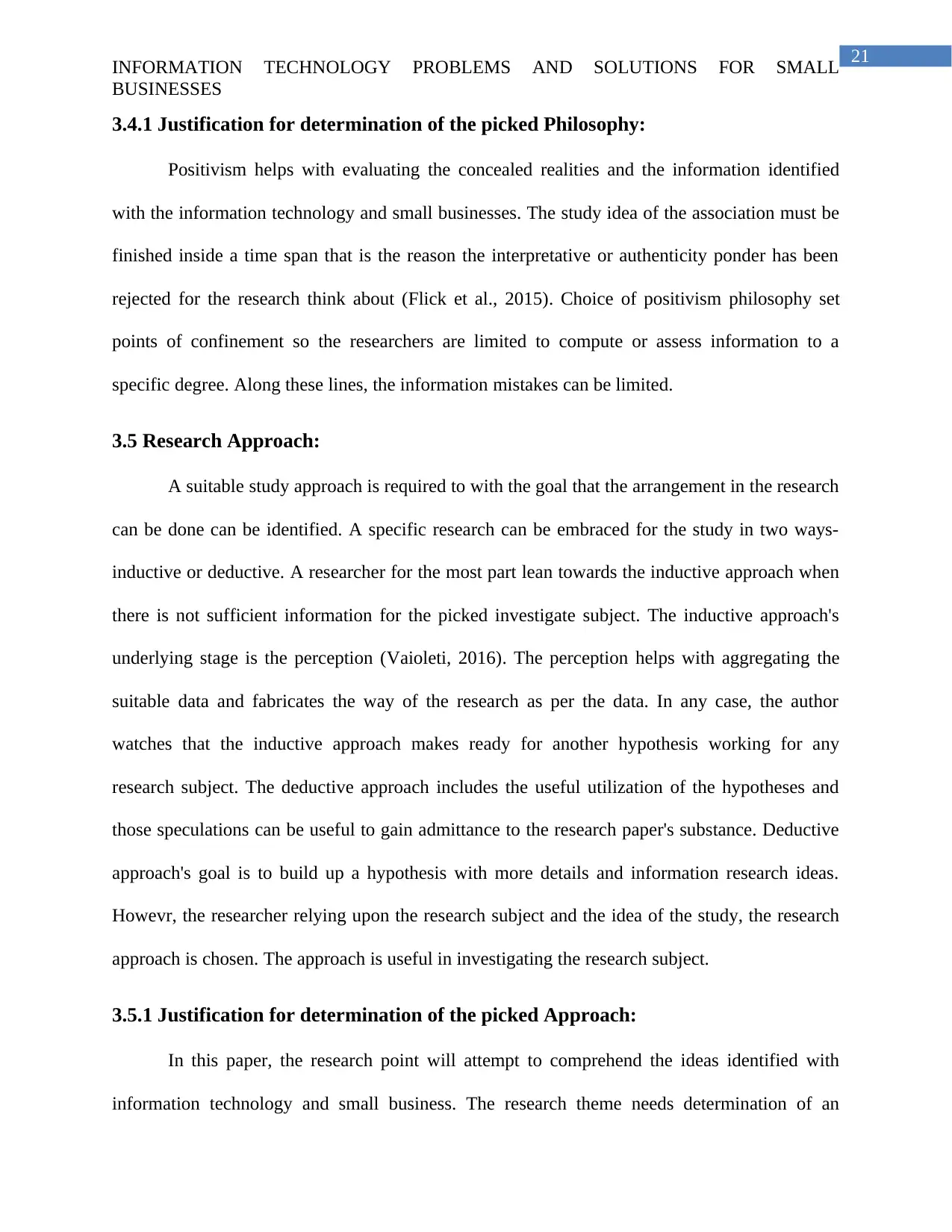
21
INFORMATION TECHNOLOGY PROBLEMS AND SOLUTIONS FOR SMALL
BUSINESSES
3.4.1 Justification for determination of the picked Philosophy:
Positivism helps with evaluating the concealed realities and the information identified
with the information technology and small businesses. The study idea of the association must be
finished inside a time span that is the reason the interpretative or authenticity ponder has been
rejected for the research think about (Flick et al., 2015). Choice of positivism philosophy set
points of confinement so the researchers are limited to compute or assess information to a
specific degree. Along these lines, the information mistakes can be limited.
3.5 Research Approach:
A suitable study approach is required to with the goal that the arrangement in the research
can be done can be identified. A specific research can be embraced for the study in two ways-
inductive or deductive. A researcher for the most part lean towards the inductive approach when
there is not sufficient information for the picked investigate subject. The inductive approach's
underlying stage is the perception (Vaioleti, 2016). The perception helps with aggregating the
suitable data and fabricates the way of the research as per the data. In any case, the author
watches that the inductive approach makes ready for another hypothesis working for any
research subject. The deductive approach includes the useful utilization of the hypotheses and
those speculations can be useful to gain admittance to the research paper's substance. Deductive
approach's goal is to build up a hypothesis with more details and information research ideas.
Howevr, the researcher relying upon the research subject and the idea of the study, the research
approach is chosen. The approach is useful in investigating the research subject.
3.5.1 Justification for determination of the picked Approach:
In this paper, the research point will attempt to comprehend the ideas identified with
information technology and small business. The research theme needs determination of an
INFORMATION TECHNOLOGY PROBLEMS AND SOLUTIONS FOR SMALL
BUSINESSES
3.4.1 Justification for determination of the picked Philosophy:
Positivism helps with evaluating the concealed realities and the information identified
with the information technology and small businesses. The study idea of the association must be
finished inside a time span that is the reason the interpretative or authenticity ponder has been
rejected for the research think about (Flick et al., 2015). Choice of positivism philosophy set
points of confinement so the researchers are limited to compute or assess information to a
specific degree. Along these lines, the information mistakes can be limited.
3.5 Research Approach:
A suitable study approach is required to with the goal that the arrangement in the research
can be done can be identified. A specific research can be embraced for the study in two ways-
inductive or deductive. A researcher for the most part lean towards the inductive approach when
there is not sufficient information for the picked investigate subject. The inductive approach's
underlying stage is the perception (Vaioleti, 2016). The perception helps with aggregating the
suitable data and fabricates the way of the research as per the data. In any case, the author
watches that the inductive approach makes ready for another hypothesis working for any
research subject. The deductive approach includes the useful utilization of the hypotheses and
those speculations can be useful to gain admittance to the research paper's substance. Deductive
approach's goal is to build up a hypothesis with more details and information research ideas.
Howevr, the researcher relying upon the research subject and the idea of the study, the research
approach is chosen. The approach is useful in investigating the research subject.
3.5.1 Justification for determination of the picked Approach:
In this paper, the research point will attempt to comprehend the ideas identified with
information technology and small business. The research theme needs determination of an
Secure Best Marks with AI Grader
Need help grading? Try our AI Grader for instant feedback on your assignments.
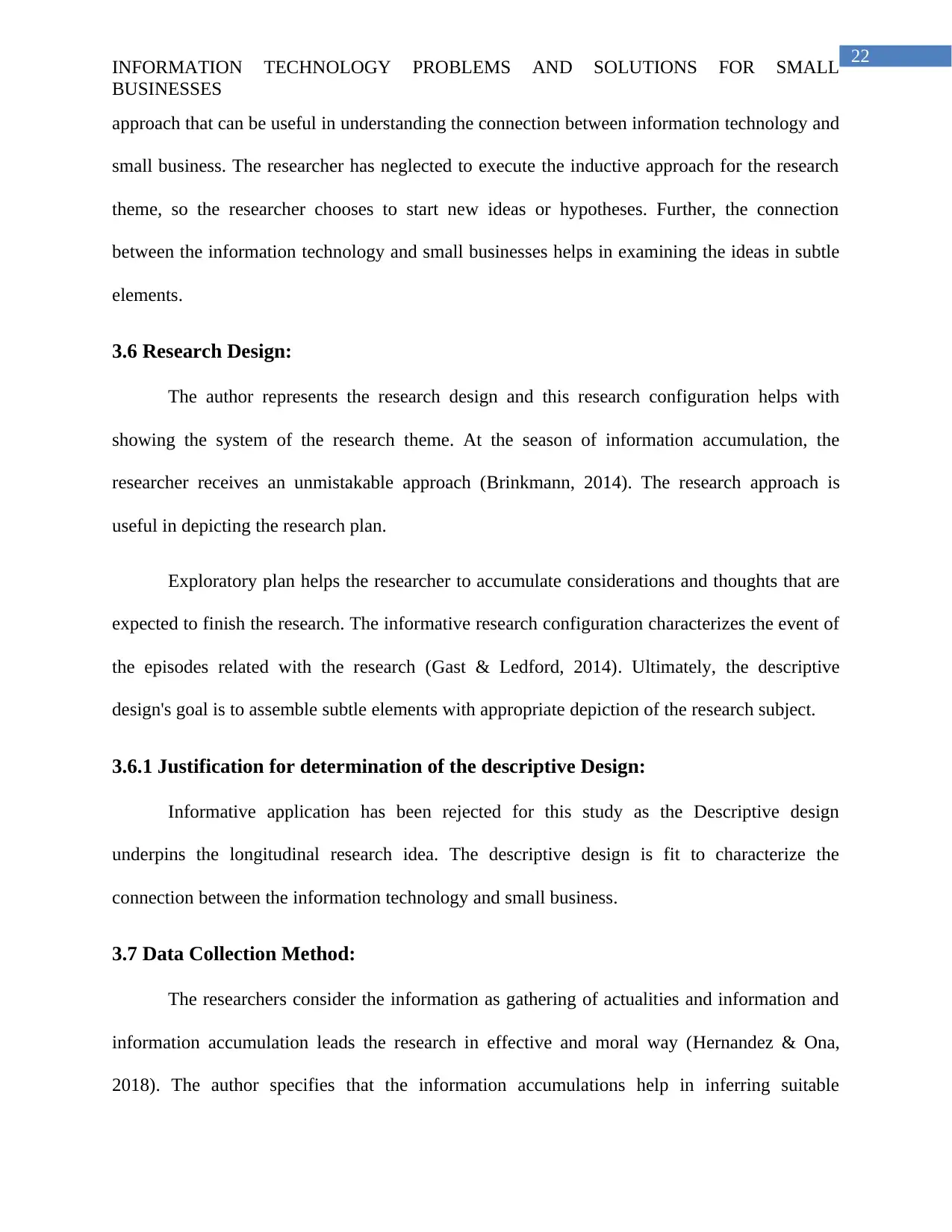
22
INFORMATION TECHNOLOGY PROBLEMS AND SOLUTIONS FOR SMALL
BUSINESSES
approach that can be useful in understanding the connection between information technology and
small business. The researcher has neglected to execute the inductive approach for the research
theme, so the researcher chooses to start new ideas or hypotheses. Further, the connection
between the information technology and small businesses helps in examining the ideas in subtle
elements.
3.6 Research Design:
The author represents the research design and this research configuration helps with
showing the system of the research theme. At the season of information accumulation, the
researcher receives an unmistakable approach (Brinkmann, 2014). The research approach is
useful in depicting the research plan.
Exploratory plan helps the researcher to accumulate considerations and thoughts that are
expected to finish the research. The informative research configuration characterizes the event of
the episodes related with the research (Gast & Ledford, 2014). Ultimately, the descriptive
design's goal is to assemble subtle elements with appropriate depiction of the research subject.
3.6.1 Justification for determination of the descriptive Design:
Informative application has been rejected for this study as the Descriptive design
underpins the longitudinal research idea. The descriptive design is fit to characterize the
connection between the information technology and small business.
3.7 Data Collection Method:
The researchers consider the information as gathering of actualities and information and
information accumulation leads the research in effective and moral way (Hernandez & Ona,
2018). The author specifies that the information accumulations help in inferring suitable
INFORMATION TECHNOLOGY PROBLEMS AND SOLUTIONS FOR SMALL
BUSINESSES
approach that can be useful in understanding the connection between information technology and
small business. The researcher has neglected to execute the inductive approach for the research
theme, so the researcher chooses to start new ideas or hypotheses. Further, the connection
between the information technology and small businesses helps in examining the ideas in subtle
elements.
3.6 Research Design:
The author represents the research design and this research configuration helps with
showing the system of the research theme. At the season of information accumulation, the
researcher receives an unmistakable approach (Brinkmann, 2014). The research approach is
useful in depicting the research plan.
Exploratory plan helps the researcher to accumulate considerations and thoughts that are
expected to finish the research. The informative research configuration characterizes the event of
the episodes related with the research (Gast & Ledford, 2014). Ultimately, the descriptive
design's goal is to assemble subtle elements with appropriate depiction of the research subject.
3.6.1 Justification for determination of the descriptive Design:
Informative application has been rejected for this study as the Descriptive design
underpins the longitudinal research idea. The descriptive design is fit to characterize the
connection between the information technology and small business.
3.7 Data Collection Method:
The researchers consider the information as gathering of actualities and information and
information accumulation leads the research in effective and moral way (Hernandez & Ona,
2018). The author specifies that the information accumulations help in inferring suitable
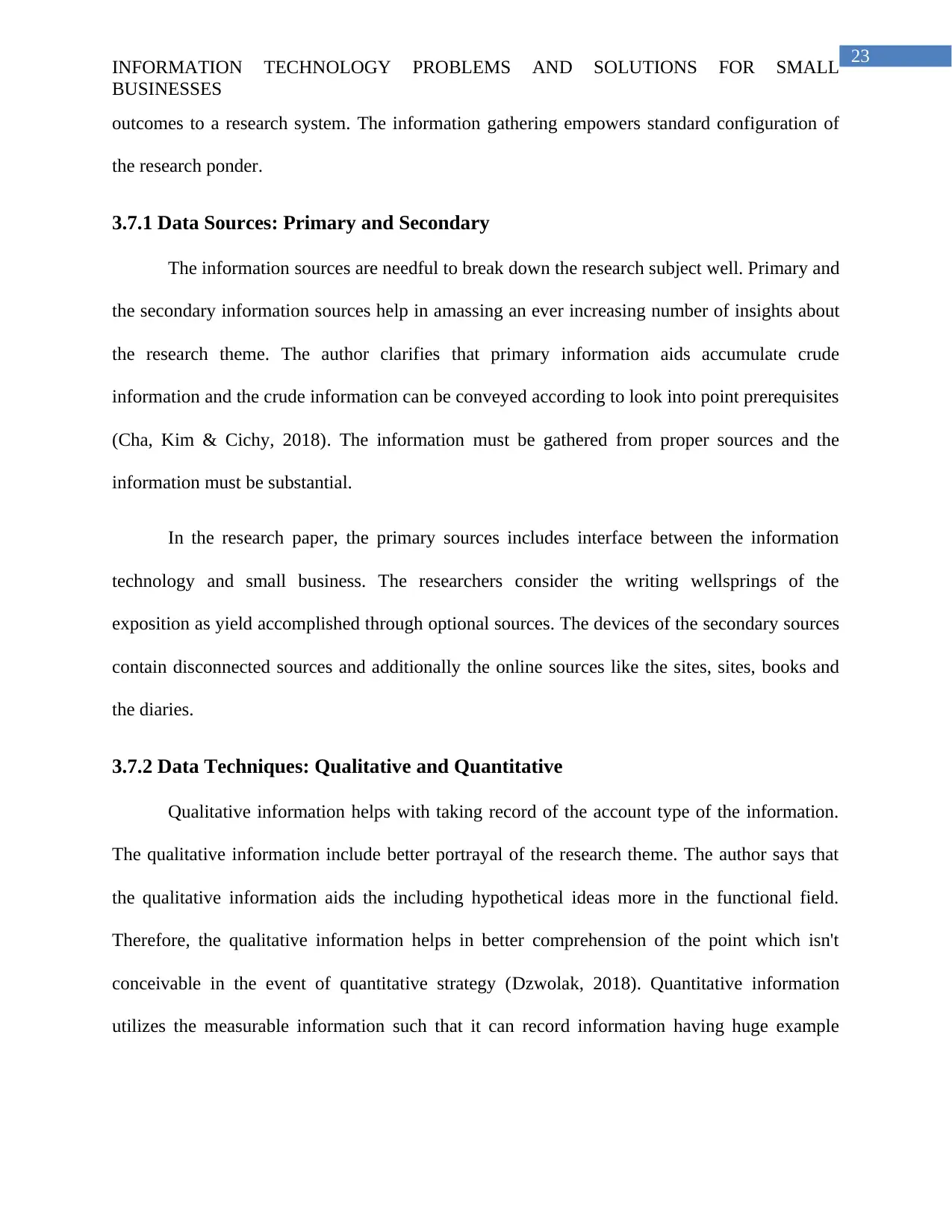
23
INFORMATION TECHNOLOGY PROBLEMS AND SOLUTIONS FOR SMALL
BUSINESSES
outcomes to a research system. The information gathering empowers standard configuration of
the research ponder.
3.7.1 Data Sources: Primary and Secondary
The information sources are needful to break down the research subject well. Primary and
the secondary information sources help in amassing an ever increasing number of insights about
the research theme. The author clarifies that primary information aids accumulate crude
information and the crude information can be conveyed according to look into point prerequisites
(Cha, Kim & Cichy, 2018). The information must be gathered from proper sources and the
information must be substantial.
In the research paper, the primary sources includes interface between the information
technology and small business. The researchers consider the writing wellsprings of the
exposition as yield accomplished through optional sources. The devices of the secondary sources
contain disconnected sources and additionally the online sources like the sites, sites, books and
the diaries.
3.7.2 Data Techniques: Qualitative and Quantitative
Qualitative information helps with taking record of the account type of the information.
The qualitative information include better portrayal of the research theme. The author says that
the qualitative information aids the including hypothetical ideas more in the functional field.
Therefore, the qualitative information helps in better comprehension of the point which isn't
conceivable in the event of quantitative strategy (Dzwolak, 2018). Quantitative information
utilizes the measurable information such that it can record information having huge example
INFORMATION TECHNOLOGY PROBLEMS AND SOLUTIONS FOR SMALL
BUSINESSES
outcomes to a research system. The information gathering empowers standard configuration of
the research ponder.
3.7.1 Data Sources: Primary and Secondary
The information sources are needful to break down the research subject well. Primary and
the secondary information sources help in amassing an ever increasing number of insights about
the research theme. The author clarifies that primary information aids accumulate crude
information and the crude information can be conveyed according to look into point prerequisites
(Cha, Kim & Cichy, 2018). The information must be gathered from proper sources and the
information must be substantial.
In the research paper, the primary sources includes interface between the information
technology and small business. The researchers consider the writing wellsprings of the
exposition as yield accomplished through optional sources. The devices of the secondary sources
contain disconnected sources and additionally the online sources like the sites, sites, books and
the diaries.
3.7.2 Data Techniques: Qualitative and Quantitative
Qualitative information helps with taking record of the account type of the information.
The qualitative information include better portrayal of the research theme. The author says that
the qualitative information aids the including hypothetical ideas more in the functional field.
Therefore, the qualitative information helps in better comprehension of the point which isn't
conceivable in the event of quantitative strategy (Dzwolak, 2018). Quantitative information
utilizes the measurable information such that it can record information having huge example
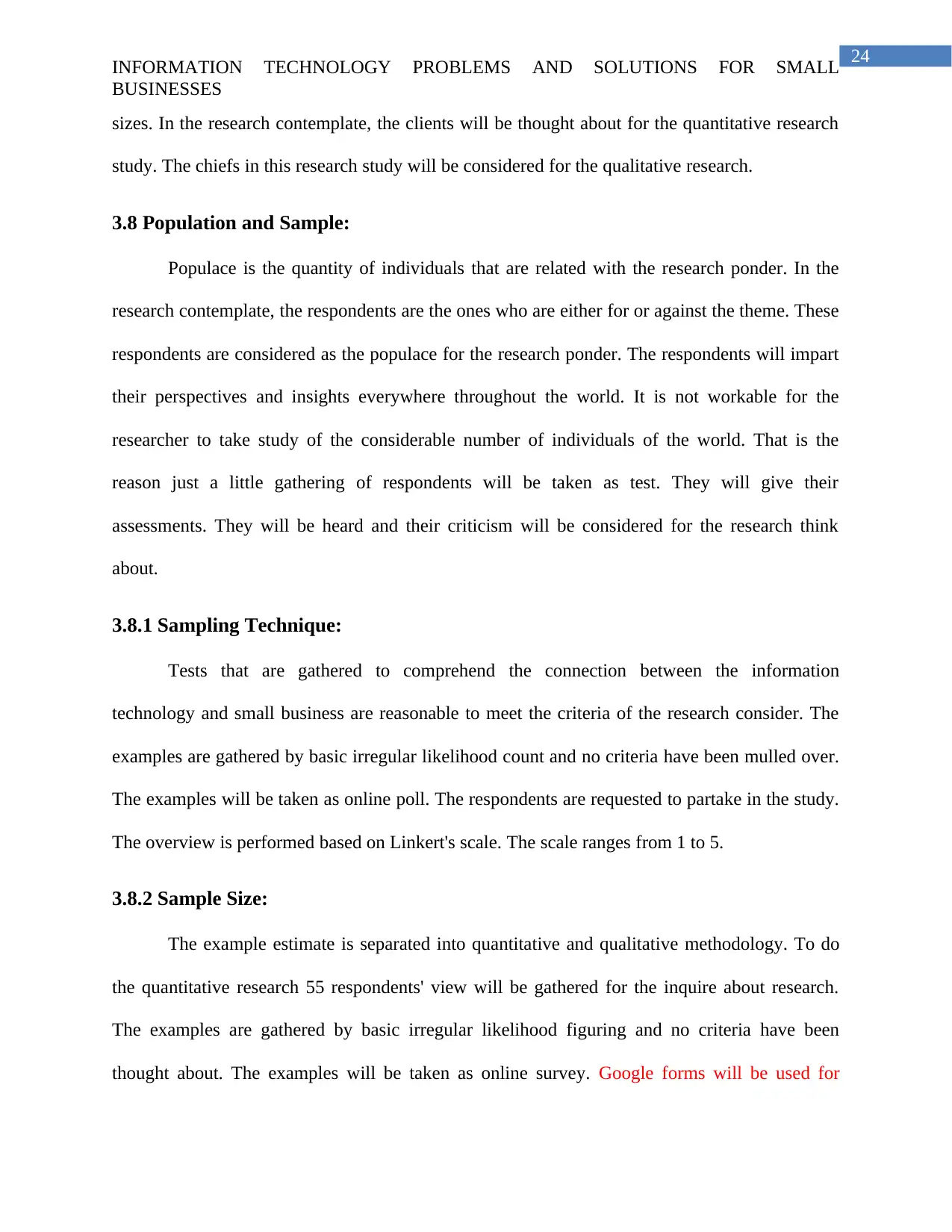
24
INFORMATION TECHNOLOGY PROBLEMS AND SOLUTIONS FOR SMALL
BUSINESSES
sizes. In the research contemplate, the clients will be thought about for the quantitative research
study. The chiefs in this research study will be considered for the qualitative research.
3.8 Population and Sample:
Populace is the quantity of individuals that are related with the research ponder. In the
research contemplate, the respondents are the ones who are either for or against the theme. These
respondents are considered as the populace for the research ponder. The respondents will impart
their perspectives and insights everywhere throughout the world. It is not workable for the
researcher to take study of the considerable number of individuals of the world. That is the
reason just a little gathering of respondents will be taken as test. They will give their
assessments. They will be heard and their criticism will be considered for the research think
about.
3.8.1 Sampling Technique:
Tests that are gathered to comprehend the connection between the information
technology and small business are reasonable to meet the criteria of the research consider. The
examples are gathered by basic irregular likelihood count and no criteria have been mulled over.
The examples will be taken as online poll. The respondents are requested to partake in the study.
The overview is performed based on Linkert's scale. The scale ranges from 1 to 5.
3.8.2 Sample Size:
The example estimate is separated into quantitative and qualitative methodology. To do
the quantitative research 55 respondents' view will be gathered for the inquire about research.
The examples are gathered by basic irregular likelihood figuring and no criteria have been
thought about. The examples will be taken as online survey. Google forms will be used for
INFORMATION TECHNOLOGY PROBLEMS AND SOLUTIONS FOR SMALL
BUSINESSES
sizes. In the research contemplate, the clients will be thought about for the quantitative research
study. The chiefs in this research study will be considered for the qualitative research.
3.8 Population and Sample:
Populace is the quantity of individuals that are related with the research ponder. In the
research contemplate, the respondents are the ones who are either for or against the theme. These
respondents are considered as the populace for the research ponder. The respondents will impart
their perspectives and insights everywhere throughout the world. It is not workable for the
researcher to take study of the considerable number of individuals of the world. That is the
reason just a little gathering of respondents will be taken as test. They will give their
assessments. They will be heard and their criticism will be considered for the research think
about.
3.8.1 Sampling Technique:
Tests that are gathered to comprehend the connection between the information
technology and small business are reasonable to meet the criteria of the research consider. The
examples are gathered by basic irregular likelihood count and no criteria have been mulled over.
The examples will be taken as online poll. The respondents are requested to partake in the study.
The overview is performed based on Linkert's scale. The scale ranges from 1 to 5.
3.8.2 Sample Size:
The example estimate is separated into quantitative and qualitative methodology. To do
the quantitative research 55 respondents' view will be gathered for the inquire about research.
The examples are gathered by basic irregular likelihood figuring and no criteria have been
thought about. The examples will be taken as online survey. Google forms will be used for
Paraphrase This Document
Need a fresh take? Get an instant paraphrase of this document with our AI Paraphraser
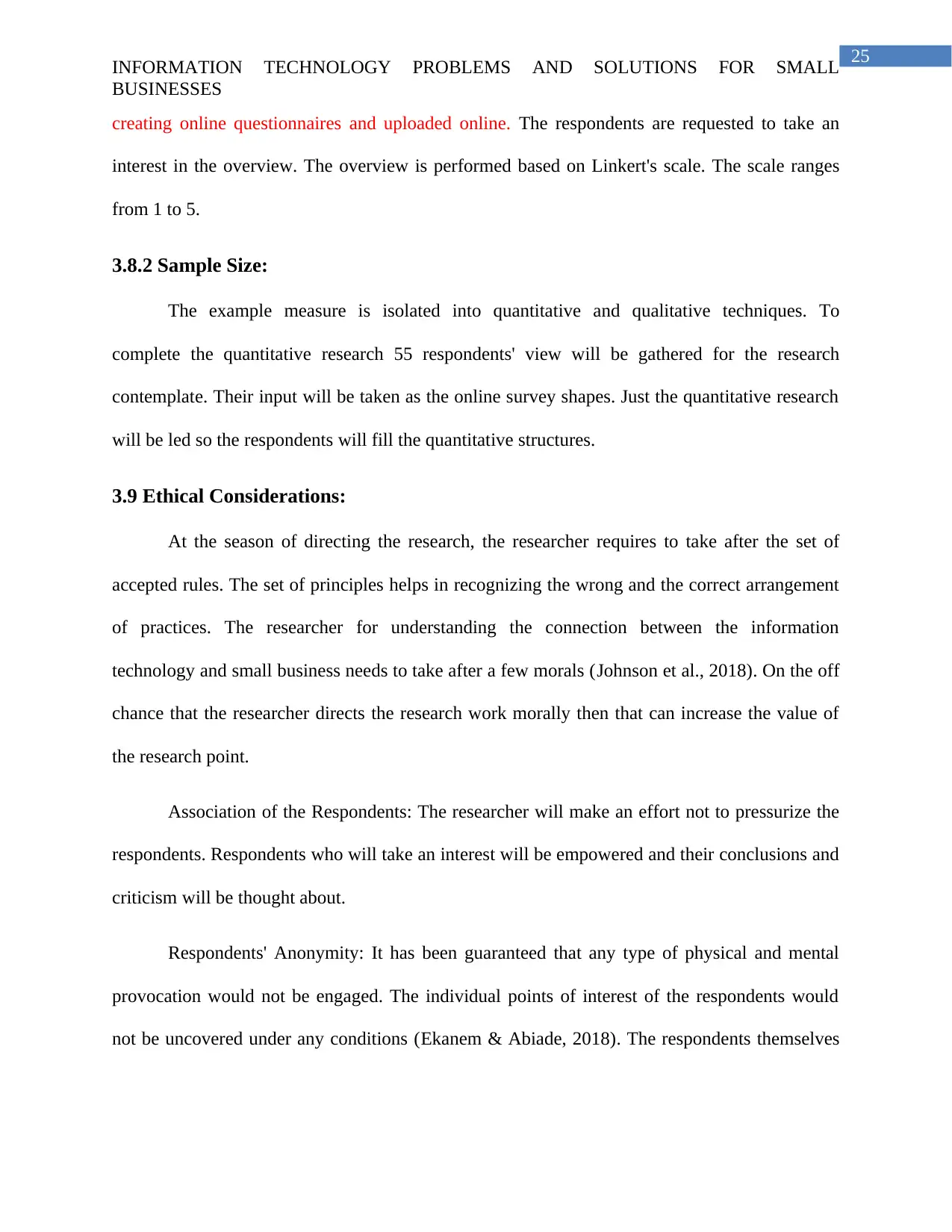
25
INFORMATION TECHNOLOGY PROBLEMS AND SOLUTIONS FOR SMALL
BUSINESSES
creating online questionnaires and uploaded online. The respondents are requested to take an
interest in the overview. The overview is performed based on Linkert's scale. The scale ranges
from 1 to 5.
3.8.2 Sample Size:
The example measure is isolated into quantitative and qualitative techniques. To
complete the quantitative research 55 respondents' view will be gathered for the research
contemplate. Their input will be taken as the online survey shapes. Just the quantitative research
will be led so the respondents will fill the quantitative structures.
3.9 Ethical Considerations:
At the season of directing the research, the researcher requires to take after the set of
accepted rules. The set of principles helps in recognizing the wrong and the correct arrangement
of practices. The researcher for understanding the connection between the information
technology and small business needs to take after a few morals (Johnson et al., 2018). On the off
chance that the researcher directs the research work morally then that can increase the value of
the research point.
Association of the Respondents: The researcher will make an effort not to pressurize the
respondents. Respondents who will take an interest will be empowered and their conclusions and
criticism will be thought about.
Respondents' Anonymity: It has been guaranteed that any type of physical and mental
provocation would not be engaged. The individual points of interest of the respondents would
not be uncovered under any conditions (Ekanem & Abiade, 2018). The respondents themselves
INFORMATION TECHNOLOGY PROBLEMS AND SOLUTIONS FOR SMALL
BUSINESSES
creating online questionnaires and uploaded online. The respondents are requested to take an
interest in the overview. The overview is performed based on Linkert's scale. The scale ranges
from 1 to 5.
3.8.2 Sample Size:
The example measure is isolated into quantitative and qualitative techniques. To
complete the quantitative research 55 respondents' view will be gathered for the research
contemplate. Their input will be taken as the online survey shapes. Just the quantitative research
will be led so the respondents will fill the quantitative structures.
3.9 Ethical Considerations:
At the season of directing the research, the researcher requires to take after the set of
accepted rules. The set of principles helps in recognizing the wrong and the correct arrangement
of practices. The researcher for understanding the connection between the information
technology and small business needs to take after a few morals (Johnson et al., 2018). On the off
chance that the researcher directs the research work morally then that can increase the value of
the research point.
Association of the Respondents: The researcher will make an effort not to pressurize the
respondents. Respondents who will take an interest will be empowered and their conclusions and
criticism will be thought about.
Respondents' Anonymity: It has been guaranteed that any type of physical and mental
provocation would not be engaged. The individual points of interest of the respondents would
not be uncovered under any conditions (Ekanem & Abiade, 2018). The respondents themselves
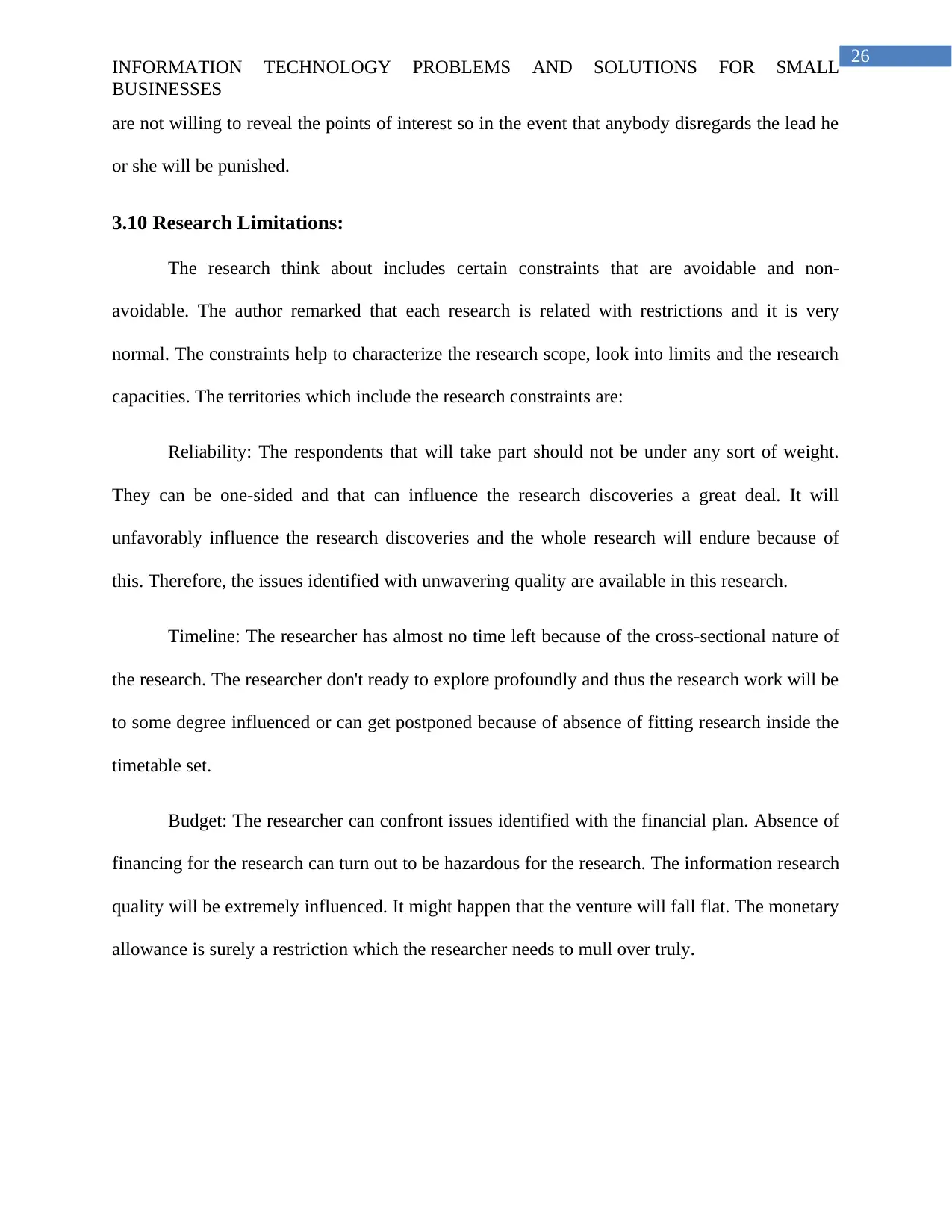
26
INFORMATION TECHNOLOGY PROBLEMS AND SOLUTIONS FOR SMALL
BUSINESSES
are not willing to reveal the points of interest so in the event that anybody disregards the lead he
or she will be punished.
3.10 Research Limitations:
The research think about includes certain constraints that are avoidable and non-
avoidable. The author remarked that each research is related with restrictions and it is very
normal. The constraints help to characterize the research scope, look into limits and the research
capacities. The territories which include the research constraints are:
Reliability: The respondents that will take part should not be under any sort of weight.
They can be one-sided and that can influence the research discoveries a great deal. It will
unfavorably influence the research discoveries and the whole research will endure because of
this. Therefore, the issues identified with unwavering quality are available in this research.
Timeline: The researcher has almost no time left because of the cross-sectional nature of
the research. The researcher don't ready to explore profoundly and thus the research work will be
to some degree influenced or can get postponed because of absence of fitting research inside the
timetable set.
Budget: The researcher can confront issues identified with the financial plan. Absence of
financing for the research can turn out to be hazardous for the research. The information research
quality will be extremely influenced. It might happen that the venture will fall flat. The monetary
allowance is surely a restriction which the researcher needs to mull over truly.
INFORMATION TECHNOLOGY PROBLEMS AND SOLUTIONS FOR SMALL
BUSINESSES
are not willing to reveal the points of interest so in the event that anybody disregards the lead he
or she will be punished.
3.10 Research Limitations:
The research think about includes certain constraints that are avoidable and non-
avoidable. The author remarked that each research is related with restrictions and it is very
normal. The constraints help to characterize the research scope, look into limits and the research
capacities. The territories which include the research constraints are:
Reliability: The respondents that will take part should not be under any sort of weight.
They can be one-sided and that can influence the research discoveries a great deal. It will
unfavorably influence the research discoveries and the whole research will endure because of
this. Therefore, the issues identified with unwavering quality are available in this research.
Timeline: The researcher has almost no time left because of the cross-sectional nature of
the research. The researcher don't ready to explore profoundly and thus the research work will be
to some degree influenced or can get postponed because of absence of fitting research inside the
timetable set.
Budget: The researcher can confront issues identified with the financial plan. Absence of
financing for the research can turn out to be hazardous for the research. The information research
quality will be extremely influenced. It might happen that the venture will fall flat. The monetary
allowance is surely a restriction which the researcher needs to mull over truly.
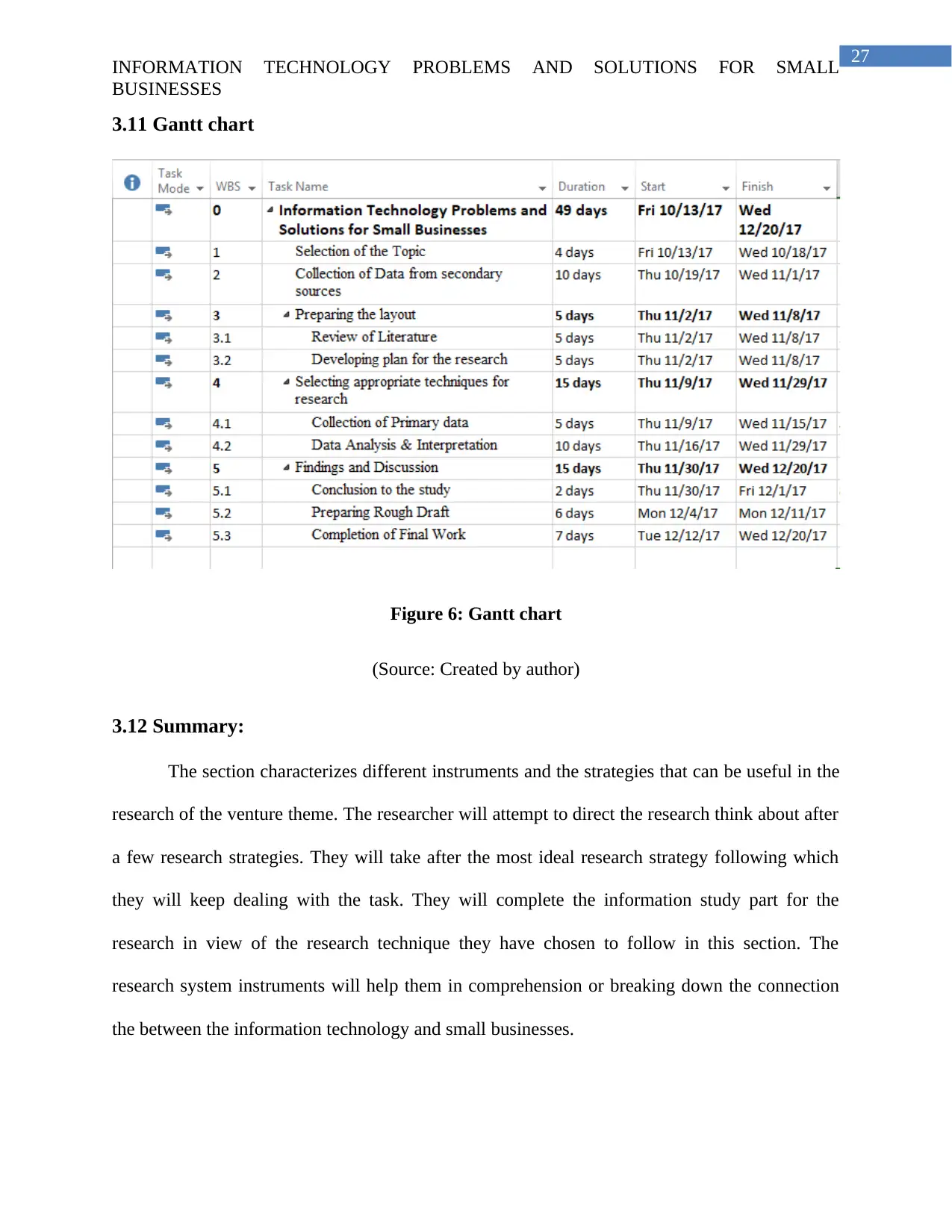
27
INFORMATION TECHNOLOGY PROBLEMS AND SOLUTIONS FOR SMALL
BUSINESSES
3.11 Gantt chart
Figure 6: Gantt chart
(Source: Created by author)
3.12 Summary:
The section characterizes different instruments and the strategies that can be useful in the
research of the venture theme. The researcher will attempt to direct the research think about after
a few research strategies. They will take after the most ideal research strategy following which
they will keep dealing with the task. They will complete the information study part for the
research in view of the research technique they have chosen to follow in this section. The
research system instruments will help them in comprehension or breaking down the connection
the between the information technology and small businesses.
INFORMATION TECHNOLOGY PROBLEMS AND SOLUTIONS FOR SMALL
BUSINESSES
3.11 Gantt chart
Figure 6: Gantt chart
(Source: Created by author)
3.12 Summary:
The section characterizes different instruments and the strategies that can be useful in the
research of the venture theme. The researcher will attempt to direct the research think about after
a few research strategies. They will take after the most ideal research strategy following which
they will keep dealing with the task. They will complete the information study part for the
research in view of the research technique they have chosen to follow in this section. The
research system instruments will help them in comprehension or breaking down the connection
the between the information technology and small businesses.
Secure Best Marks with AI Grader
Need help grading? Try our AI Grader for instant feedback on your assignments.
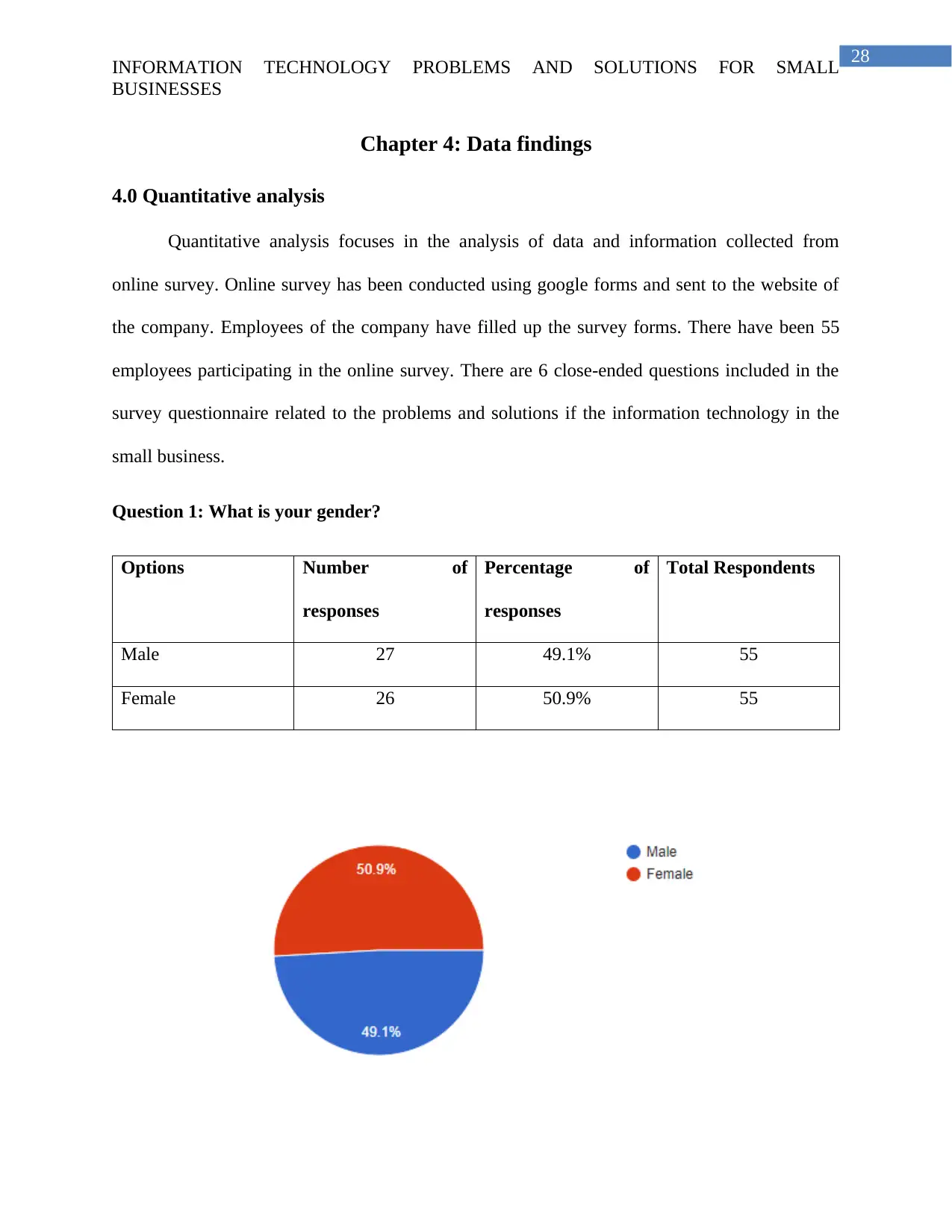
28
INFORMATION TECHNOLOGY PROBLEMS AND SOLUTIONS FOR SMALL
BUSINESSES
Chapter 4: Data findings
4.0 Quantitative analysis
Quantitative analysis focuses in the analysis of data and information collected from
online survey. Online survey has been conducted using google forms and sent to the website of
the company. Employees of the company have filled up the survey forms. There have been 55
employees participating in the online survey. There are 6 close-ended questions included in the
survey questionnaire related to the problems and solutions if the information technology in the
small business.
Question 1: What is your gender?
Options Number of
responses
Percentage of
responses
Total Respondents
Male 27 49.1% 55
Female 26 50.9% 55
INFORMATION TECHNOLOGY PROBLEMS AND SOLUTIONS FOR SMALL
BUSINESSES
Chapter 4: Data findings
4.0 Quantitative analysis
Quantitative analysis focuses in the analysis of data and information collected from
online survey. Online survey has been conducted using google forms and sent to the website of
the company. Employees of the company have filled up the survey forms. There have been 55
employees participating in the online survey. There are 6 close-ended questions included in the
survey questionnaire related to the problems and solutions if the information technology in the
small business.
Question 1: What is your gender?
Options Number of
responses
Percentage of
responses
Total Respondents
Male 27 49.1% 55
Female 26 50.9% 55
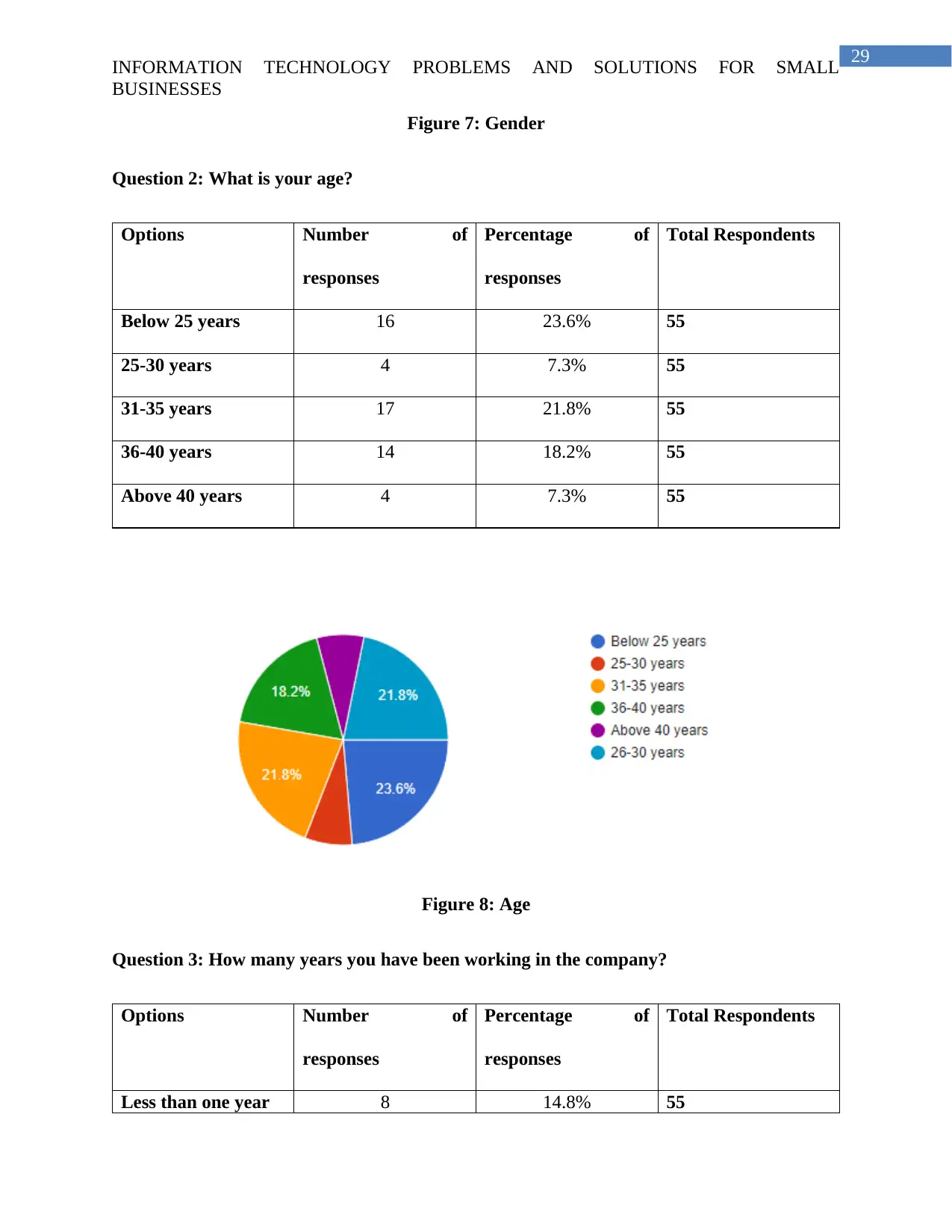
29
INFORMATION TECHNOLOGY PROBLEMS AND SOLUTIONS FOR SMALL
BUSINESSES
Figure 7: Gender
Question 2: What is your age?
Options Number of
responses
Percentage of
responses
Total Respondents
Below 25 years 16 23.6% 55
25-30 years 4 7.3% 55
31-35 years 17 21.8% 55
36-40 years 14 18.2% 55
Above 40 years 4 7.3% 55
Figure 8: Age
Question 3: How many years you have been working in the company?
Options Number of
responses
Percentage of
responses
Total Respondents
Less than one year 8 14.8% 55
INFORMATION TECHNOLOGY PROBLEMS AND SOLUTIONS FOR SMALL
BUSINESSES
Figure 7: Gender
Question 2: What is your age?
Options Number of
responses
Percentage of
responses
Total Respondents
Below 25 years 16 23.6% 55
25-30 years 4 7.3% 55
31-35 years 17 21.8% 55
36-40 years 14 18.2% 55
Above 40 years 4 7.3% 55
Figure 8: Age
Question 3: How many years you have been working in the company?
Options Number of
responses
Percentage of
responses
Total Respondents
Less than one year 8 14.8% 55
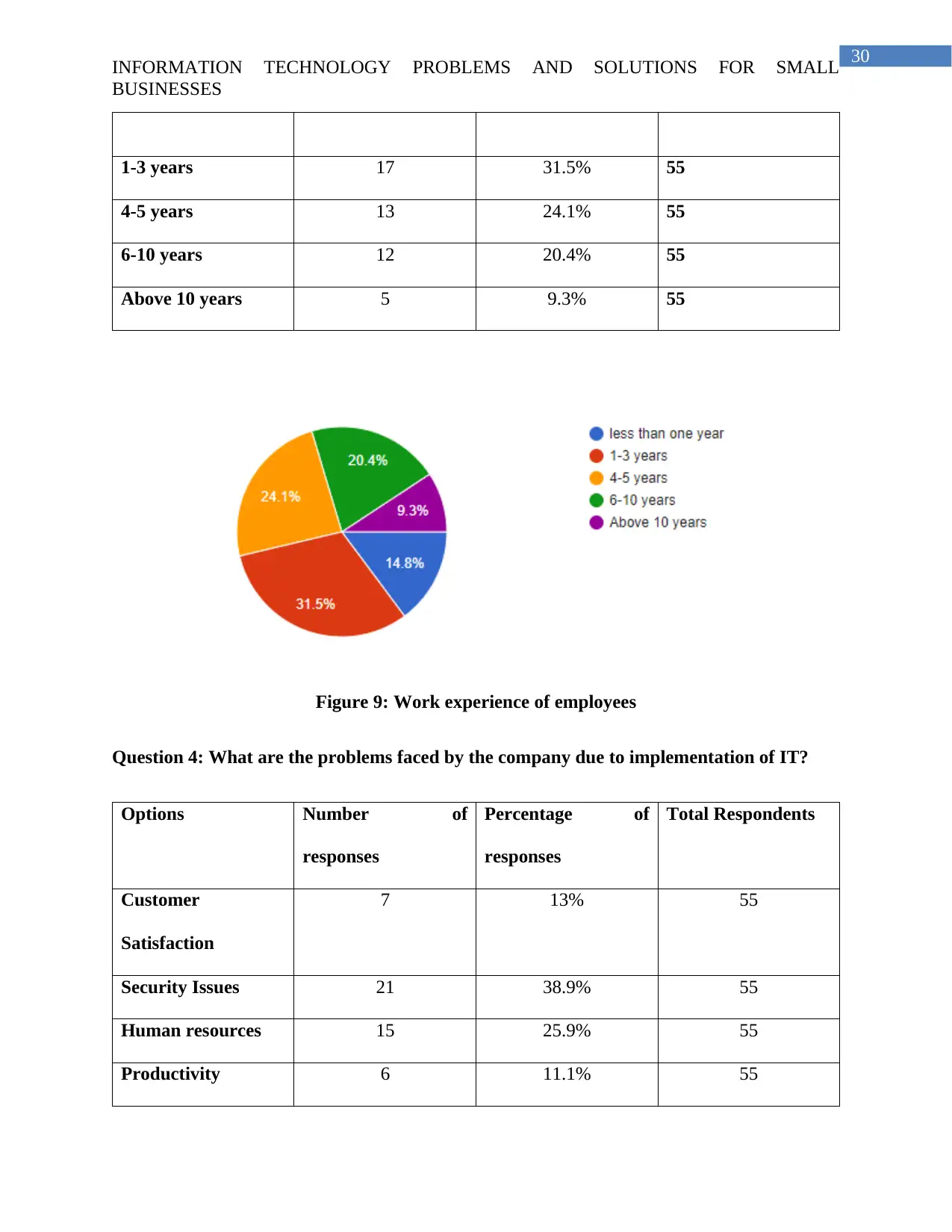
30
INFORMATION TECHNOLOGY PROBLEMS AND SOLUTIONS FOR SMALL
BUSINESSES
1-3 years 17 31.5% 55
4-5 years 13 24.1% 55
6-10 years 12 20.4% 55
Above 10 years 5 9.3% 55
Figure 9: Work experience of employees
Question 4: What are the problems faced by the company due to implementation of IT?
Options Number of
responses
Percentage of
responses
Total Respondents
Customer
Satisfaction
7 13% 55
Security Issues 21 38.9% 55
Human resources 15 25.9% 55
Productivity 6 11.1% 55
INFORMATION TECHNOLOGY PROBLEMS AND SOLUTIONS FOR SMALL
BUSINESSES
1-3 years 17 31.5% 55
4-5 years 13 24.1% 55
6-10 years 12 20.4% 55
Above 10 years 5 9.3% 55
Figure 9: Work experience of employees
Question 4: What are the problems faced by the company due to implementation of IT?
Options Number of
responses
Percentage of
responses
Total Respondents
Customer
Satisfaction
7 13% 55
Security Issues 21 38.9% 55
Human resources 15 25.9% 55
Productivity 6 11.1% 55
Paraphrase This Document
Need a fresh take? Get an instant paraphrase of this document with our AI Paraphraser
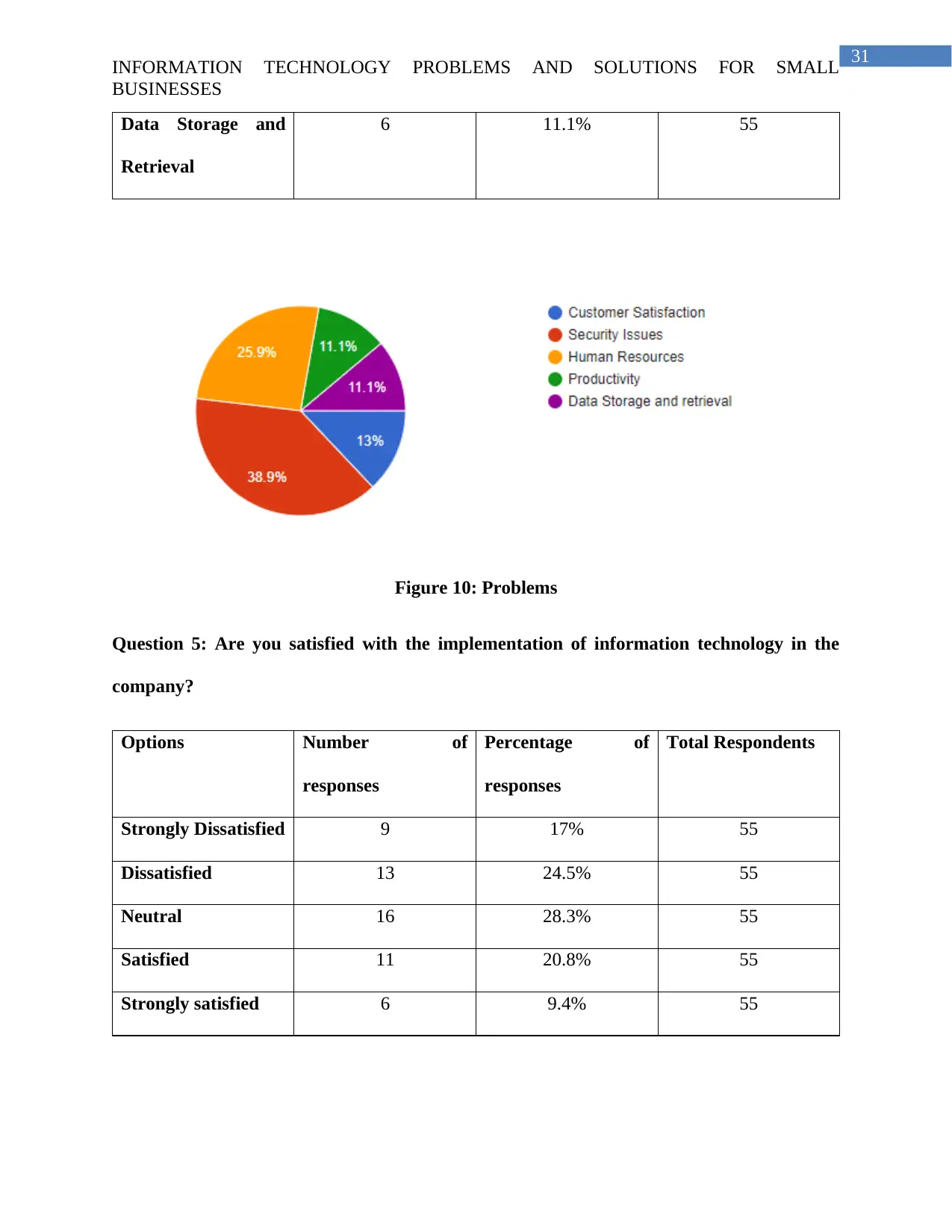
31
INFORMATION TECHNOLOGY PROBLEMS AND SOLUTIONS FOR SMALL
BUSINESSES
Data Storage and
Retrieval
6 11.1% 55
Figure 10: Problems
Question 5: Are you satisfied with the implementation of information technology in the
company?
Options Number of
responses
Percentage of
responses
Total Respondents
Strongly Dissatisfied 9 17% 55
Dissatisfied 13 24.5% 55
Neutral 16 28.3% 55
Satisfied 11 20.8% 55
Strongly satisfied 6 9.4% 55
INFORMATION TECHNOLOGY PROBLEMS AND SOLUTIONS FOR SMALL
BUSINESSES
Data Storage and
Retrieval
6 11.1% 55
Figure 10: Problems
Question 5: Are you satisfied with the implementation of information technology in the
company?
Options Number of
responses
Percentage of
responses
Total Respondents
Strongly Dissatisfied 9 17% 55
Dissatisfied 13 24.5% 55
Neutral 16 28.3% 55
Satisfied 11 20.8% 55
Strongly satisfied 6 9.4% 55
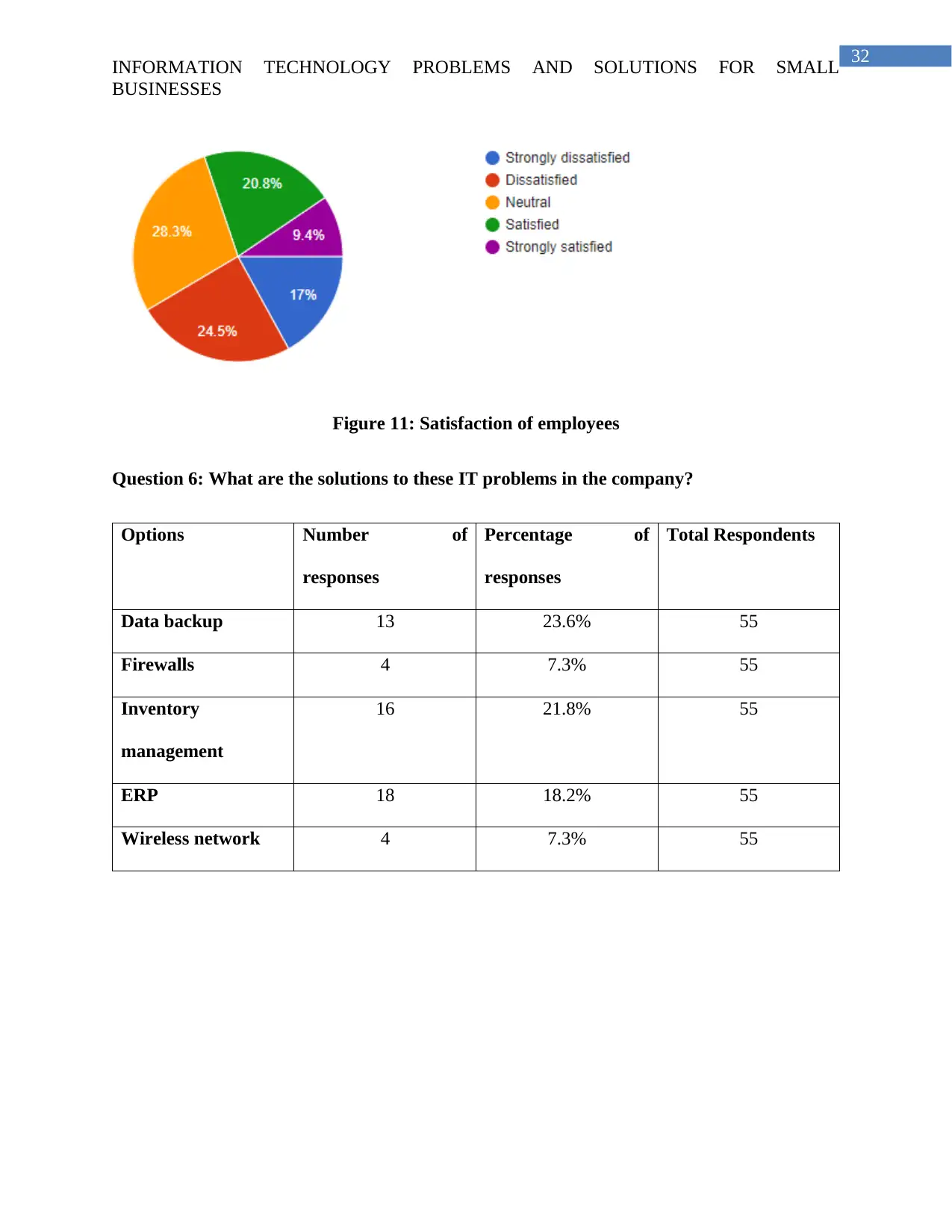
32
INFORMATION TECHNOLOGY PROBLEMS AND SOLUTIONS FOR SMALL
BUSINESSES
Figure 11: Satisfaction of employees
Question 6: What are the solutions to these IT problems in the company?
Options Number of
responses
Percentage of
responses
Total Respondents
Data backup 13 23.6% 55
Firewalls 4 7.3% 55
Inventory
management
16 21.8% 55
ERP 18 18.2% 55
Wireless network 4 7.3% 55
INFORMATION TECHNOLOGY PROBLEMS AND SOLUTIONS FOR SMALL
BUSINESSES
Figure 11: Satisfaction of employees
Question 6: What are the solutions to these IT problems in the company?
Options Number of
responses
Percentage of
responses
Total Respondents
Data backup 13 23.6% 55
Firewalls 4 7.3% 55
Inventory
management
16 21.8% 55
ERP 18 18.2% 55
Wireless network 4 7.3% 55
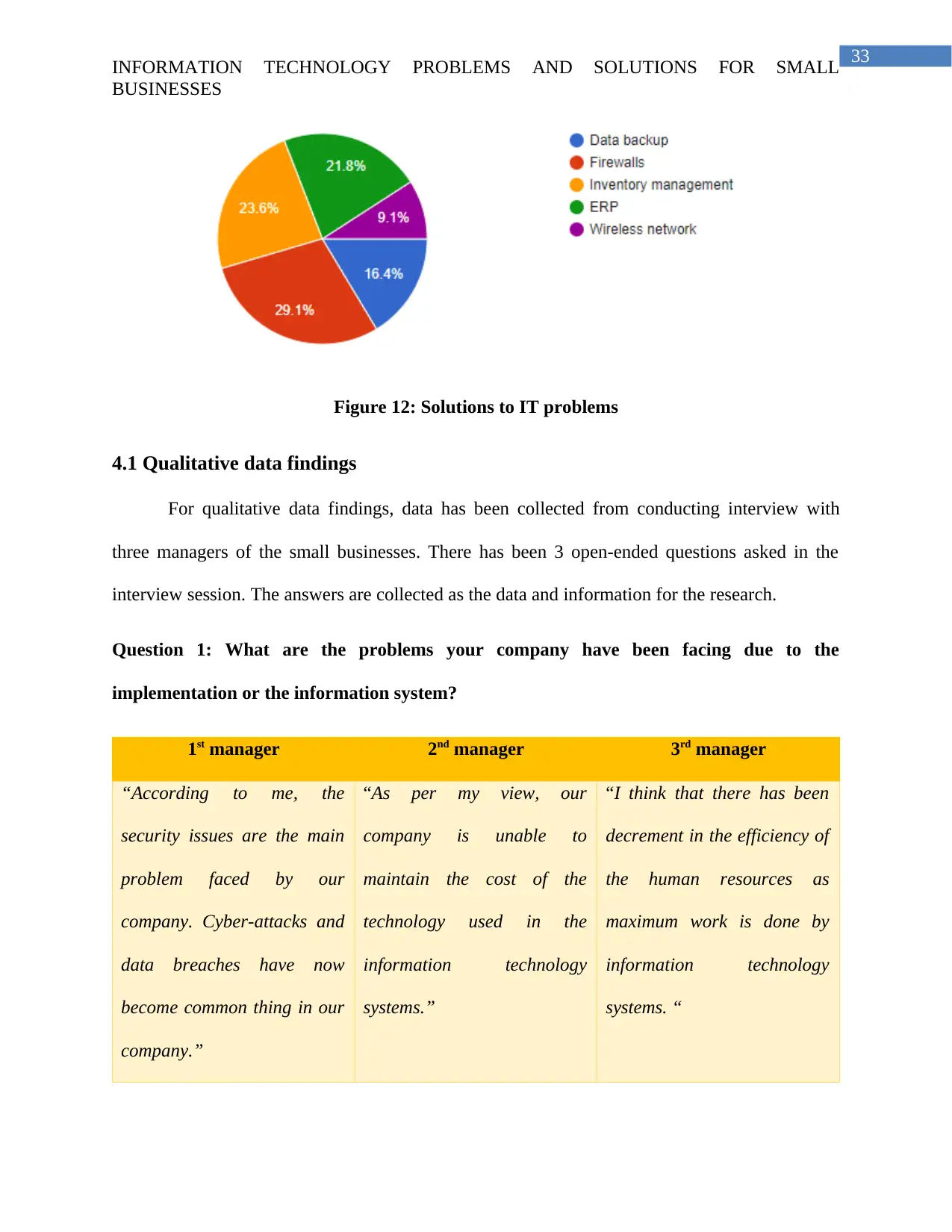
33
INFORMATION TECHNOLOGY PROBLEMS AND SOLUTIONS FOR SMALL
BUSINESSES
Figure 12: Solutions to IT problems
4.1 Qualitative data findings
For qualitative data findings, data has been collected from conducting interview with
three managers of the small businesses. There has been 3 open-ended questions asked in the
interview session. The answers are collected as the data and information for the research.
Question 1: What are the problems your company have been facing due to the
implementation or the information system?
1st manager 2nd manager 3rd manager
“According to me, the
security issues are the main
problem faced by our
company. Cyber-attacks and
data breaches have now
become common thing in our
company.”
“As per my view, our
company is unable to
maintain the cost of the
technology used in the
information technology
systems.”
“I think that there has been
decrement in the efficiency of
the human resources as
maximum work is done by
information technology
systems. “
INFORMATION TECHNOLOGY PROBLEMS AND SOLUTIONS FOR SMALL
BUSINESSES
Figure 12: Solutions to IT problems
4.1 Qualitative data findings
For qualitative data findings, data has been collected from conducting interview with
three managers of the small businesses. There has been 3 open-ended questions asked in the
interview session. The answers are collected as the data and information for the research.
Question 1: What are the problems your company have been facing due to the
implementation or the information system?
1st manager 2nd manager 3rd manager
“According to me, the
security issues are the main
problem faced by our
company. Cyber-attacks and
data breaches have now
become common thing in our
company.”
“As per my view, our
company is unable to
maintain the cost of the
technology used in the
information technology
systems.”
“I think that there has been
decrement in the efficiency of
the human resources as
maximum work is done by
information technology
systems. “
Secure Best Marks with AI Grader
Need help grading? Try our AI Grader for instant feedback on your assignments.
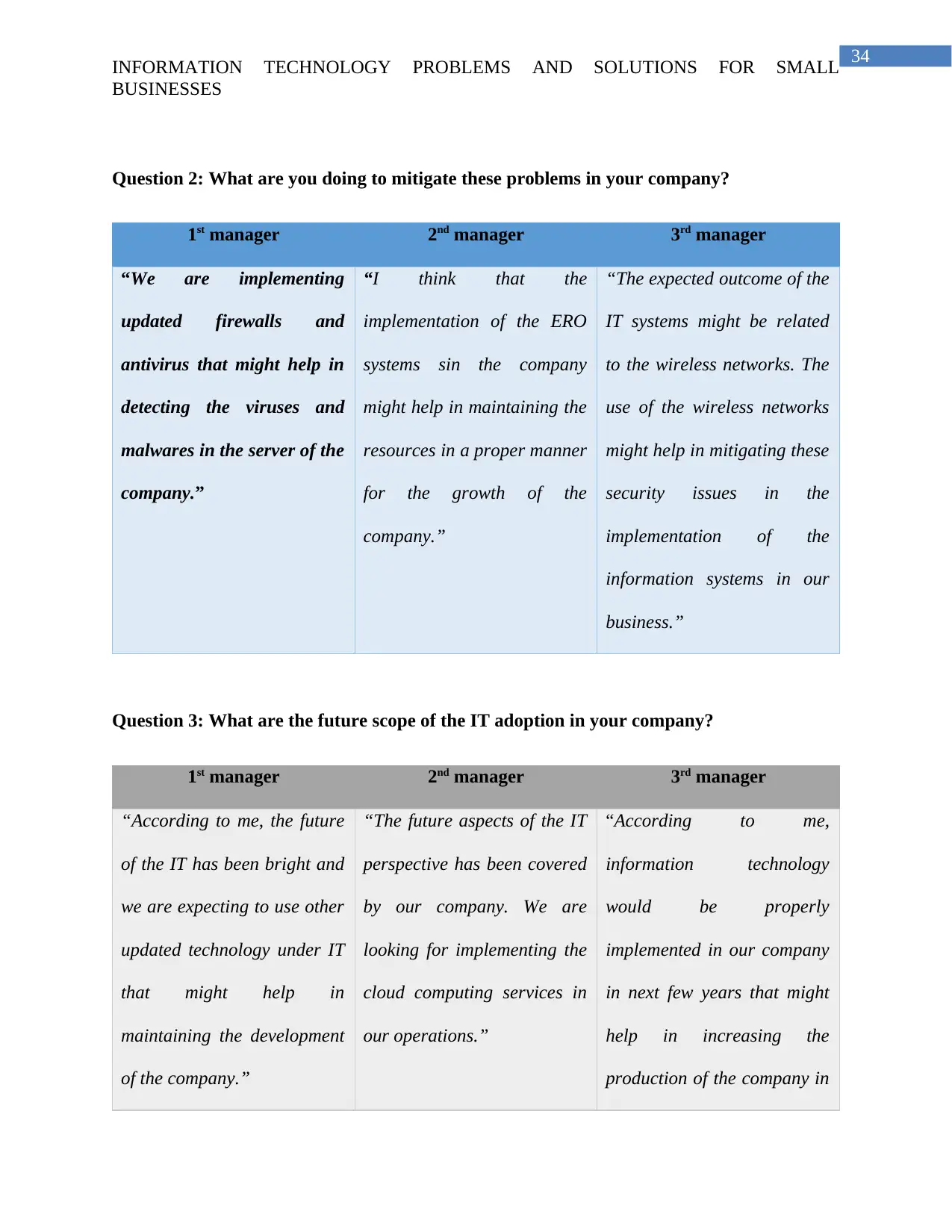
34
INFORMATION TECHNOLOGY PROBLEMS AND SOLUTIONS FOR SMALL
BUSINESSES
Question 2: What are you doing to mitigate these problems in your company?
1st manager 2nd manager 3rd manager
“We are implementing
updated firewalls and
antivirus that might help in
detecting the viruses and
malwares in the server of the
company.”
“I think that the
implementation of the ERO
systems sin the company
might help in maintaining the
resources in a proper manner
for the growth of the
company.”
“The expected outcome of the
IT systems might be related
to the wireless networks. The
use of the wireless networks
might help in mitigating these
security issues in the
implementation of the
information systems in our
business.”
Question 3: What are the future scope of the IT adoption in your company?
1st manager 2nd manager 3rd manager
“According to me, the future
of the IT has been bright and
we are expecting to use other
updated technology under IT
that might help in
maintaining the development
of the company.”
“The future aspects of the IT
perspective has been covered
by our company. We are
looking for implementing the
cloud computing services in
our operations.”
“According to me,
information technology
would be properly
implemented in our company
in next few years that might
help in increasing the
production of the company in
INFORMATION TECHNOLOGY PROBLEMS AND SOLUTIONS FOR SMALL
BUSINESSES
Question 2: What are you doing to mitigate these problems in your company?
1st manager 2nd manager 3rd manager
“We are implementing
updated firewalls and
antivirus that might help in
detecting the viruses and
malwares in the server of the
company.”
“I think that the
implementation of the ERO
systems sin the company
might help in maintaining the
resources in a proper manner
for the growth of the
company.”
“The expected outcome of the
IT systems might be related
to the wireless networks. The
use of the wireless networks
might help in mitigating these
security issues in the
implementation of the
information systems in our
business.”
Question 3: What are the future scope of the IT adoption in your company?
1st manager 2nd manager 3rd manager
“According to me, the future
of the IT has been bright and
we are expecting to use other
updated technology under IT
that might help in
maintaining the development
of the company.”
“The future aspects of the IT
perspective has been covered
by our company. We are
looking for implementing the
cloud computing services in
our operations.”
“According to me,
information technology
would be properly
implemented in our company
in next few years that might
help in increasing the
production of the company in

35
INFORMATION TECHNOLOGY PROBLEMS AND SOLUTIONS FOR SMALL
BUSINESSES
the market.”
INFORMATION TECHNOLOGY PROBLEMS AND SOLUTIONS FOR SMALL
BUSINESSES
the market.”
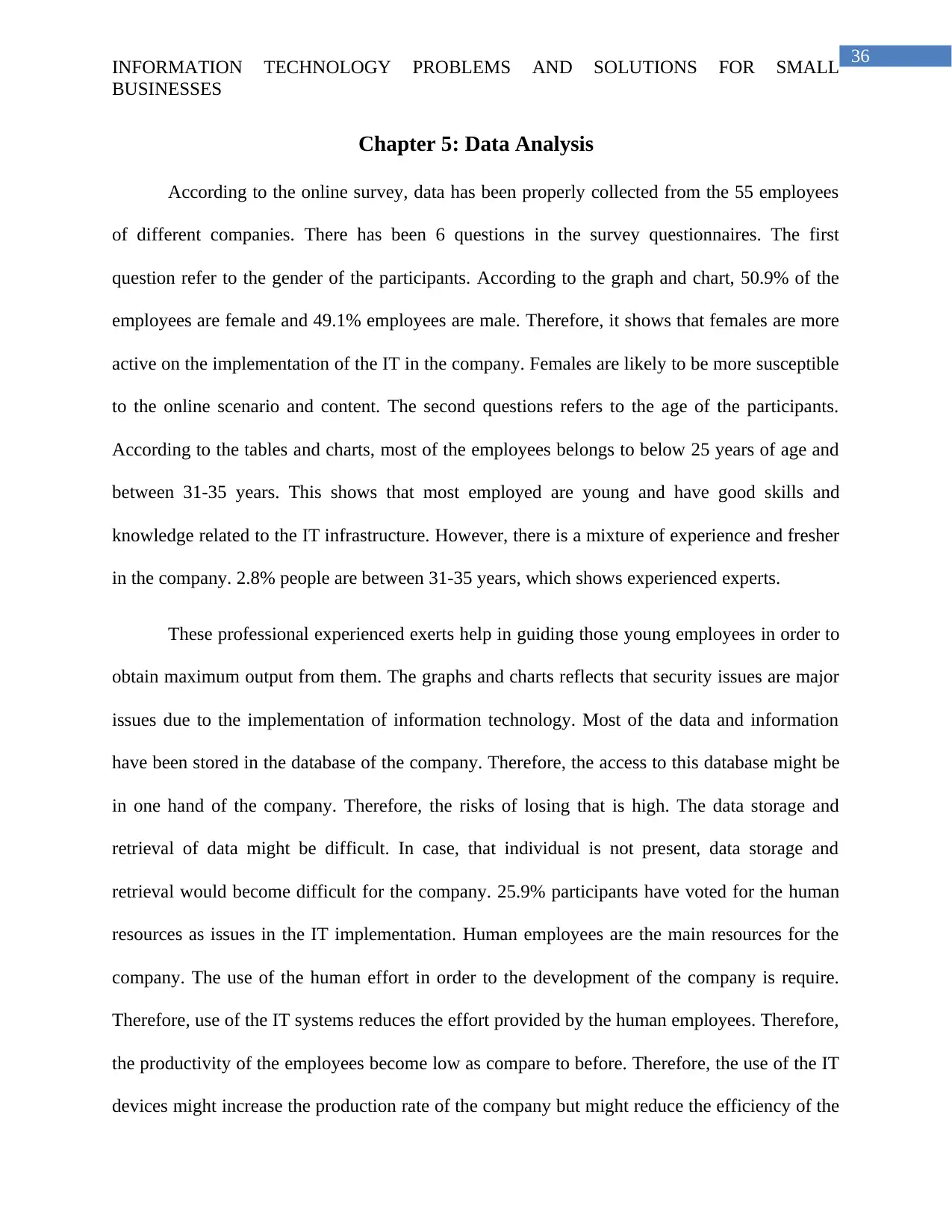
36
INFORMATION TECHNOLOGY PROBLEMS AND SOLUTIONS FOR SMALL
BUSINESSES
Chapter 5: Data Analysis
According to the online survey, data has been properly collected from the 55 employees
of different companies. There has been 6 questions in the survey questionnaires. The first
question refer to the gender of the participants. According to the graph and chart, 50.9% of the
employees are female and 49.1% employees are male. Therefore, it shows that females are more
active on the implementation of the IT in the company. Females are likely to be more susceptible
to the online scenario and content. The second questions refers to the age of the participants.
According to the tables and charts, most of the employees belongs to below 25 years of age and
between 31-35 years. This shows that most employed are young and have good skills and
knowledge related to the IT infrastructure. However, there is a mixture of experience and fresher
in the company. 2.8% people are between 31-35 years, which shows experienced experts.
These professional experienced exerts help in guiding those young employees in order to
obtain maximum output from them. The graphs and charts reflects that security issues are major
issues due to the implementation of information technology. Most of the data and information
have been stored in the database of the company. Therefore, the access to this database might be
in one hand of the company. Therefore, the risks of losing that is high. The data storage and
retrieval of data might be difficult. In case, that individual is not present, data storage and
retrieval would become difficult for the company. 25.9% participants have voted for the human
resources as issues in the IT implementation. Human employees are the main resources for the
company. The use of the human effort in order to the development of the company is require.
Therefore, use of the IT systems reduces the effort provided by the human employees. Therefore,
the productivity of the employees become low as compare to before. Therefore, the use of the IT
devices might increase the production rate of the company but might reduce the efficiency of the
INFORMATION TECHNOLOGY PROBLEMS AND SOLUTIONS FOR SMALL
BUSINESSES
Chapter 5: Data Analysis
According to the online survey, data has been properly collected from the 55 employees
of different companies. There has been 6 questions in the survey questionnaires. The first
question refer to the gender of the participants. According to the graph and chart, 50.9% of the
employees are female and 49.1% employees are male. Therefore, it shows that females are more
active on the implementation of the IT in the company. Females are likely to be more susceptible
to the online scenario and content. The second questions refers to the age of the participants.
According to the tables and charts, most of the employees belongs to below 25 years of age and
between 31-35 years. This shows that most employed are young and have good skills and
knowledge related to the IT infrastructure. However, there is a mixture of experience and fresher
in the company. 2.8% people are between 31-35 years, which shows experienced experts.
These professional experienced exerts help in guiding those young employees in order to
obtain maximum output from them. The graphs and charts reflects that security issues are major
issues due to the implementation of information technology. Most of the data and information
have been stored in the database of the company. Therefore, the access to this database might be
in one hand of the company. Therefore, the risks of losing that is high. The data storage and
retrieval of data might be difficult. In case, that individual is not present, data storage and
retrieval would become difficult for the company. 25.9% participants have voted for the human
resources as issues in the IT implementation. Human employees are the main resources for the
company. The use of the human effort in order to the development of the company is require.
Therefore, use of the IT systems reduces the effort provided by the human employees. Therefore,
the productivity of the employees become low as compare to before. Therefore, the use of the IT
devices might increase the production rate of the company but might reduce the efficiency of the
Paraphrase This Document
Need a fresh take? Get an instant paraphrase of this document with our AI Paraphraser
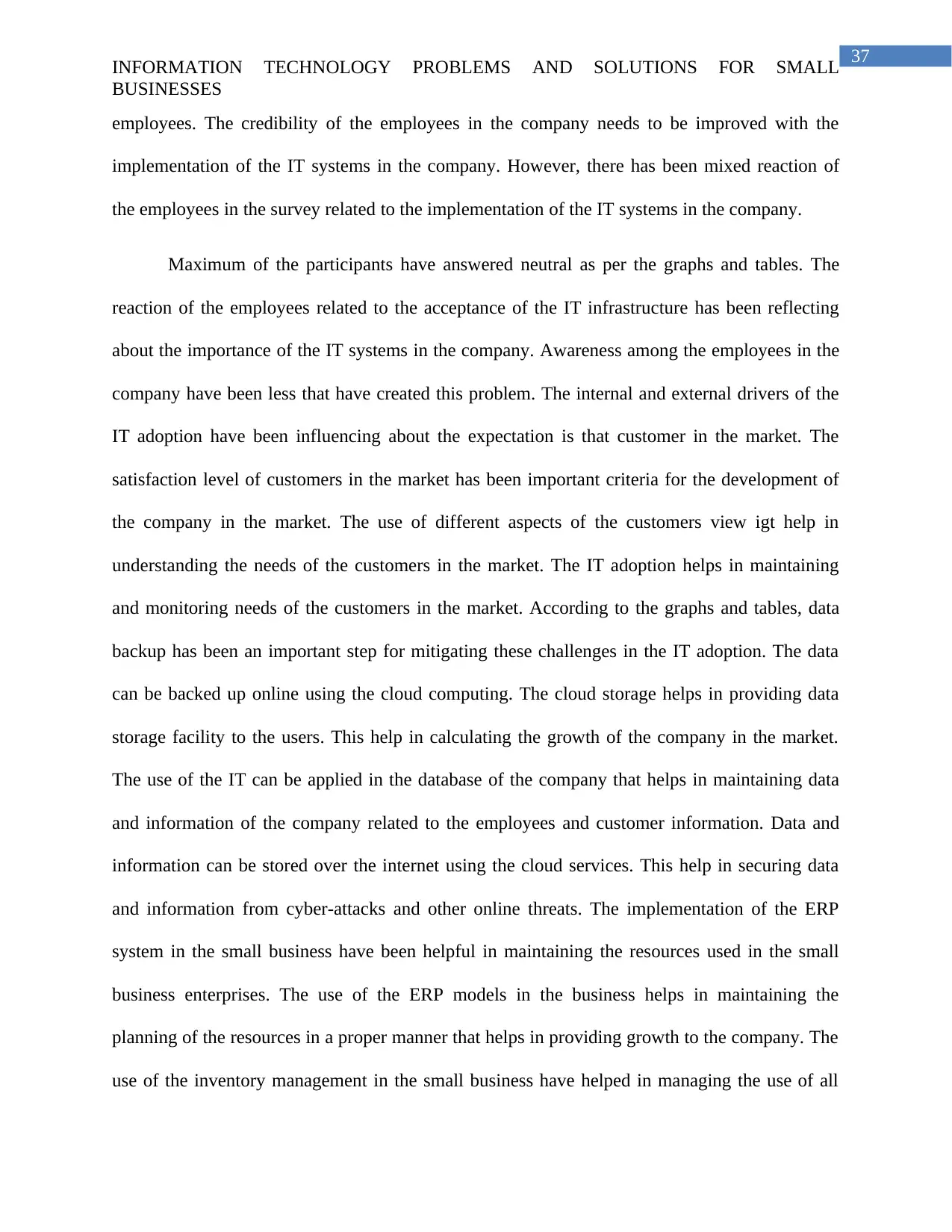
37
INFORMATION TECHNOLOGY PROBLEMS AND SOLUTIONS FOR SMALL
BUSINESSES
employees. The credibility of the employees in the company needs to be improved with the
implementation of the IT systems in the company. However, there has been mixed reaction of
the employees in the survey related to the implementation of the IT systems in the company.
Maximum of the participants have answered neutral as per the graphs and tables. The
reaction of the employees related to the acceptance of the IT infrastructure has been reflecting
about the importance of the IT systems in the company. Awareness among the employees in the
company have been less that have created this problem. The internal and external drivers of the
IT adoption have been influencing about the expectation is that customer in the market. The
satisfaction level of customers in the market has been important criteria for the development of
the company in the market. The use of different aspects of the customers view igt help in
understanding the needs of the customers in the market. The IT adoption helps in maintaining
and monitoring needs of the customers in the market. According to the graphs and tables, data
backup has been an important step for mitigating these challenges in the IT adoption. The data
can be backed up online using the cloud computing. The cloud storage helps in providing data
storage facility to the users. This help in calculating the growth of the company in the market.
The use of the IT can be applied in the database of the company that helps in maintaining data
and information of the company related to the employees and customer information. Data and
information can be stored over the internet using the cloud services. This help in securing data
and information from cyber-attacks and other online threats. The implementation of the ERP
system in the small business have been helpful in maintaining the resources used in the small
business enterprises. The use of the ERP models in the business helps in maintaining the
planning of the resources in a proper manner that helps in providing growth to the company. The
use of the inventory management in the small business have helped in managing the use of all
INFORMATION TECHNOLOGY PROBLEMS AND SOLUTIONS FOR SMALL
BUSINESSES
employees. The credibility of the employees in the company needs to be improved with the
implementation of the IT systems in the company. However, there has been mixed reaction of
the employees in the survey related to the implementation of the IT systems in the company.
Maximum of the participants have answered neutral as per the graphs and tables. The
reaction of the employees related to the acceptance of the IT infrastructure has been reflecting
about the importance of the IT systems in the company. Awareness among the employees in the
company have been less that have created this problem. The internal and external drivers of the
IT adoption have been influencing about the expectation is that customer in the market. The
satisfaction level of customers in the market has been important criteria for the development of
the company in the market. The use of different aspects of the customers view igt help in
understanding the needs of the customers in the market. The IT adoption helps in maintaining
and monitoring needs of the customers in the market. According to the graphs and tables, data
backup has been an important step for mitigating these challenges in the IT adoption. The data
can be backed up online using the cloud computing. The cloud storage helps in providing data
storage facility to the users. This help in calculating the growth of the company in the market.
The use of the IT can be applied in the database of the company that helps in maintaining data
and information of the company related to the employees and customer information. Data and
information can be stored over the internet using the cloud services. This help in securing data
and information from cyber-attacks and other online threats. The implementation of the ERP
system in the small business have been helpful in maintaining the resources used in the small
business enterprises. The use of the ERP models in the business helps in maintaining the
planning of the resources in a proper manner that helps in providing growth to the company. The
use of the inventory management in the small business have helped in managing the use of all
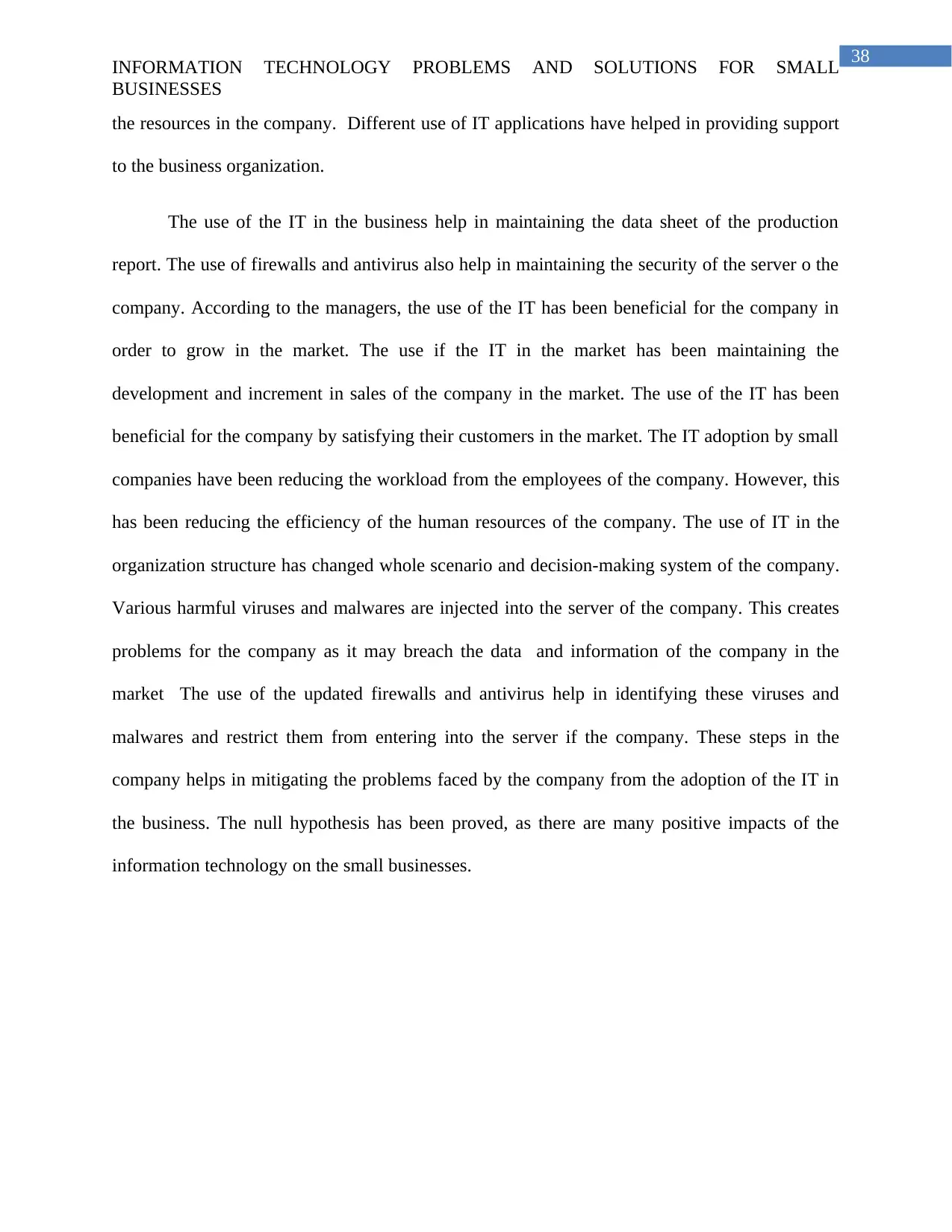
38
INFORMATION TECHNOLOGY PROBLEMS AND SOLUTIONS FOR SMALL
BUSINESSES
the resources in the company. Different use of IT applications have helped in providing support
to the business organization.
The use of the IT in the business help in maintaining the data sheet of the production
report. The use of firewalls and antivirus also help in maintaining the security of the server o the
company. According to the managers, the use of the IT has been beneficial for the company in
order to grow in the market. The use if the IT in the market has been maintaining the
development and increment in sales of the company in the market. The use of the IT has been
beneficial for the company by satisfying their customers in the market. The IT adoption by small
companies have been reducing the workload from the employees of the company. However, this
has been reducing the efficiency of the human resources of the company. The use of IT in the
organization structure has changed whole scenario and decision-making system of the company.
Various harmful viruses and malwares are injected into the server of the company. This creates
problems for the company as it may breach the data and information of the company in the
market The use of the updated firewalls and antivirus help in identifying these viruses and
malwares and restrict them from entering into the server if the company. These steps in the
company helps in mitigating the problems faced by the company from the adoption of the IT in
the business. The null hypothesis has been proved, as there are many positive impacts of the
information technology on the small businesses.
INFORMATION TECHNOLOGY PROBLEMS AND SOLUTIONS FOR SMALL
BUSINESSES
the resources in the company. Different use of IT applications have helped in providing support
to the business organization.
The use of the IT in the business help in maintaining the data sheet of the production
report. The use of firewalls and antivirus also help in maintaining the security of the server o the
company. According to the managers, the use of the IT has been beneficial for the company in
order to grow in the market. The use if the IT in the market has been maintaining the
development and increment in sales of the company in the market. The use of the IT has been
beneficial for the company by satisfying their customers in the market. The IT adoption by small
companies have been reducing the workload from the employees of the company. However, this
has been reducing the efficiency of the human resources of the company. The use of IT in the
organization structure has changed whole scenario and decision-making system of the company.
Various harmful viruses and malwares are injected into the server of the company. This creates
problems for the company as it may breach the data and information of the company in the
market The use of the updated firewalls and antivirus help in identifying these viruses and
malwares and restrict them from entering into the server if the company. These steps in the
company helps in mitigating the problems faced by the company from the adoption of the IT in
the business. The null hypothesis has been proved, as there are many positive impacts of the
information technology on the small businesses.
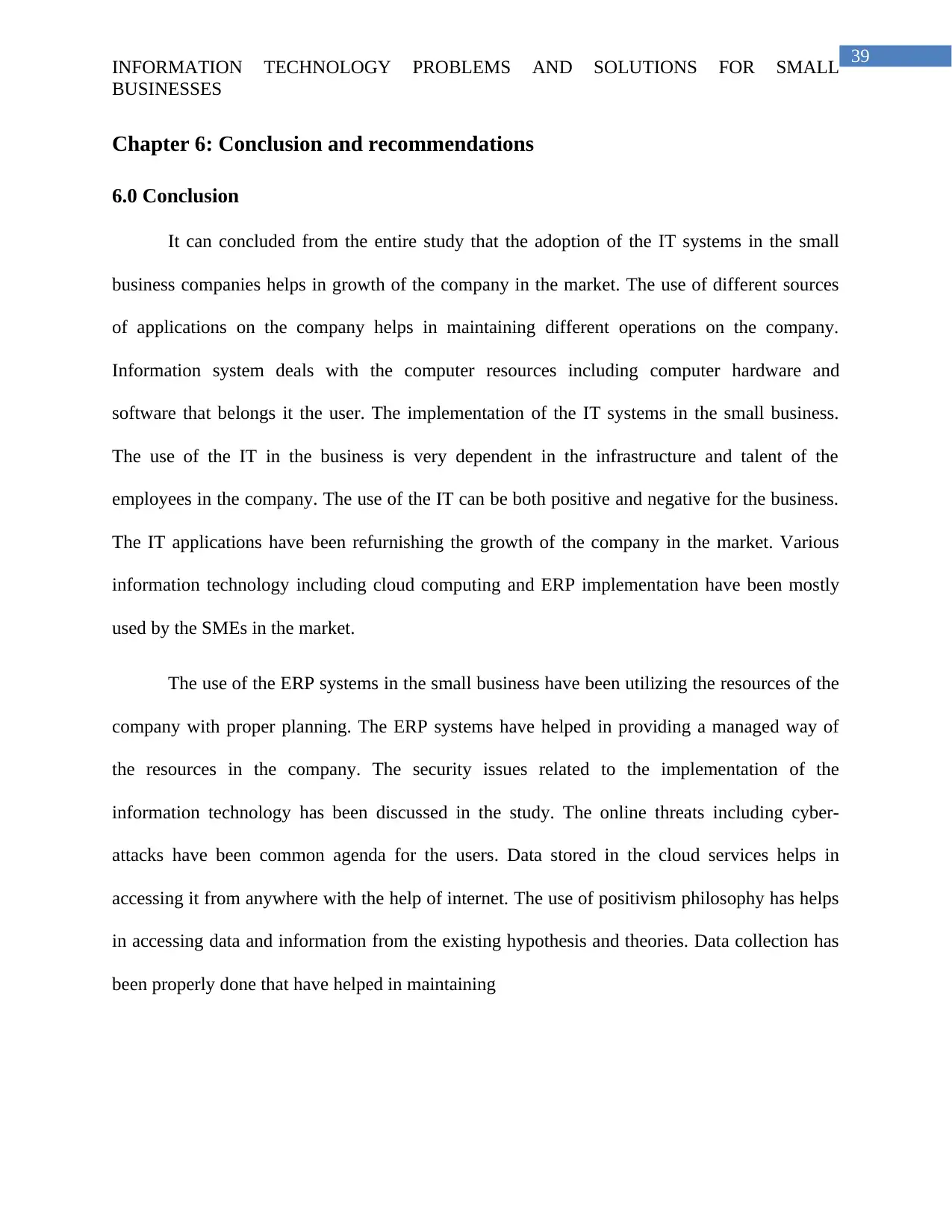
39
INFORMATION TECHNOLOGY PROBLEMS AND SOLUTIONS FOR SMALL
BUSINESSES
Chapter 6: Conclusion and recommendations
6.0 Conclusion
It can concluded from the entire study that the adoption of the IT systems in the small
business companies helps in growth of the company in the market. The use of different sources
of applications on the company helps in maintaining different operations on the company.
Information system deals with the computer resources including computer hardware and
software that belongs it the user. The implementation of the IT systems in the small business.
The use of the IT in the business is very dependent in the infrastructure and talent of the
employees in the company. The use of the IT can be both positive and negative for the business.
The IT applications have been refurnishing the growth of the company in the market. Various
information technology including cloud computing and ERP implementation have been mostly
used by the SMEs in the market.
The use of the ERP systems in the small business have been utilizing the resources of the
company with proper planning. The ERP systems have helped in providing a managed way of
the resources in the company. The security issues related to the implementation of the
information technology has been discussed in the study. The online threats including cyber-
attacks have been common agenda for the users. Data stored in the cloud services helps in
accessing it from anywhere with the help of internet. The use of positivism philosophy has helps
in accessing data and information from the existing hypothesis and theories. Data collection has
been properly done that have helped in maintaining
INFORMATION TECHNOLOGY PROBLEMS AND SOLUTIONS FOR SMALL
BUSINESSES
Chapter 6: Conclusion and recommendations
6.0 Conclusion
It can concluded from the entire study that the adoption of the IT systems in the small
business companies helps in growth of the company in the market. The use of different sources
of applications on the company helps in maintaining different operations on the company.
Information system deals with the computer resources including computer hardware and
software that belongs it the user. The implementation of the IT systems in the small business.
The use of the IT in the business is very dependent in the infrastructure and talent of the
employees in the company. The use of the IT can be both positive and negative for the business.
The IT applications have been refurnishing the growth of the company in the market. Various
information technology including cloud computing and ERP implementation have been mostly
used by the SMEs in the market.
The use of the ERP systems in the small business have been utilizing the resources of the
company with proper planning. The ERP systems have helped in providing a managed way of
the resources in the company. The security issues related to the implementation of the
information technology has been discussed in the study. The online threats including cyber-
attacks have been common agenda for the users. Data stored in the cloud services helps in
accessing it from anywhere with the help of internet. The use of positivism philosophy has helps
in accessing data and information from the existing hypothesis and theories. Data collection has
been properly done that have helped in maintaining
Secure Best Marks with AI Grader
Need help grading? Try our AI Grader for instant feedback on your assignments.
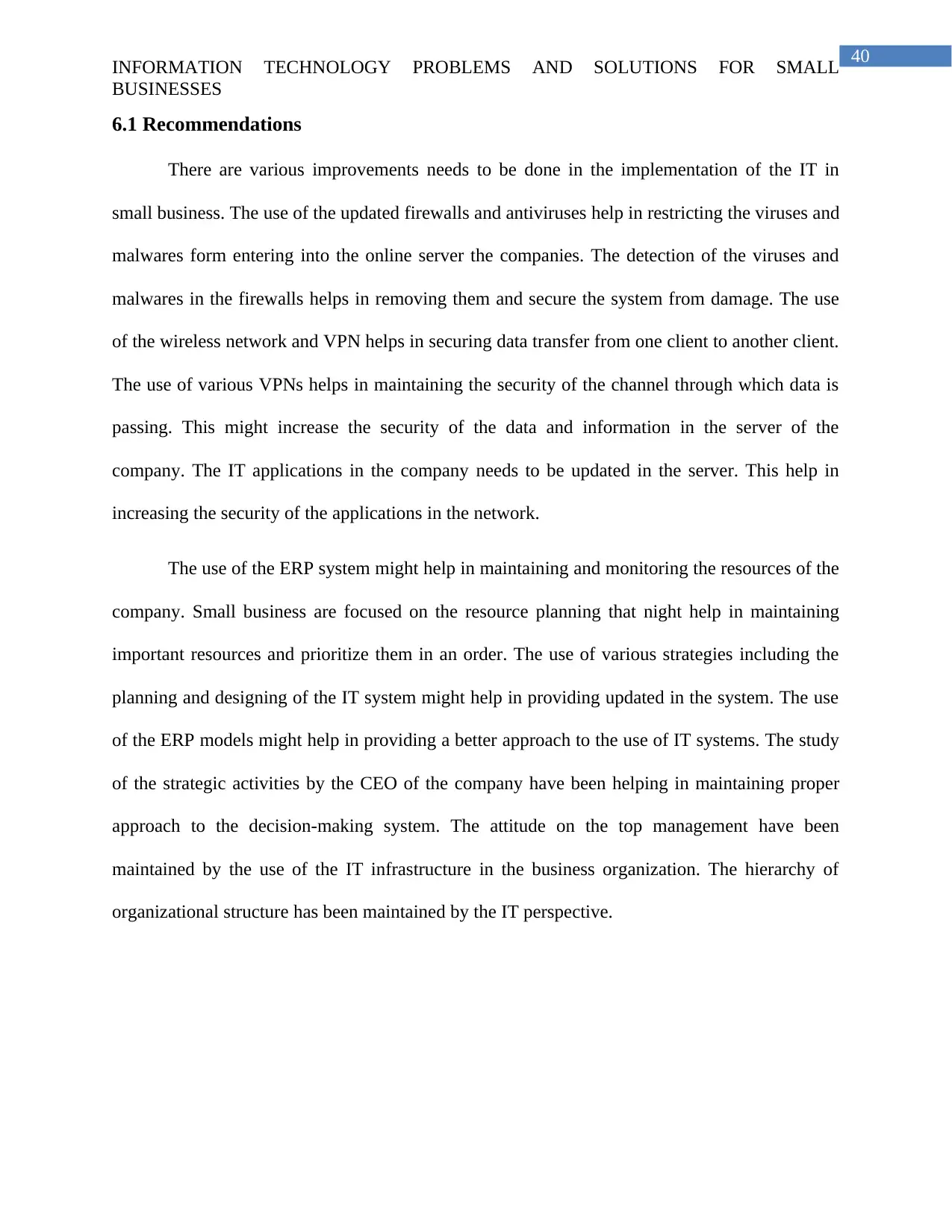
40
INFORMATION TECHNOLOGY PROBLEMS AND SOLUTIONS FOR SMALL
BUSINESSES
6.1 Recommendations
There are various improvements needs to be done in the implementation of the IT in
small business. The use of the updated firewalls and antiviruses help in restricting the viruses and
malwares form entering into the online server the companies. The detection of the viruses and
malwares in the firewalls helps in removing them and secure the system from damage. The use
of the wireless network and VPN helps in securing data transfer from one client to another client.
The use of various VPNs helps in maintaining the security of the channel through which data is
passing. This might increase the security of the data and information in the server of the
company. The IT applications in the company needs to be updated in the server. This help in
increasing the security of the applications in the network.
The use of the ERP system might help in maintaining and monitoring the resources of the
company. Small business are focused on the resource planning that night help in maintaining
important resources and prioritize them in an order. The use of various strategies including the
planning and designing of the IT system might help in providing updated in the system. The use
of the ERP models might help in providing a better approach to the use of IT systems. The study
of the strategic activities by the CEO of the company have been helping in maintaining proper
approach to the decision-making system. The attitude on the top management have been
maintained by the use of the IT infrastructure in the business organization. The hierarchy of
organizational structure has been maintained by the IT perspective.
INFORMATION TECHNOLOGY PROBLEMS AND SOLUTIONS FOR SMALL
BUSINESSES
6.1 Recommendations
There are various improvements needs to be done in the implementation of the IT in
small business. The use of the updated firewalls and antiviruses help in restricting the viruses and
malwares form entering into the online server the companies. The detection of the viruses and
malwares in the firewalls helps in removing them and secure the system from damage. The use
of the wireless network and VPN helps in securing data transfer from one client to another client.
The use of various VPNs helps in maintaining the security of the channel through which data is
passing. This might increase the security of the data and information in the server of the
company. The IT applications in the company needs to be updated in the server. This help in
increasing the security of the applications in the network.
The use of the ERP system might help in maintaining and monitoring the resources of the
company. Small business are focused on the resource planning that night help in maintaining
important resources and prioritize them in an order. The use of various strategies including the
planning and designing of the IT system might help in providing updated in the system. The use
of the ERP models might help in providing a better approach to the use of IT systems. The study
of the strategic activities by the CEO of the company have been helping in maintaining proper
approach to the decision-making system. The attitude on the top management have been
maintained by the use of the IT infrastructure in the business organization. The hierarchy of
organizational structure has been maintained by the IT perspective.
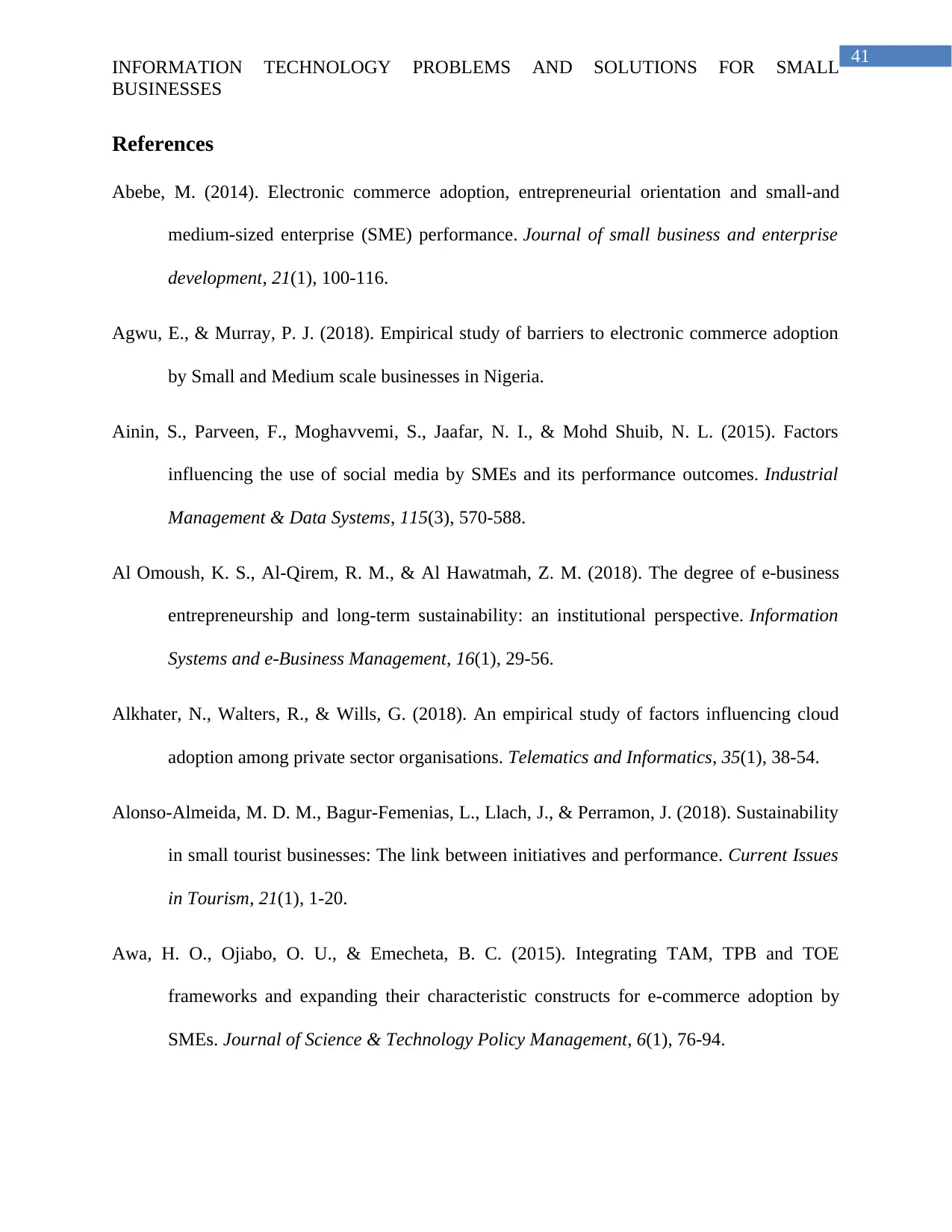
41
INFORMATION TECHNOLOGY PROBLEMS AND SOLUTIONS FOR SMALL
BUSINESSES
References
Abebe, M. (2014). Electronic commerce adoption, entrepreneurial orientation and small-and
medium-sized enterprise (SME) performance. Journal of small business and enterprise
development, 21(1), 100-116.
Agwu, E., & Murray, P. J. (2018). Empirical study of barriers to electronic commerce adoption
by Small and Medium scale businesses in Nigeria.
Ainin, S., Parveen, F., Moghavvemi, S., Jaafar, N. I., & Mohd Shuib, N. L. (2015). Factors
influencing the use of social media by SMEs and its performance outcomes. Industrial
Management & Data Systems, 115(3), 570-588.
Al Omoush, K. S., Al-Qirem, R. M., & Al Hawatmah, Z. M. (2018). The degree of e-business
entrepreneurship and long-term sustainability: an institutional perspective. Information
Systems and e-Business Management, 16(1), 29-56.
Alkhater, N., Walters, R., & Wills, G. (2018). An empirical study of factors influencing cloud
adoption among private sector organisations. Telematics and Informatics, 35(1), 38-54.
Alonso-Almeida, M. D. M., Bagur-Femenias, L., Llach, J., & Perramon, J. (2018). Sustainability
in small tourist businesses: The link between initiatives and performance. Current Issues
in Tourism, 21(1), 1-20.
Awa, H. O., Ojiabo, O. U., & Emecheta, B. C. (2015). Integrating TAM, TPB and TOE
frameworks and expanding their characteristic constructs for e-commerce adoption by
SMEs. Journal of Science & Technology Policy Management, 6(1), 76-94.
INFORMATION TECHNOLOGY PROBLEMS AND SOLUTIONS FOR SMALL
BUSINESSES
References
Abebe, M. (2014). Electronic commerce adoption, entrepreneurial orientation and small-and
medium-sized enterprise (SME) performance. Journal of small business and enterprise
development, 21(1), 100-116.
Agwu, E., & Murray, P. J. (2018). Empirical study of barriers to electronic commerce adoption
by Small and Medium scale businesses in Nigeria.
Ainin, S., Parveen, F., Moghavvemi, S., Jaafar, N. I., & Mohd Shuib, N. L. (2015). Factors
influencing the use of social media by SMEs and its performance outcomes. Industrial
Management & Data Systems, 115(3), 570-588.
Al Omoush, K. S., Al-Qirem, R. M., & Al Hawatmah, Z. M. (2018). The degree of e-business
entrepreneurship and long-term sustainability: an institutional perspective. Information
Systems and e-Business Management, 16(1), 29-56.
Alkhater, N., Walters, R., & Wills, G. (2018). An empirical study of factors influencing cloud
adoption among private sector organisations. Telematics and Informatics, 35(1), 38-54.
Alonso-Almeida, M. D. M., Bagur-Femenias, L., Llach, J., & Perramon, J. (2018). Sustainability
in small tourist businesses: The link between initiatives and performance. Current Issues
in Tourism, 21(1), 1-20.
Awa, H. O., Ojiabo, O. U., & Emecheta, B. C. (2015). Integrating TAM, TPB and TOE
frameworks and expanding their characteristic constructs for e-commerce adoption by
SMEs. Journal of Science & Technology Policy Management, 6(1), 76-94.
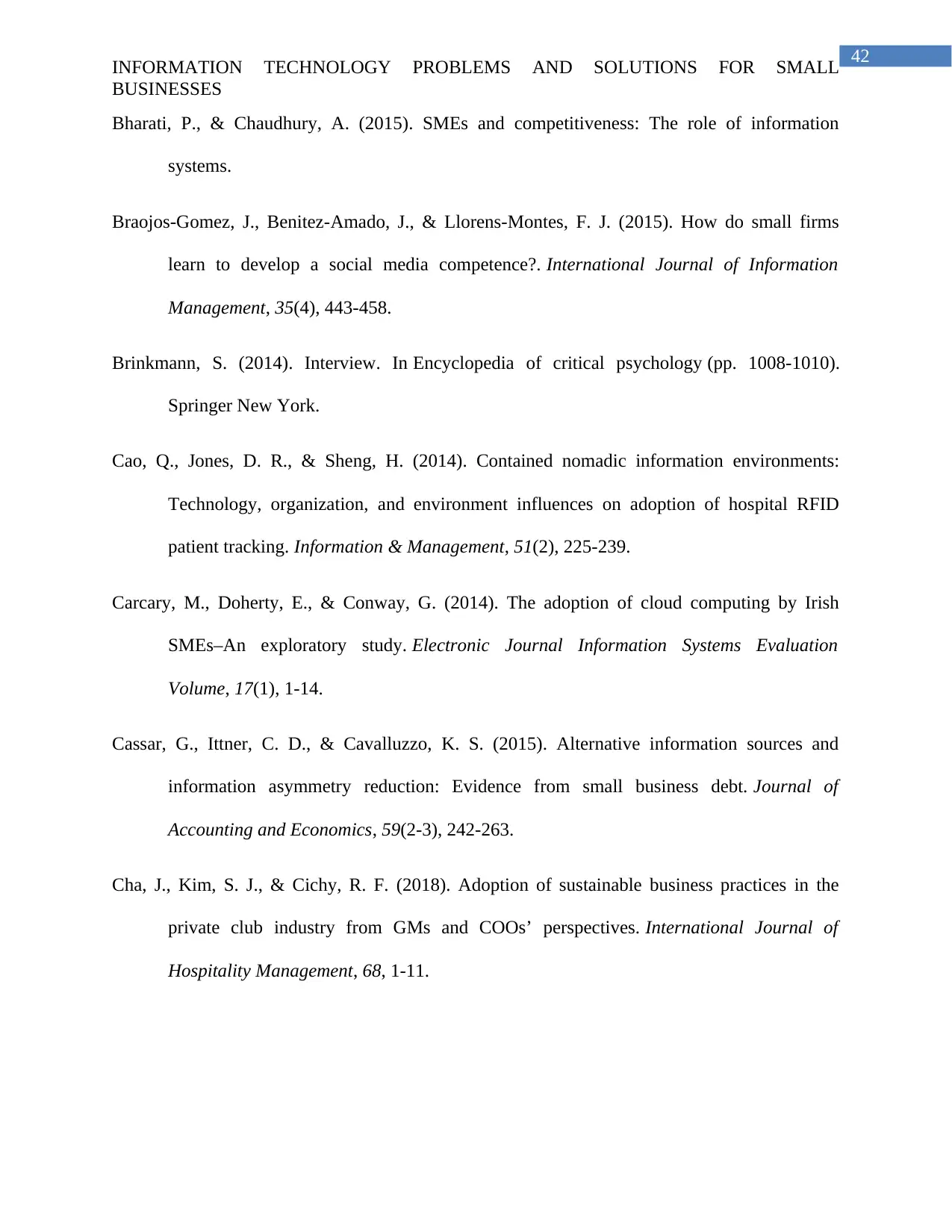
42
INFORMATION TECHNOLOGY PROBLEMS AND SOLUTIONS FOR SMALL
BUSINESSES
Bharati, P., & Chaudhury, A. (2015). SMEs and competitiveness: The role of information
systems.
Braojos-Gomez, J., Benitez-Amado, J., & Llorens-Montes, F. J. (2015). How do small firms
learn to develop a social media competence?. International Journal of Information
Management, 35(4), 443-458.
Brinkmann, S. (2014). Interview. In Encyclopedia of critical psychology (pp. 1008-1010).
Springer New York.
Cao, Q., Jones, D. R., & Sheng, H. (2014). Contained nomadic information environments:
Technology, organization, and environment influences on adoption of hospital RFID
patient tracking. Information & Management, 51(2), 225-239.
Carcary, M., Doherty, E., & Conway, G. (2014). The adoption of cloud computing by Irish
SMEs–An exploratory study. Electronic Journal Information Systems Evaluation
Volume, 17(1), 1-14.
Cassar, G., Ittner, C. D., & Cavalluzzo, K. S. (2015). Alternative information sources and
information asymmetry reduction: Evidence from small business debt. Journal of
Accounting and Economics, 59(2-3), 242-263.
Cha, J., Kim, S. J., & Cichy, R. F. (2018). Adoption of sustainable business practices in the
private club industry from GMs and COOs’ perspectives. International Journal of
Hospitality Management, 68, 1-11.
INFORMATION TECHNOLOGY PROBLEMS AND SOLUTIONS FOR SMALL
BUSINESSES
Bharati, P., & Chaudhury, A. (2015). SMEs and competitiveness: The role of information
systems.
Braojos-Gomez, J., Benitez-Amado, J., & Llorens-Montes, F. J. (2015). How do small firms
learn to develop a social media competence?. International Journal of Information
Management, 35(4), 443-458.
Brinkmann, S. (2014). Interview. In Encyclopedia of critical psychology (pp. 1008-1010).
Springer New York.
Cao, Q., Jones, D. R., & Sheng, H. (2014). Contained nomadic information environments:
Technology, organization, and environment influences on adoption of hospital RFID
patient tracking. Information & Management, 51(2), 225-239.
Carcary, M., Doherty, E., & Conway, G. (2014). The adoption of cloud computing by Irish
SMEs–An exploratory study. Electronic Journal Information Systems Evaluation
Volume, 17(1), 1-14.
Cassar, G., Ittner, C. D., & Cavalluzzo, K. S. (2015). Alternative information sources and
information asymmetry reduction: Evidence from small business debt. Journal of
Accounting and Economics, 59(2-3), 242-263.
Cha, J., Kim, S. J., & Cichy, R. F. (2018). Adoption of sustainable business practices in the
private club industry from GMs and COOs’ perspectives. International Journal of
Hospitality Management, 68, 1-11.
Paraphrase This Document
Need a fresh take? Get an instant paraphrase of this document with our AI Paraphraser
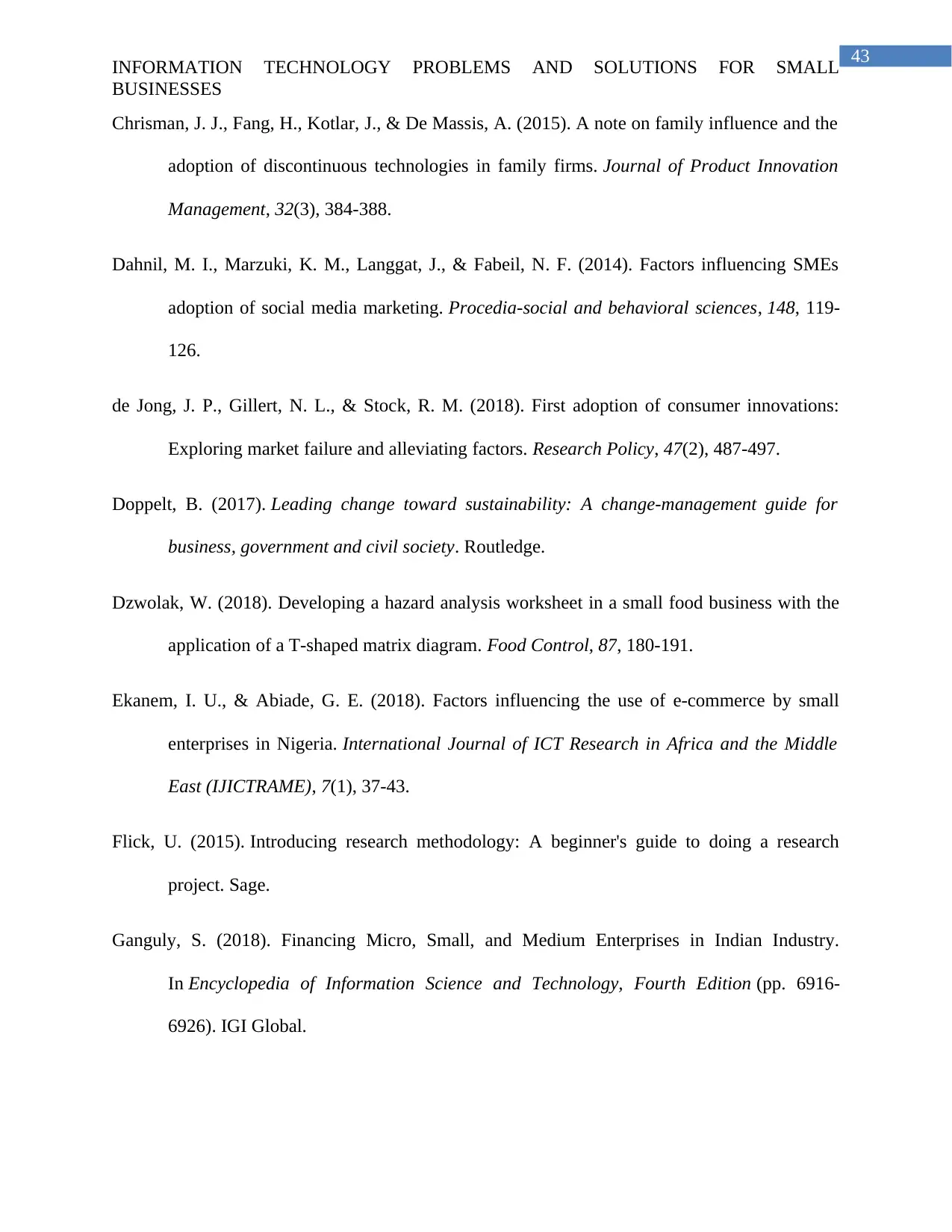
43
INFORMATION TECHNOLOGY PROBLEMS AND SOLUTIONS FOR SMALL
BUSINESSES
Chrisman, J. J., Fang, H., Kotlar, J., & De Massis, A. (2015). A note on family influence and the
adoption of discontinuous technologies in family firms. Journal of Product Innovation
Management, 32(3), 384-388.
Dahnil, M. I., Marzuki, K. M., Langgat, J., & Fabeil, N. F. (2014). Factors influencing SMEs
adoption of social media marketing. Procedia-social and behavioral sciences, 148, 119-
126.
de Jong, J. P., Gillert, N. L., & Stock, R. M. (2018). First adoption of consumer innovations:
Exploring market failure and alleviating factors. Research Policy, 47(2), 487-497.
Doppelt, B. (2017). Leading change toward sustainability: A change-management guide for
business, government and civil society. Routledge.
Dzwolak, W. (2018). Developing a hazard analysis worksheet in a small food business with the
application of a T-shaped matrix diagram. Food Control, 87, 180-191.
Ekanem, I. U., & Abiade, G. E. (2018). Factors influencing the use of e-commerce by small
enterprises in Nigeria. International Journal of ICT Research in Africa and the Middle
East (IJICTRAME), 7(1), 37-43.
Flick, U. (2015). Introducing research methodology: A beginner's guide to doing a research
project. Sage.
Ganguly, S. (2018). Financing Micro, Small, and Medium Enterprises in Indian Industry.
In Encyclopedia of Information Science and Technology, Fourth Edition (pp. 6916-
6926). IGI Global.
INFORMATION TECHNOLOGY PROBLEMS AND SOLUTIONS FOR SMALL
BUSINESSES
Chrisman, J. J., Fang, H., Kotlar, J., & De Massis, A. (2015). A note on family influence and the
adoption of discontinuous technologies in family firms. Journal of Product Innovation
Management, 32(3), 384-388.
Dahnil, M. I., Marzuki, K. M., Langgat, J., & Fabeil, N. F. (2014). Factors influencing SMEs
adoption of social media marketing. Procedia-social and behavioral sciences, 148, 119-
126.
de Jong, J. P., Gillert, N. L., & Stock, R. M. (2018). First adoption of consumer innovations:
Exploring market failure and alleviating factors. Research Policy, 47(2), 487-497.
Doppelt, B. (2017). Leading change toward sustainability: A change-management guide for
business, government and civil society. Routledge.
Dzwolak, W. (2018). Developing a hazard analysis worksheet in a small food business with the
application of a T-shaped matrix diagram. Food Control, 87, 180-191.
Ekanem, I. U., & Abiade, G. E. (2018). Factors influencing the use of e-commerce by small
enterprises in Nigeria. International Journal of ICT Research in Africa and the Middle
East (IJICTRAME), 7(1), 37-43.
Flick, U. (2015). Introducing research methodology: A beginner's guide to doing a research
project. Sage.
Ganguly, S. (2018). Financing Micro, Small, and Medium Enterprises in Indian Industry.
In Encyclopedia of Information Science and Technology, Fourth Edition (pp. 6916-
6926). IGI Global.
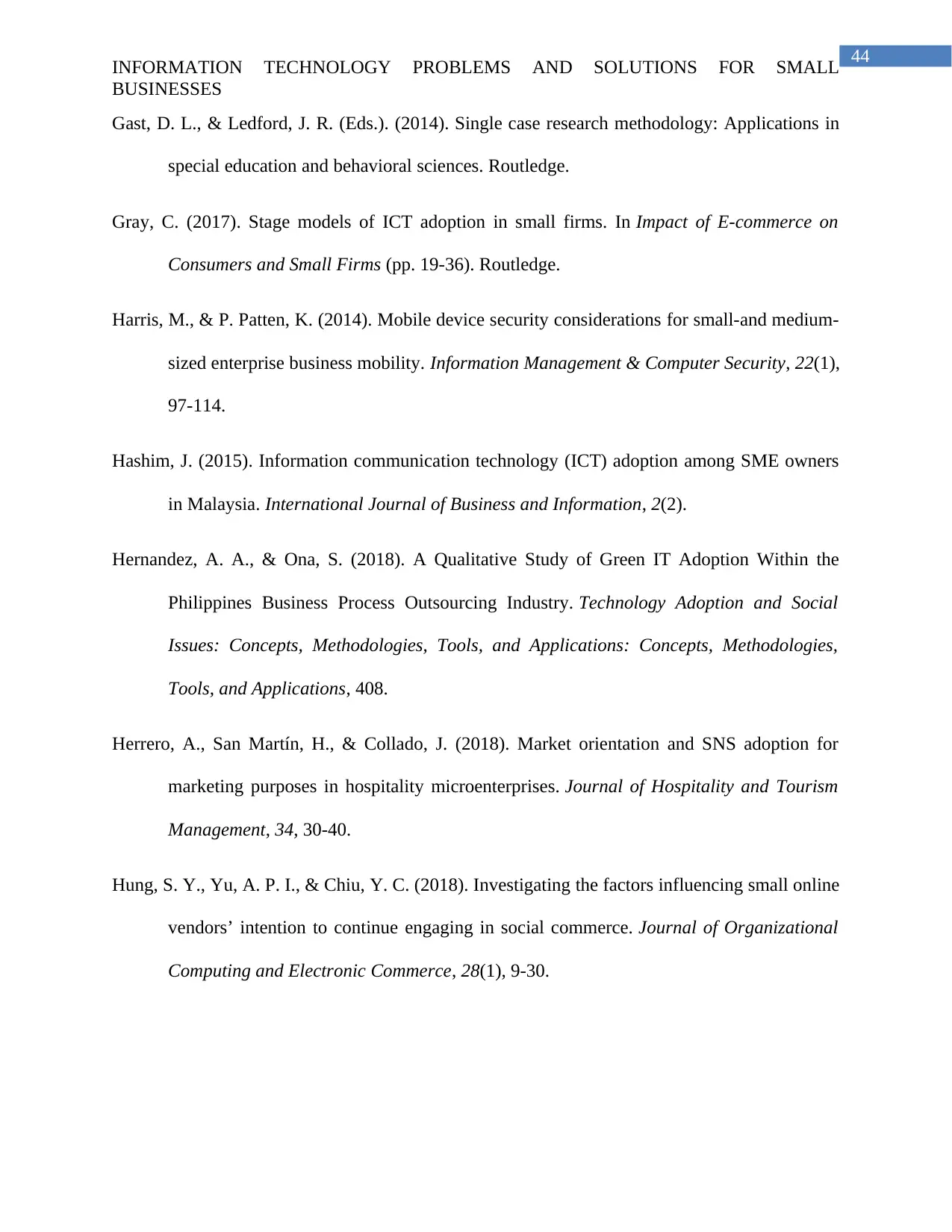
44
INFORMATION TECHNOLOGY PROBLEMS AND SOLUTIONS FOR SMALL
BUSINESSES
Gast, D. L., & Ledford, J. R. (Eds.). (2014). Single case research methodology: Applications in
special education and behavioral sciences. Routledge.
Gray, C. (2017). Stage models of ICT adoption in small firms. In Impact of E-commerce on
Consumers and Small Firms (pp. 19-36). Routledge.
Harris, M., & P. Patten, K. (2014). Mobile device security considerations for small-and medium-
sized enterprise business mobility. Information Management & Computer Security, 22(1),
97-114.
Hashim, J. (2015). Information communication technology (ICT) adoption among SME owners
in Malaysia. International Journal of Business and Information, 2(2).
Hernandez, A. A., & Ona, S. (2018). A Qualitative Study of Green IT Adoption Within the
Philippines Business Process Outsourcing Industry. Technology Adoption and Social
Issues: Concepts, Methodologies, Tools, and Applications: Concepts, Methodologies,
Tools, and Applications, 408.
Herrero, A., San Martín, H., & Collado, J. (2018). Market orientation and SNS adoption for
marketing purposes in hospitality microenterprises. Journal of Hospitality and Tourism
Management, 34, 30-40.
Hung, S. Y., Yu, A. P. I., & Chiu, Y. C. (2018). Investigating the factors influencing small online
vendors’ intention to continue engaging in social commerce. Journal of Organizational
Computing and Electronic Commerce, 28(1), 9-30.
INFORMATION TECHNOLOGY PROBLEMS AND SOLUTIONS FOR SMALL
BUSINESSES
Gast, D. L., & Ledford, J. R. (Eds.). (2014). Single case research methodology: Applications in
special education and behavioral sciences. Routledge.
Gray, C. (2017). Stage models of ICT adoption in small firms. In Impact of E-commerce on
Consumers and Small Firms (pp. 19-36). Routledge.
Harris, M., & P. Patten, K. (2014). Mobile device security considerations for small-and medium-
sized enterprise business mobility. Information Management & Computer Security, 22(1),
97-114.
Hashim, J. (2015). Information communication technology (ICT) adoption among SME owners
in Malaysia. International Journal of Business and Information, 2(2).
Hernandez, A. A., & Ona, S. (2018). A Qualitative Study of Green IT Adoption Within the
Philippines Business Process Outsourcing Industry. Technology Adoption and Social
Issues: Concepts, Methodologies, Tools, and Applications: Concepts, Methodologies,
Tools, and Applications, 408.
Herrero, A., San Martín, H., & Collado, J. (2018). Market orientation and SNS adoption for
marketing purposes in hospitality microenterprises. Journal of Hospitality and Tourism
Management, 34, 30-40.
Hung, S. Y., Yu, A. P. I., & Chiu, Y. C. (2018). Investigating the factors influencing small online
vendors’ intention to continue engaging in social commerce. Journal of Organizational
Computing and Electronic Commerce, 28(1), 9-30.
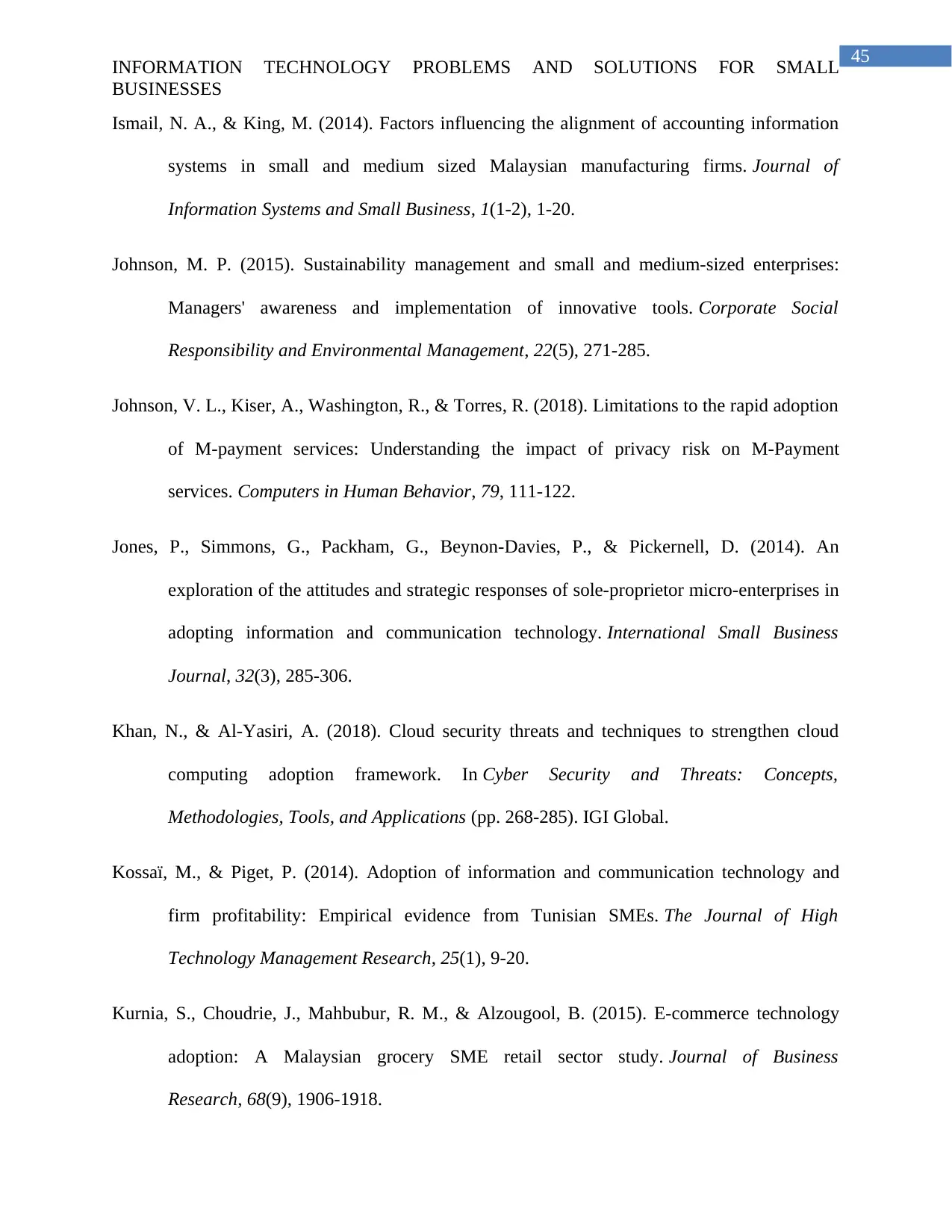
45
INFORMATION TECHNOLOGY PROBLEMS AND SOLUTIONS FOR SMALL
BUSINESSES
Ismail, N. A., & King, M. (2014). Factors influencing the alignment of accounting information
systems in small and medium sized Malaysian manufacturing firms. Journal of
Information Systems and Small Business, 1(1-2), 1-20.
Johnson, M. P. (2015). Sustainability management and small and medium‐sized enterprises:
Managers' awareness and implementation of innovative tools. Corporate Social
Responsibility and Environmental Management, 22(5), 271-285.
Johnson, V. L., Kiser, A., Washington, R., & Torres, R. (2018). Limitations to the rapid adoption
of M-payment services: Understanding the impact of privacy risk on M-Payment
services. Computers in Human Behavior, 79, 111-122.
Jones, P., Simmons, G., Packham, G., Beynon-Davies, P., & Pickernell, D. (2014). An
exploration of the attitudes and strategic responses of sole-proprietor micro-enterprises in
adopting information and communication technology. International Small Business
Journal, 32(3), 285-306.
Khan, N., & Al-Yasiri, A. (2018). Cloud security threats and techniques to strengthen cloud
computing adoption framework. In Cyber Security and Threats: Concepts,
Methodologies, Tools, and Applications (pp. 268-285). IGI Global.
Kossaï, M., & Piget, P. (2014). Adoption of information and communication technology and
firm profitability: Empirical evidence from Tunisian SMEs. The Journal of High
Technology Management Research, 25(1), 9-20.
Kurnia, S., Choudrie, J., Mahbubur, R. M., & Alzougool, B. (2015). E-commerce technology
adoption: A Malaysian grocery SME retail sector study. Journal of Business
Research, 68(9), 1906-1918.
INFORMATION TECHNOLOGY PROBLEMS AND SOLUTIONS FOR SMALL
BUSINESSES
Ismail, N. A., & King, M. (2014). Factors influencing the alignment of accounting information
systems in small and medium sized Malaysian manufacturing firms. Journal of
Information Systems and Small Business, 1(1-2), 1-20.
Johnson, M. P. (2015). Sustainability management and small and medium‐sized enterprises:
Managers' awareness and implementation of innovative tools. Corporate Social
Responsibility and Environmental Management, 22(5), 271-285.
Johnson, V. L., Kiser, A., Washington, R., & Torres, R. (2018). Limitations to the rapid adoption
of M-payment services: Understanding the impact of privacy risk on M-Payment
services. Computers in Human Behavior, 79, 111-122.
Jones, P., Simmons, G., Packham, G., Beynon-Davies, P., & Pickernell, D. (2014). An
exploration of the attitudes and strategic responses of sole-proprietor micro-enterprises in
adopting information and communication technology. International Small Business
Journal, 32(3), 285-306.
Khan, N., & Al-Yasiri, A. (2018). Cloud security threats and techniques to strengthen cloud
computing adoption framework. In Cyber Security and Threats: Concepts,
Methodologies, Tools, and Applications (pp. 268-285). IGI Global.
Kossaï, M., & Piget, P. (2014). Adoption of information and communication technology and
firm profitability: Empirical evidence from Tunisian SMEs. The Journal of High
Technology Management Research, 25(1), 9-20.
Kurnia, S., Choudrie, J., Mahbubur, R. M., & Alzougool, B. (2015). E-commerce technology
adoption: A Malaysian grocery SME retail sector study. Journal of Business
Research, 68(9), 1906-1918.
Secure Best Marks with AI Grader
Need help grading? Try our AI Grader for instant feedback on your assignments.
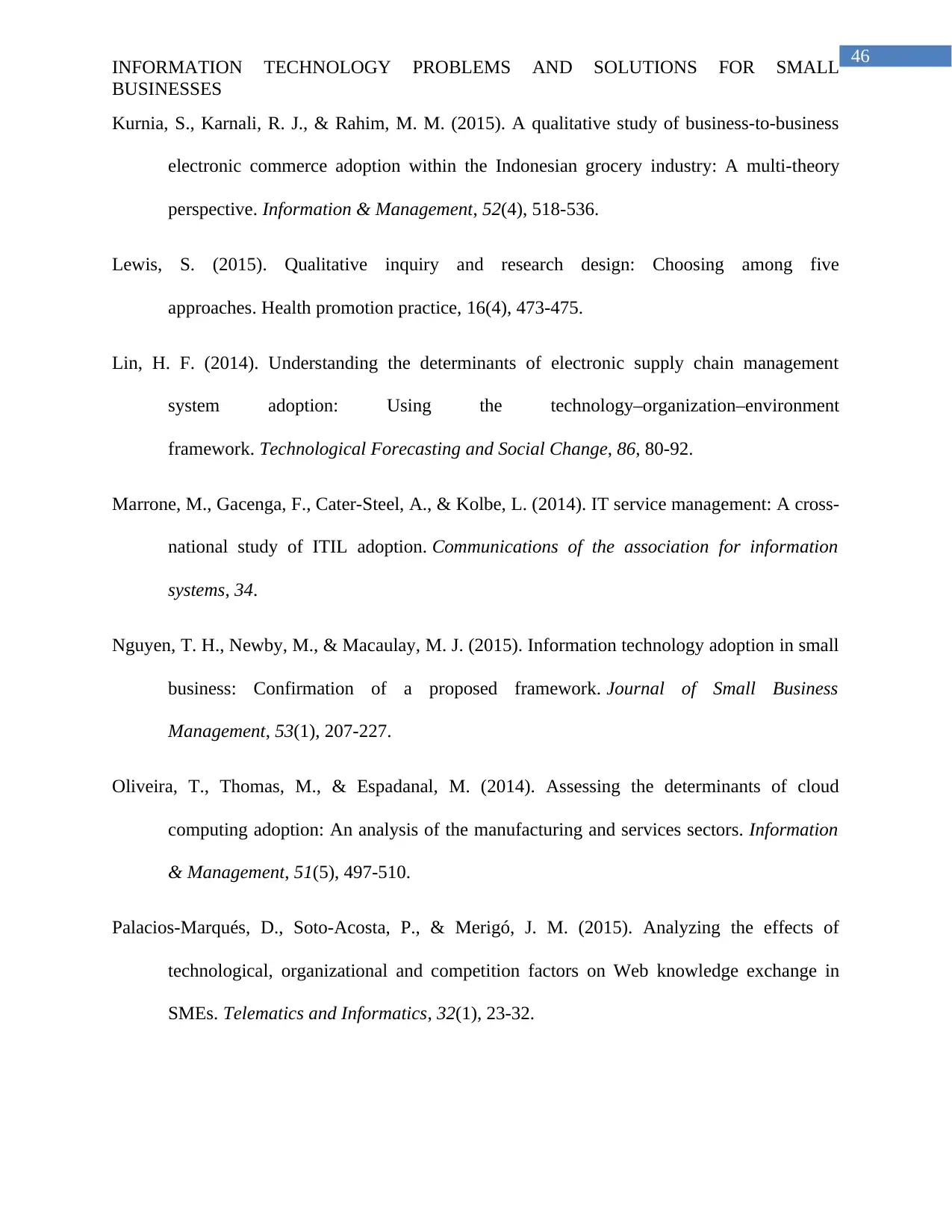
46
INFORMATION TECHNOLOGY PROBLEMS AND SOLUTIONS FOR SMALL
BUSINESSES
Kurnia, S., Karnali, R. J., & Rahim, M. M. (2015). A qualitative study of business-to-business
electronic commerce adoption within the Indonesian grocery industry: A multi-theory
perspective. Information & Management, 52(4), 518-536.
Lewis, S. (2015). Qualitative inquiry and research design: Choosing among five
approaches. Health promotion practice, 16(4), 473-475.
Lin, H. F. (2014). Understanding the determinants of electronic supply chain management
system adoption: Using the technology–organization–environment
framework. Technological Forecasting and Social Change, 86, 80-92.
Marrone, M., Gacenga, F., Cater-Steel, A., & Kolbe, L. (2014). IT service management: A cross-
national study of ITIL adoption. Communications of the association for information
systems, 34.
Nguyen, T. H., Newby, M., & Macaulay, M. J. (2015). Information technology adoption in small
business: Confirmation of a proposed framework. Journal of Small Business
Management, 53(1), 207-227.
Oliveira, T., Thomas, M., & Espadanal, M. (2014). Assessing the determinants of cloud
computing adoption: An analysis of the manufacturing and services sectors. Information
& Management, 51(5), 497-510.
Palacios-Marqués, D., Soto-Acosta, P., & Merigó, J. M. (2015). Analyzing the effects of
technological, organizational and competition factors on Web knowledge exchange in
SMEs. Telematics and Informatics, 32(1), 23-32.
INFORMATION TECHNOLOGY PROBLEMS AND SOLUTIONS FOR SMALL
BUSINESSES
Kurnia, S., Karnali, R. J., & Rahim, M. M. (2015). A qualitative study of business-to-business
electronic commerce adoption within the Indonesian grocery industry: A multi-theory
perspective. Information & Management, 52(4), 518-536.
Lewis, S. (2015). Qualitative inquiry and research design: Choosing among five
approaches. Health promotion practice, 16(4), 473-475.
Lin, H. F. (2014). Understanding the determinants of electronic supply chain management
system adoption: Using the technology–organization–environment
framework. Technological Forecasting and Social Change, 86, 80-92.
Marrone, M., Gacenga, F., Cater-Steel, A., & Kolbe, L. (2014). IT service management: A cross-
national study of ITIL adoption. Communications of the association for information
systems, 34.
Nguyen, T. H., Newby, M., & Macaulay, M. J. (2015). Information technology adoption in small
business: Confirmation of a proposed framework. Journal of Small Business
Management, 53(1), 207-227.
Oliveira, T., Thomas, M., & Espadanal, M. (2014). Assessing the determinants of cloud
computing adoption: An analysis of the manufacturing and services sectors. Information
& Management, 51(5), 497-510.
Palacios-Marqués, D., Soto-Acosta, P., & Merigó, J. M. (2015). Analyzing the effects of
technological, organizational and competition factors on Web knowledge exchange in
SMEs. Telematics and Informatics, 32(1), 23-32.
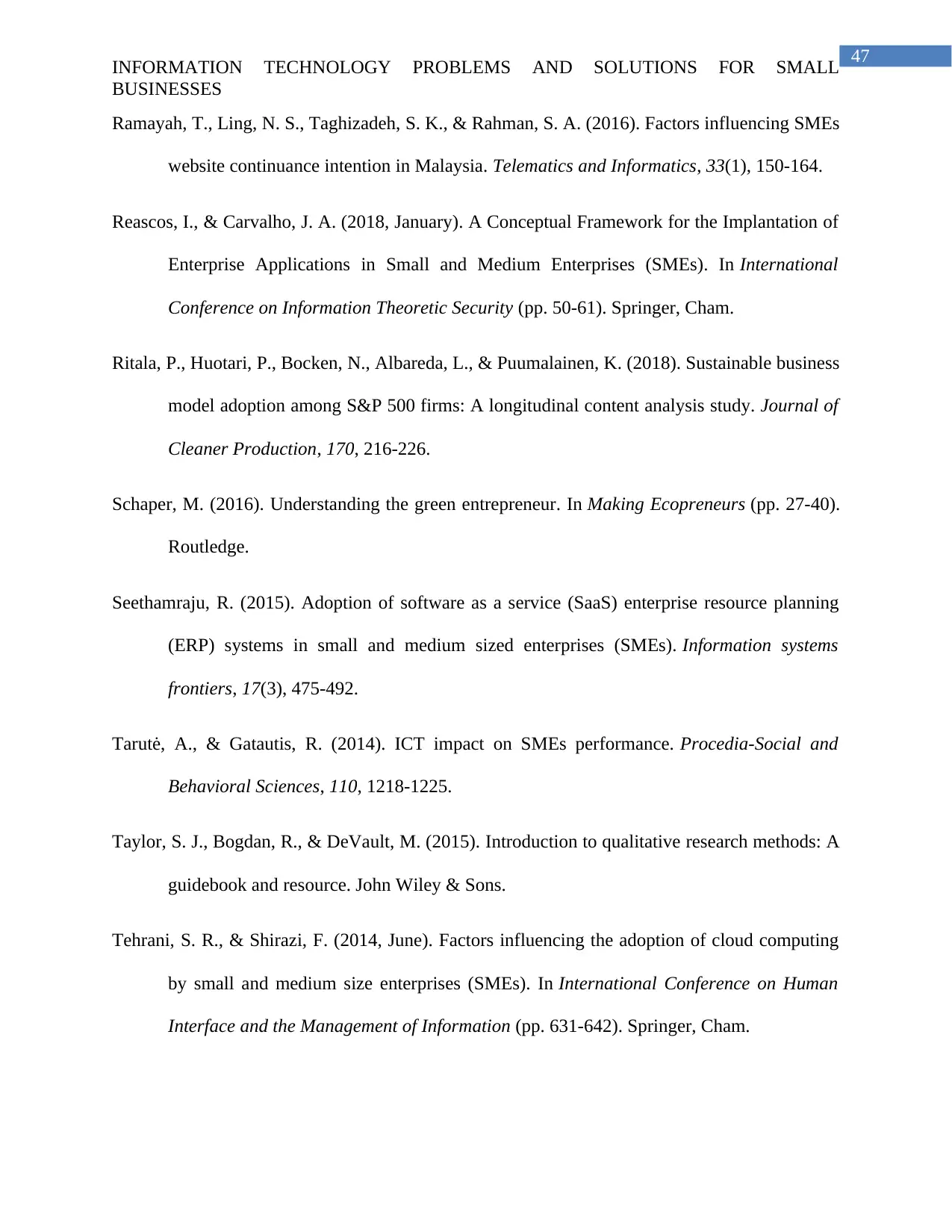
47
INFORMATION TECHNOLOGY PROBLEMS AND SOLUTIONS FOR SMALL
BUSINESSES
Ramayah, T., Ling, N. S., Taghizadeh, S. K., & Rahman, S. A. (2016). Factors influencing SMEs
website continuance intention in Malaysia. Telematics and Informatics, 33(1), 150-164.
Reascos, I., & Carvalho, J. A. (2018, January). A Conceptual Framework for the Implantation of
Enterprise Applications in Small and Medium Enterprises (SMEs). In International
Conference on Information Theoretic Security (pp. 50-61). Springer, Cham.
Ritala, P., Huotari, P., Bocken, N., Albareda, L., & Puumalainen, K. (2018). Sustainable business
model adoption among S&P 500 firms: A longitudinal content analysis study. Journal of
Cleaner Production, 170, 216-226.
Schaper, M. (2016). Understanding the green entrepreneur. In Making Ecopreneurs (pp. 27-40).
Routledge.
Seethamraju, R. (2015). Adoption of software as a service (SaaS) enterprise resource planning
(ERP) systems in small and medium sized enterprises (SMEs). Information systems
frontiers, 17(3), 475-492.
Tarutė, A., & Gatautis, R. (2014). ICT impact on SMEs performance. Procedia-Social and
Behavioral Sciences, 110, 1218-1225.
Taylor, S. J., Bogdan, R., & DeVault, M. (2015). Introduction to qualitative research methods: A
guidebook and resource. John Wiley & Sons.
Tehrani, S. R., & Shirazi, F. (2014, June). Factors influencing the adoption of cloud computing
by small and medium size enterprises (SMEs). In International Conference on Human
Interface and the Management of Information (pp. 631-642). Springer, Cham.
INFORMATION TECHNOLOGY PROBLEMS AND SOLUTIONS FOR SMALL
BUSINESSES
Ramayah, T., Ling, N. S., Taghizadeh, S. K., & Rahman, S. A. (2016). Factors influencing SMEs
website continuance intention in Malaysia. Telematics and Informatics, 33(1), 150-164.
Reascos, I., & Carvalho, J. A. (2018, January). A Conceptual Framework for the Implantation of
Enterprise Applications in Small and Medium Enterprises (SMEs). In International
Conference on Information Theoretic Security (pp. 50-61). Springer, Cham.
Ritala, P., Huotari, P., Bocken, N., Albareda, L., & Puumalainen, K. (2018). Sustainable business
model adoption among S&P 500 firms: A longitudinal content analysis study. Journal of
Cleaner Production, 170, 216-226.
Schaper, M. (2016). Understanding the green entrepreneur. In Making Ecopreneurs (pp. 27-40).
Routledge.
Seethamraju, R. (2015). Adoption of software as a service (SaaS) enterprise resource planning
(ERP) systems in small and medium sized enterprises (SMEs). Information systems
frontiers, 17(3), 475-492.
Tarutė, A., & Gatautis, R. (2014). ICT impact on SMEs performance. Procedia-Social and
Behavioral Sciences, 110, 1218-1225.
Taylor, S. J., Bogdan, R., & DeVault, M. (2015). Introduction to qualitative research methods: A
guidebook and resource. John Wiley & Sons.
Tehrani, S. R., & Shirazi, F. (2014, June). Factors influencing the adoption of cloud computing
by small and medium size enterprises (SMEs). In International Conference on Human
Interface and the Management of Information (pp. 631-642). Springer, Cham.
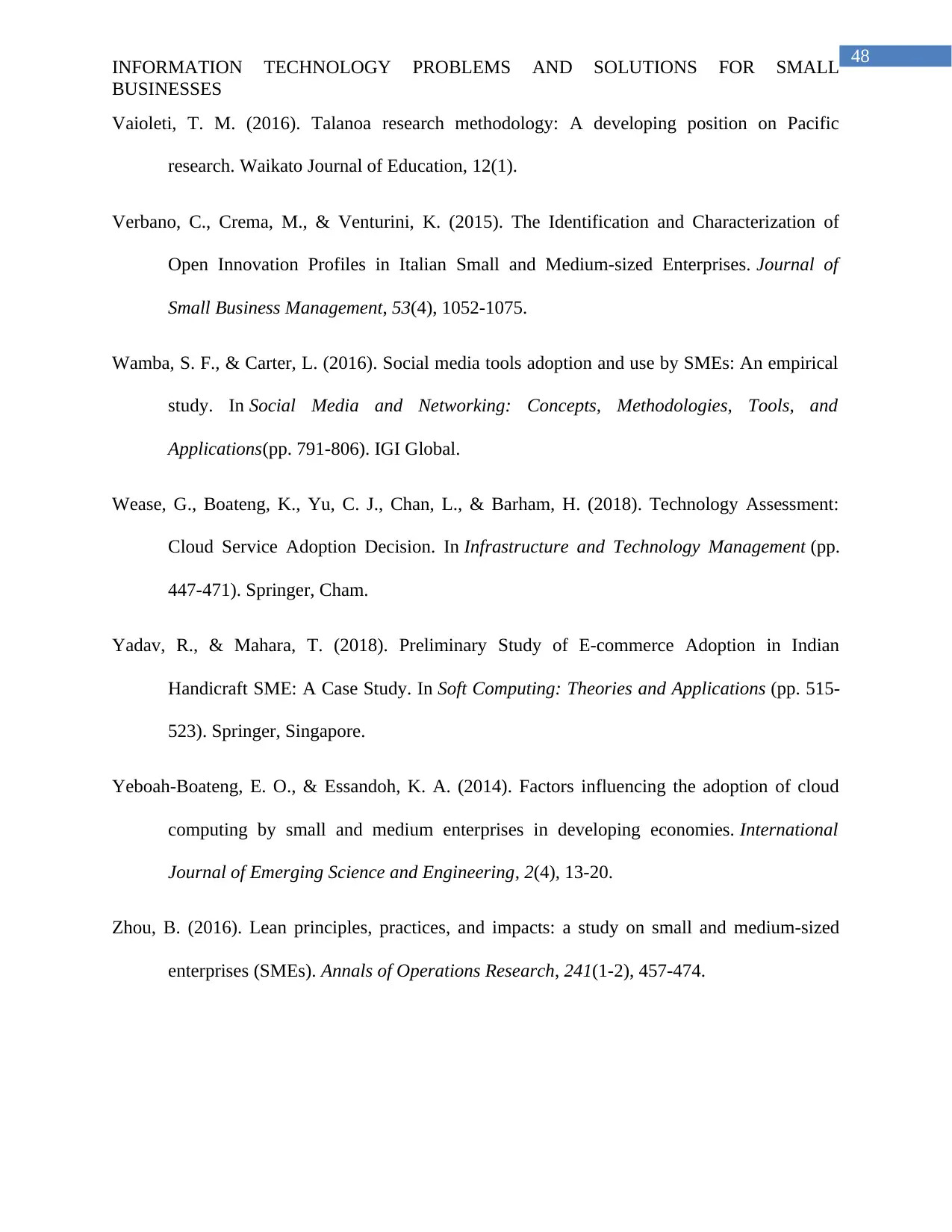
48
INFORMATION TECHNOLOGY PROBLEMS AND SOLUTIONS FOR SMALL
BUSINESSES
Vaioleti, T. M. (2016). Talanoa research methodology: A developing position on Pacific
research. Waikato Journal of Education, 12(1).
Verbano, C., Crema, M., & Venturini, K. (2015). The Identification and Characterization of
Open Innovation Profiles in Italian Small and Medium‐sized Enterprises. Journal of
Small Business Management, 53(4), 1052-1075.
Wamba, S. F., & Carter, L. (2016). Social media tools adoption and use by SMEs: An empirical
study. In Social Media and Networking: Concepts, Methodologies, Tools, and
Applications(pp. 791-806). IGI Global.
Wease, G., Boateng, K., Yu, C. J., Chan, L., & Barham, H. (2018). Technology Assessment:
Cloud Service Adoption Decision. In Infrastructure and Technology Management (pp.
447-471). Springer, Cham.
Yadav, R., & Mahara, T. (2018). Preliminary Study of E-commerce Adoption in Indian
Handicraft SME: A Case Study. In Soft Computing: Theories and Applications (pp. 515-
523). Springer, Singapore.
Yeboah-Boateng, E. O., & Essandoh, K. A. (2014). Factors influencing the adoption of cloud
computing by small and medium enterprises in developing economies. International
Journal of Emerging Science and Engineering, 2(4), 13-20.
Zhou, B. (2016). Lean principles, practices, and impacts: a study on small and medium-sized
enterprises (SMEs). Annals of Operations Research, 241(1-2), 457-474.
INFORMATION TECHNOLOGY PROBLEMS AND SOLUTIONS FOR SMALL
BUSINESSES
Vaioleti, T. M. (2016). Talanoa research methodology: A developing position on Pacific
research. Waikato Journal of Education, 12(1).
Verbano, C., Crema, M., & Venturini, K. (2015). The Identification and Characterization of
Open Innovation Profiles in Italian Small and Medium‐sized Enterprises. Journal of
Small Business Management, 53(4), 1052-1075.
Wamba, S. F., & Carter, L. (2016). Social media tools adoption and use by SMEs: An empirical
study. In Social Media and Networking: Concepts, Methodologies, Tools, and
Applications(pp. 791-806). IGI Global.
Wease, G., Boateng, K., Yu, C. J., Chan, L., & Barham, H. (2018). Technology Assessment:
Cloud Service Adoption Decision. In Infrastructure and Technology Management (pp.
447-471). Springer, Cham.
Yadav, R., & Mahara, T. (2018). Preliminary Study of E-commerce Adoption in Indian
Handicraft SME: A Case Study. In Soft Computing: Theories and Applications (pp. 515-
523). Springer, Singapore.
Yeboah-Boateng, E. O., & Essandoh, K. A. (2014). Factors influencing the adoption of cloud
computing by small and medium enterprises in developing economies. International
Journal of Emerging Science and Engineering, 2(4), 13-20.
Zhou, B. (2016). Lean principles, practices, and impacts: a study on small and medium-sized
enterprises (SMEs). Annals of Operations Research, 241(1-2), 457-474.
1 out of 49
Related Documents
Your All-in-One AI-Powered Toolkit for Academic Success.
+13062052269
info@desklib.com
Available 24*7 on WhatsApp / Email
![[object Object]](/_next/static/media/star-bottom.7253800d.svg)
Unlock your academic potential
© 2024 | Zucol Services PVT LTD | All rights reserved.





